SUMMER GETAWAY IDEAS?
New! Find answers in a flash with Scout, our friendly AI chat otter.
BEST WEEK EVER
Try out unlimited access with 7 days of Outside+ for free.
Start Your Free Trial


Hiking the Tour du Mont Blanc: A Beginner’s Guide
Starting and finishing in the storied alpine town of Chamonix, France, the TMB circles Mont Blanc. This hundred-mile trail is one of the world’s most stunning—and definitely one of its most entertaining.
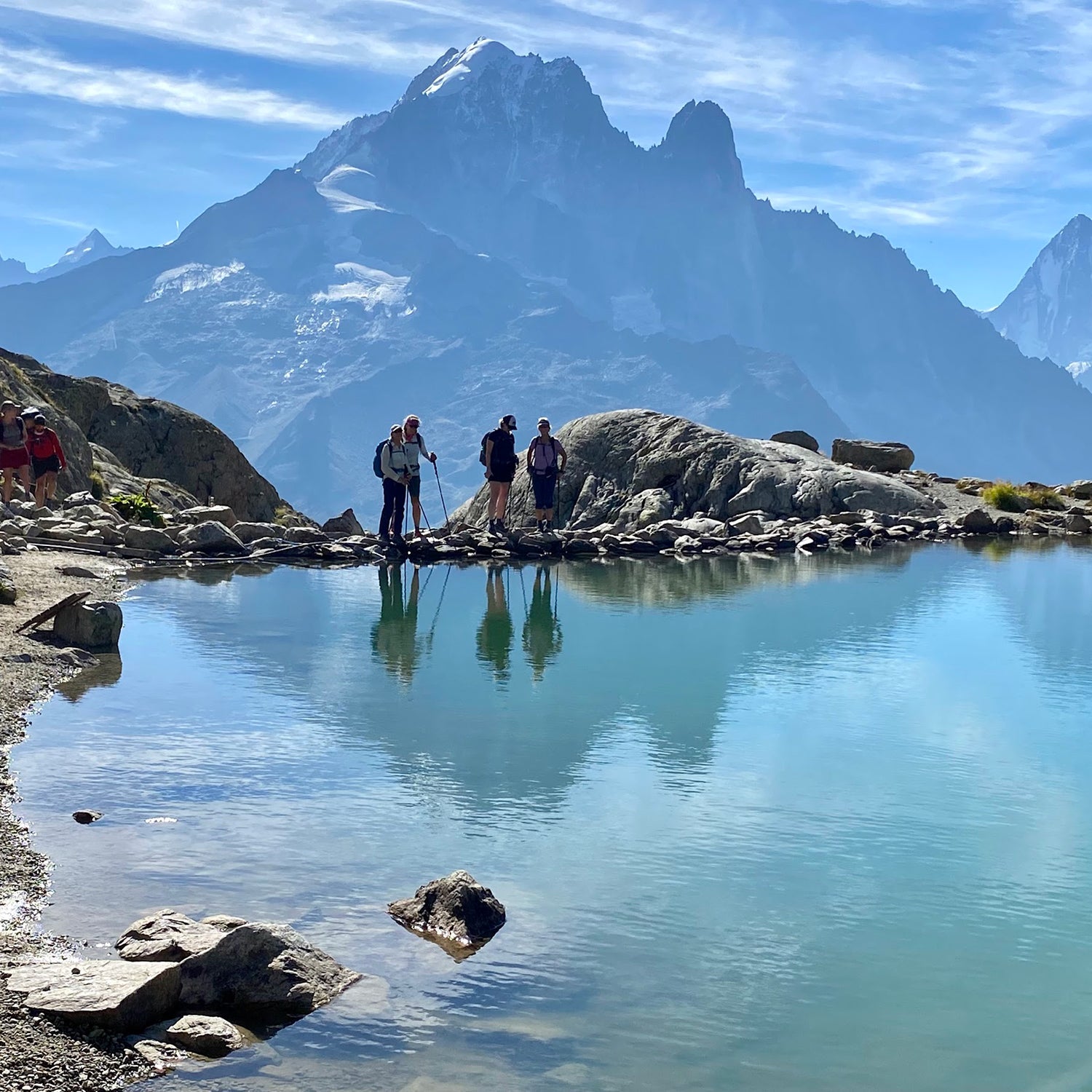
Heading out the door? Read this article on the Outside app available now on iOS devices for members! >","name":"in-content-cta","type":"link"}}'>Download the app .
This trek has it all: three countries, endless views of Western Europe’s highest peak—15,771-foot Mont Blanc—fresh-baked treats at high huts you stay in along the way, and views of climbers clinging to improbable spires. While downright decadent at times, thanks to the gourmet food and drink en route, the Tour du Mont-Blanc, 103 miles of hiking that circles Mont Blanc and passes through France, Italy, and Switzerland, is no pushover. It comprises more than 32,000 feet of uphill hiking and descending. It offers gorgeous stretches of warm, summer Alps weather, yet full-on big-mountain storms can still descend on trekkers.

The Beautiful Mount Blanc Region
The Mont Blanc region of the Alps is huge, encompassing 155 square miles, with 60 square miles of glaciers and eleven summits over 13,000 feet. Ten thousand years ago, nomadic tribes gathered here, living off deer and chamois on the land and fish from the rivers. In time, they began herding animals, moving them to higher pastures in the summer, creating the annual Alpine rhythm called transhumance that persists to this day. Those paths created an intertwined network of trails around the massif. In the last 60 years, local communities worked on the ancient routes, upgrading them for modern use by active travelers. In the 1960s, old huts were updated, inns sprang up in the valleys, and the TMB took on its present form.
Starting and finishing in the adventure-crazed alpine town of Chamonix, France, at the base of Mont Blanc, the TMB is perhaps the world’s most famous pedestrian loop and definitely one of its most entertaining, passing through three countries and the resulting variety of cultures. Along with the lively hut scene, Michelin-star dining options en route, and stop-dead-in-your-tracks views, you may also see the world’s best trail runners breezing past.
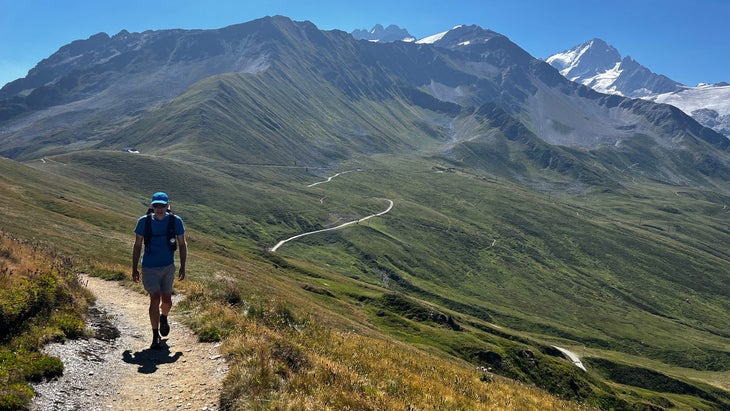
Getting to Know the Tour du Mont Blanc
I began hiking and trail running the Tour du Mont-Blanc 15 years ago in sections—a day here, two days there. It wasn’t until seven years ago that I did the full loop in one continuous push. It was September 1, 2017, and 2,200 fellow trail runners joined me in the 14th edition of the iconic Ultra-Trail du Mont-Blanc, or UTMB. Held each year at the end of August and easily the world’s most famous trail race, UTMB is one part of the reason the TMB (walking version) has become so popular.
I’ve lived in Chamonix full-time for five years, spending five summers here before that, and founded and am part-owner of the trail-running tour company Run the Alps. The UTMB race is intense. Far more typical is the leisurely eight-day TMB hike I took with my two brothers and a cousin last September. My relatives booked a total of 11 days for the trip, which included their arrival and departure days, a day in Chamonix to adjust to Central European Time, and a rest day in Courmayeur.

We meandered around the range, napping in alpine meadows, chatting with shepherds, and snarfing up lunches at huts and inns all along the way. We started around 8:30 each morning, right after the continental breakfasts, and dropped our bags with the hotel for the pre-arranged transport to the next destination. (Pro tip: Skipping the baggage transfer to save money is a dubious trade-off. You do not want to lug the extra weight over the high passes.) With an organized start time, we’d arrive at our next destination mid-afternoon, usually in time for a shower, a post-hike beer, and a nap before dinner. Our weather was perfect: blue skies, temperatures in the 60s, and a light breeze, day after day.
I’ve hiked or run the TMB a dozen times now, and here’s my advice for beginners on how to do it right.
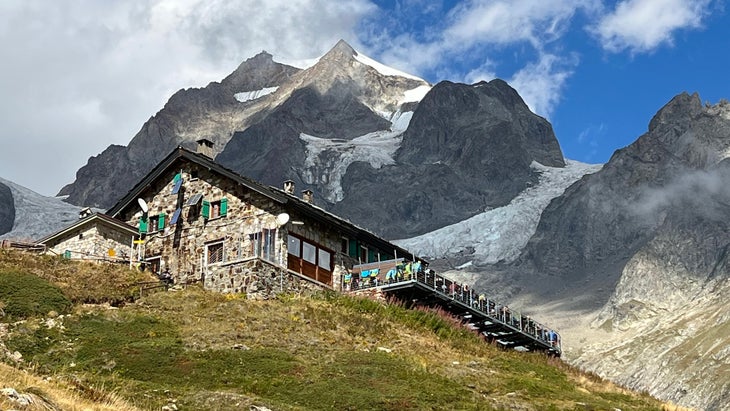
Tour du Mont Blanc Guide – Quick Links
How to get to the TMB | How Hard is it to Hike the TMB? | How Long Does it Take to Hike the TMB? | The Best Time of the Year to Hike the TMB | How to Book Your TMB Trip | Is the Trail Easy to Follow? | Lodging Options Along the TMB | Should I Plan My Own Trip or Go With A Guide? | Do I Have to Hike the Whole TMB Trail? | What to Pack to Hike the TMB | TMB Etiquette | The Best Piece of Advice of All | Resources
1) How to Get to the TMB
Nearly all TMB travelers fly in and out of Geneva, Switzerland, which is just about 90 minutes from Chamonix, the traditional start and end point of the loop. There are multiple shared shuttle services, which typically cost about €35 and should be scheduled in advance. At Run the Alps, we use Mountain Dropoffs. They’re reliable, they track your flight, and their drivers are well trained and always courteous.
2) How Hard Is It to Hike the TMB?
Most fit hikers will find the TMB to be within their abilities, especially if they opt for a luggage transport service between huts and hotels, leaving them to hike with light daypacks. But the trail is a big undertaking and can be challenging.
The longest day is usually about 20 miles, with roughly 4,500 feet of climbing and descending. Most days total around 15 miles, with between 4,000 and 5,000 feet of climbing. The highest point you’ll reach is 8,323 feet, and you work naturally up to it, so altitude is generally a non-issue, though concern about it is a common misconception about the TMB.
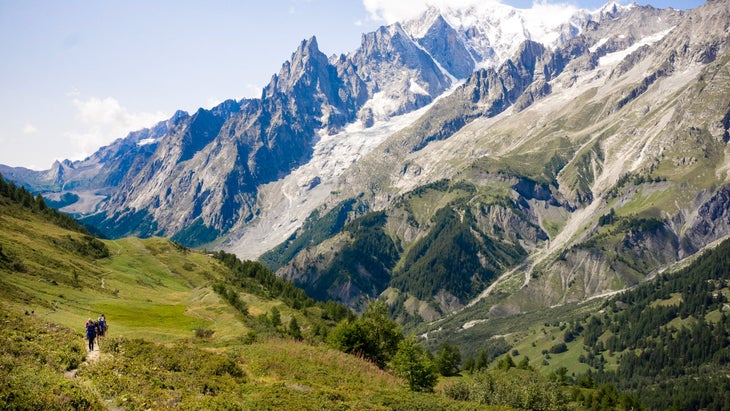
A lot of hikers and trail runners will find the TMB to have a good bit of “vert” (vertical gain) along the route. There are almost no truly flat sections, and depending on how you plan your route, you can do up to or even more than 33,000 feet of climbing during the trip. To train beforehand, find a nearby hill, get the pack you intend to use, load it up, and head uphill. If your local terrain doesn’t lend itself to TMB training, sign up for a few months at a gym with treadmills that go up to a 20 percent incline, and start hiking, doing your best to ignore the looks of gym rats when they see your pack on your back.
Old-school hiking boots are fine but, increasingly, TMB hikers are switching to sturdy trail-running shoes, from brands like Hoka, Salomon, or Merrell. No matter what you bring, wear them in well in advance—which means a few weeks of daily use, then at least a half dozen hikes, to make sure they are broken in and fit comfortably.
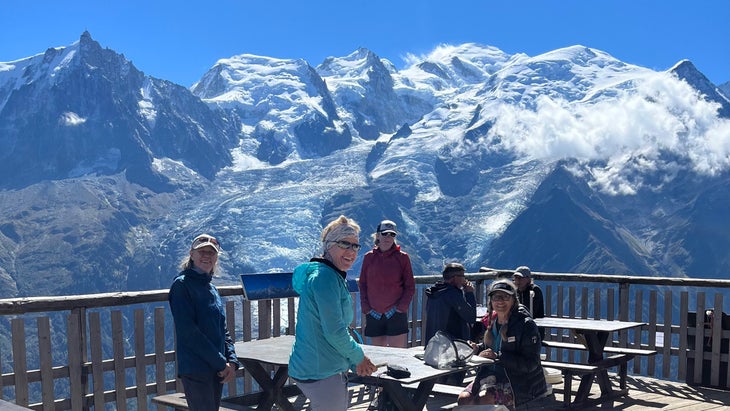
3) How Long Does It Take to Hike the TMB?
Depending on your jet-lag coping skills and your interest in rest days, plan on anywhere from a week to 12 days. The TMB breaks down nicely into village-based stops, and the most common itinerary looks something like this: Chamonix, France (add a rest day in for the day after you arrive); Les Contamines, France; Les Chapieux, France; Courmayeur, Italy (add a rest day in here); La Fouly, Switzerland; Champex-Lac, Switzerland; Trient, Switzerland; back to Chamonix (add in a rest day or two here before flying out). Bingo, that’s the loop.
4) The Best Time of Year to Hike the TMB
Be forewarned: midsummer is busy. The trail is getting popular. Even before COVID, there was a notable uptick in TMB usage, and last summer saw by far the biggest visitor numbers yet. An estimated 200,000 hikers, mountain bikers, and trail runners travel some sections of the TMB each year.
As of now, no permit is required to hike it, but you do have to book huts and hotels. The regional government has been talking with several nature reserves through which the TMB passes about implementing a permit system. Initially, at least, these permits would be both free and unlimited. The goal is to use the registration process to educate guests and track user numbers better—and hopefully to mitigate crowds.
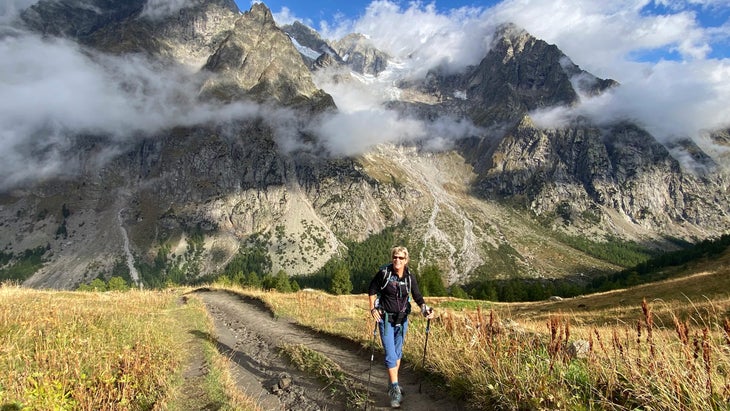
As a result of the surge in use, the gens du pays— the local people who live and work along the TMB—are scrambling 24/7 during July and August. If you must go then, you’ll need to plan well in advance to secure bookings and will pay top dollar. Many tour operators stop taking midsummer reservations for the TMB by mid-winter.
If you have a flexible schedule, I’d suggest booking during the second half of June, or after the UTMB race at the end of August, when things quiet down again.
In the shoulder seasons of June and September, bookings will be easier and refuge staff will have more time to visit with guests and perhaps even share a beer. On the front end of the shoulder season, the last two weeks of June, high passes might still be holding onto their snowfields, and you’ll need to use caution if the slopes are frozen solid. Bring hiking poles with carbide tips and microspikes for traction, and always check conditions locally with tourist offices before striking off.
The September shoulder season is arguably better, thanks to snow-free passes and good odds of blue skies. Most refuges and public transportation are open and running until about mid-September. This late season on the TMB is a wonderful time, with fewer crowds and a bit more wildness. Warmer gear is a must, though, as nighttime temperatures drop to the 50s and lower, and be aware that snowstorms might shut down travel for a day.
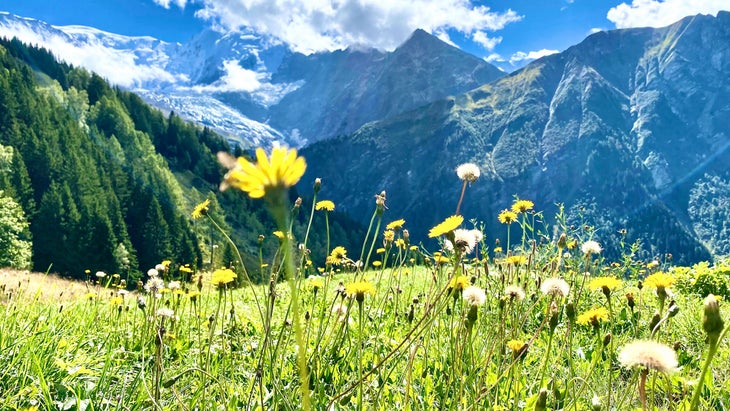
July and August are the high season. If that’s your vacation window, booking a year ahead will help you get the hotel you want. (Pro tip: Ask your hotel to pack a bag lunch for you the night before, so you can enjoy lunch from a quiet pasture, rather than waiting to place an order with overworked hut staff.) Huts usually don’t allow picnicking at their facilities, but if you pass by before or after the lunch rush, you can always enjoy a cafe au lait with the view.
Even if it’s busy, it’s still the TMB. If you don’t mind sharing vistas with fellow travelers, the fundamentals are pretty darned spectacular. You’ll need a thesaurus when texting home, because hackneyed travel adjectives like spectacular, stunning, amazing, and jaw-dropping will all sneak into your writing. For once, they won’t be overstatements.
5) How to Book Your TMB Trip
You can set up the whole circumnavigation yourself, go with a guide, or use a tour operator to book everything in advance for you. Whatever you choose, set things up as far ahead as possible. “You need to be planning 10 months in advance to secure space if you want to get into all the hard-to-book places,” says Troy Haines, owner of Alpinehikers, a guided and self-guided hiking tour operator that has been leading trips on the TMB for two decades.
There is good news, though, for those with an open approach. “Being flexible in your thinking really helps,” says Haines. “If you have a range of dates that work, or are happy with a dorm one night or a fourth-choice hotel, or even taking a taxi to a nearby village, then there is almost always something we can do to put together a trip.”
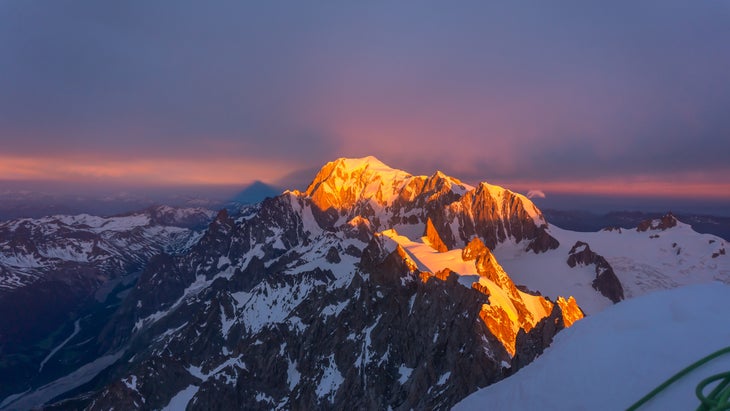
If you’re planning your own TMB hike and working on the logistics in late winter or spring for the coming summer, you may need to get creative in at least one overnight destination and possibly several. Look for hotels and inns in adjacent villages, and schedule Taxi Besson, a service that gives hikers rides to and from trails, to meet you at a specific location and time and return you to the trek the following morning. Places that traditionally get booked out along the trail include: Les Chapieux, France, and La Fouly and Trient, Switzerland. Instead, taxis can take you to the Savoie town of Bourg St. Maurice or quiet, atmospheric villages like Beaufort or Arêches. If La Fouly is full, take the Swiss Post bus to Orsieres and then Champex-Lac, skipping ahead a day. If Trient is full, look to Finhaut, Switzerland, or Vallorcine, France. Consider the switch-ups an adventure, and a chance to explore villages a bit farther afield.
6) Is the TMB Trail Easy to Follow?
Whenever you go, the TMB is one of the easiest trails in the world to follow. No matter whether you’re hiking in France, Italy, or Switzerland, the signage is clear, with distances marked. (Predictably, Switzerland wins for best and most accurate signs.) Many junctions are named, with elevations shown on the signposts. The TMB trail itself is well-worn, so even if visibility is poor, you should have no problem staying en route.
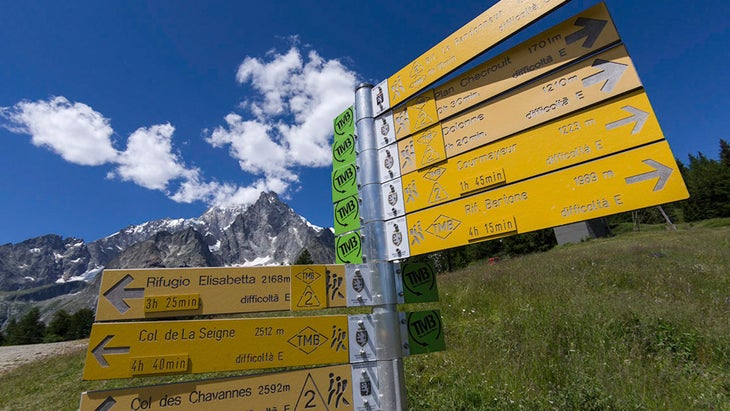
7) Lodging Options Along the TMB
There may be no multi-day trek in the world that offers such an array of overnight options. Some guests are rolling out sleeping bag liners in shared dorm space, while others are sipping pricey Burgundy wines amid the five-star, red-carpet treatment at high-end hotels in Chamonix, Courmayeur, and Champex-Lac. (See the Resources section below for my favorite hotel options along the route.)
For those looking for a sky filled with thousands of stars, camping is an option, but with the recent proliferation of tents popping up around the range, it’s increasingly frowned upon by many of the guides on the trail and staff at nearby huts. If you want to camp, follow good Leave No Trace practices and be as unobtrusive as possible. Regulations vary widely along the TMB. Camping is usually permitted outside of nature refuges after sunset and before sunrise. If you’re overnighting near a hut, drop in during the afternoon and ask permission of the hut caretaker or guardian. Commercial camping businesses exist in all of the key towns around the TMB. Because of the convenient alpine villages sprinkled around the route, however, the TMB is a great choice for anyone who wants to leave the tent and camp stove at home.
Because the TMB passes through three countries, camping regulations along the trail vary. Below is a quick overview of the regulations.
In France, camping is allowed under the following conditions:
- In the proximity of a refuge, with the permission of the guardian.
- Outside of the Contamines nature reserve, you can pitch a tent between sunset and sunrise (7 P.M. – 9 A.M.). In the Contamines nature reserve, you must pitch your tent in the designated area near the Refuge de la Balme.
- Camping is not allowed under 2500m of altitude.
- In the Val Veny and Val Ferret zones, camping is only allowed in a designated campsite.
In Switzerland:
- Camping is allowed above tree level, but not within nature reserves.
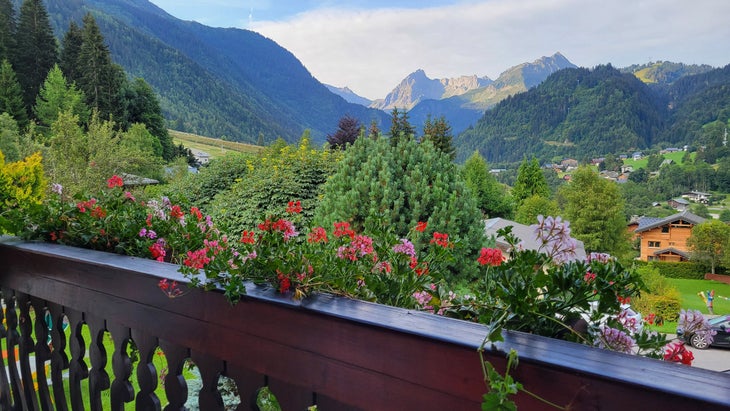
8) Should I Plan My Own Trip (DIY), Self-Guide, or Go With a Guide?
If you’re a planner, the TMB is made for you. You’ll get to cruise around on hotel websites in three countries, poring over photos of standard, superior, and deluxe rooms.
Stephanie Lefferts, the tour manager at my company, Run the Alps, who works with more than fifty hotels, has three tips for DIYers:
- Book directly through a hotel’s website, if possible. You’ll often get a better rate and terms, and more money goes to the hotels, which are often family run.
- When in doubt, go for the half-board option, which includes dinner. As Lefferts points out, “It’s really nice to walk downstairs for dinner after a long day on the trail and not have to wander the town searching for somewhere to eat.”
- You guessed it: “Book early!”
Over the years, a number of planning sites have emerged for the DIYer–see our suggestions below and grab a copy of the venerable TMB bible, Trekking the Tour du Mont Blanc by Kev Reynolds. The most recent edition was released in 2020. Be sure to get the IGN Tour du Mont-Blanc map as well.
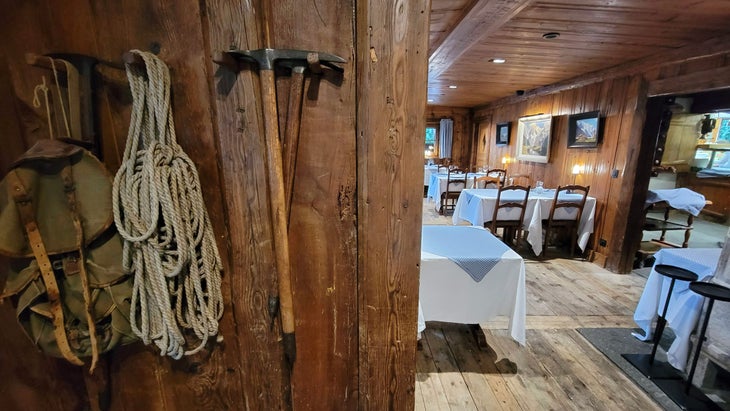
B) Find an Outfitter Who Sets Up Self-Guided Trips
This means that a company will book everything for you in advance so that all you have to do is show up and hike. Most TMB outfitters know the better inns and hotels along the route. And if you need to spend a night off the trail, they’ll schedule taxi transport for you. You’ll also get route descriptions for each day along with supporting materials that can save hassle and confusion. Most companies will also arrange for transport to and from the airport and baggage transfer during your hiking days.
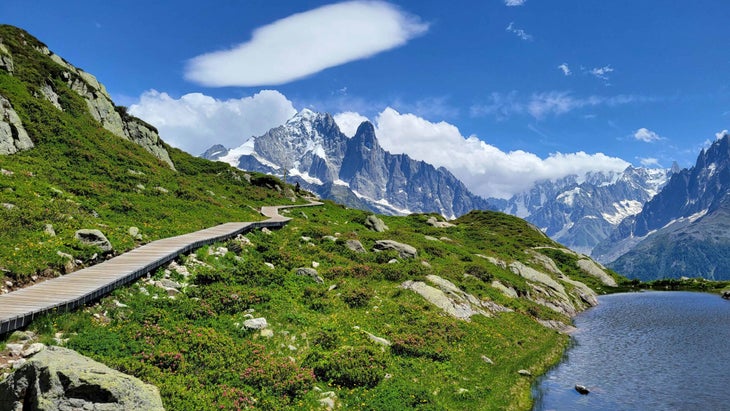
C) Go With a Guide
In the Alps, so-called “middle mountain” guides (meaning hiking rather than climbing guides) are a common sight, leading hikers and trail runners along paths throughout the region. The English designation is called IML, for International Mountain Leader. In French, it’s accompagnateur for a male guide and accompagnatrice for a woman. Guides in the Alps go through a rigorous training and testing process, and their knowledge runs deep on topics from mountain safety to flora and fauna to local customs and more. The additional cost of going on a guided trip can be well worth it, particularly if you’re busy and would like to just show up and follow a competent and friendly leader.
If you’re going on a guided trip, be sure to confirm that your company uses only licensed guides. Mountain police, Europe’s equivalent of a forest ranger toting a police badge, often check a guide’s paperwork, and more than one hapless group has had its TMB trip stalled by the presence of non-licensed guides.
If you use a commercial company for either a guided or self-guided tour, remember that not all companies offer the same tier of service. The cost difference can be thousands of dollars, and your overnight accommodations might range from a stuffy dorm room to a 600-thread-count king-sized bed with a mountain-view terrace. Read the fine print carefully to see what costs are covered, and if items like airport shuttles and in-country transport are included on your way back.
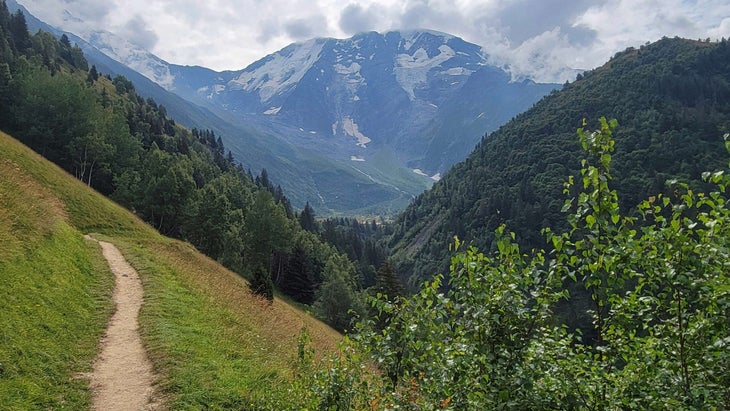
9) Do I Have to Hike the Whole TMB?
The TMB is well set up for hikers with limited time. Transportation around the region is relatively straightforward. There are multiple buses each day between Chamonix and Courmayeur through the Mont Blanc tunnel, and France’s SNCF passenger trains coordinate with Switzerland’s SBB rail system, which in turn dovetails with the country’s Postbus system. All of which means, getting around is easy. If you’re short on time, try some day hikes. These are my places to stay for dramatic day hikes around the region: Chamonix, Courmayeur, and Champex.
10) What to Pack For Your TMB Hike
Most summer days on the TMB are luxurious, with zephyrs rustling the pastures, blue skies, and great hiking temperatures. But any given day can be downright brutal. Hope for the best, but be ready for the worst. Here’s a typical packing list:
- Warm and waterproof clothing for cold days, including a waterproof jacket and pants, a thermal top, and hat and gloves.
- Dry bags or a waterproof cover for your pack.
- Hiking boots or sturdy trail running shoes. Go for at least a few long hikes beforehand to make sure they are a good fit.
- Hiking or trail-running poles are a common sight on the TMB, and for good reason. The slight shifting of weight from legs to arms will reduce fatigue later in the day, and the third point of contact will make steep terrain safer.
- Sunglasses and sunscreen.
- A large water bottle or hydration pack that can hold at least two liters.
- First-aid kit including a mix of bandages and blister aids.
- About 200 euros, even though many of the mountain stops and most mountain refuges accept cards.
- A cell phone with an international plan. It’s a good idea to store the emergency numbers in your contacts. In France and Italy, the number is 112. In Switzerland, it’s 114. Calls to emergency numbers are free. Rescue fees vary from free to pricey throughout the Alps. Here’s a good rundown on the details. (TLDR? Get a membership in the Swiss nonprofit REGA, make sure your health insurance is up-to-date, and buy travel insurance from a reputable company, like IMG.)
- Bring your ATM card–there are ATMs at every stop except Les Chapieux and Trient. Just call your bank first to make sure the card is authorized for France, Italy, and Switzerland. Though Switzerland uses the Swiss Franc, euros are generally accepted around the loop.
- If you’re staying at mountain huts, most require a sleeping bag liner, which you’ll use in combination with wool hut blankets that won’t see a good washing until the close of the season. You can buy cotton, which has more bulk, or silk, which costs more but stuffs into about the size of a rolled washcloth.
- While most huts provide Crocs or flip-flops for indoor use, it’s not a bad idea to bring your own that are actually comfortably sized to you instead of whatever is in the hut shoe cubby.
- Ear plugs if you’re sharing overnight accommodations.
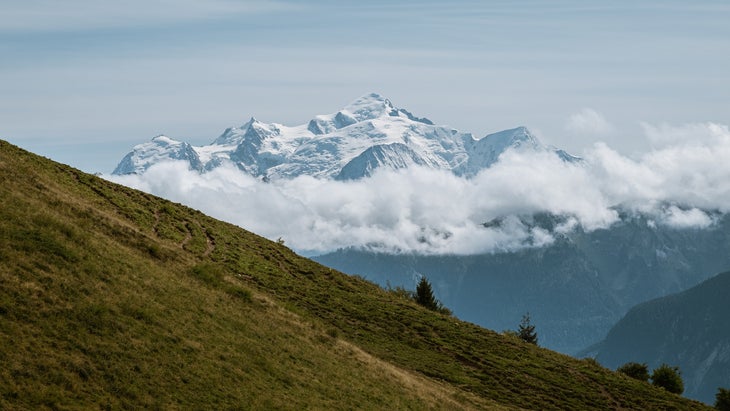
11) Learn the TMB Etiquette
As with many long-distance paths, there are rules to the road. On the TMB, they are well-established, thanks to the long history of the route.
At refuges :
- Shoes and poles in the boot room only.
- In shared rooms, try to be quiet at night, and don’t turn the light on if someone is sleeping. Turn cell phones off or to Airplane Mode.
- Use an indoor voice. (Yes, it really is true: Americans tend to be among the loudest.)
- A small tip is appreciated–perhaps a euro for a snack and cafe au lait, a few euros for a meal.
On the trail :
- Remember that there might be bikers, runners, or faster walkers who want to get past, so be ready to step aside.
- Share a “Bonjour” when passing fellow hikers.
- Please, don’t play music out loud. Grab the earbuds.
- Evidence is starting to mount that swimming in lakes has a negative impact on their ecosystems. Please minimize or avoid it, especially if you’re wearing sunscreen.
12) My Top TMB Advice: Treat Yourself!
The TMB has to be the hiking path with some of the tastiest aid stations en route. While you’ll burn over 4,000 calories a day, if you’re not adding it all back, well, you’re missing out.
This is ten years of in-depth culinary research in a handful of short paragraphs, but rest assured, the pleasure was all mine.
On one of my first TMBs, circling the Mont Blanc massif in four days as part of a trail-running mini-vacation, our group kept a literally running tally of the number of tartes aux myrtilles (blueberry tarts), pain au chocolates, and cafe au laits we had. We quickly lost track, though.
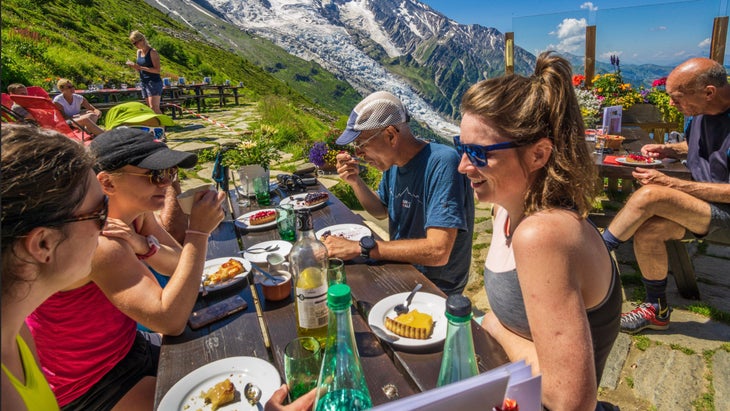
My brothers, cousin, and I repeated a version of this game last fall. In fact, counting tartes and other treats is a classic TMB tradition. Thanks to those baked mountain goodies and endless big views, the miles pass quickly. Before you know it you’ll be back on the steps of the centuries-old St. Michel Church in Chamonix, celebrating with beers from Big Mountain Brewery and looking forward to a fromage-filled celebratory dinner at La Caleche.
Here are some of my favorite stops en route.
- Refuge Plan de l’Aiguille : While not on the TMB, this high hut above Chamonix is well worth a visit. So, book a jet-lag recovery day in Chamonix, and head here for a TMB warm-up. Claude and his staff make what is widely considered the best tarts in the Chamonix valley, fresh each morning. The typical spread is wild blueberry, strawberry, lemon, and raspberry. (Take in the Midi tram, the world’s second-longest, on the same day.)
- Chalet Miage : Stop for lunch at this rustic mountain farm before the French village of Les Contamines and order anything on the menu. Really. It’s that simple.
- Alpage Ville de Glacier : If you’re not taking Col des Fours, look for this farm just outside the hamlet of Chapieux and stock up on local Beaufort and Sérac cheese directly from the farmer.
- Refugio Elizabetta : Time your wanderings to stop in for their traditional Italian lunches like hearty bowls of polenta, and all for a good price.
- Courmayeur, Italy : This TMB stopover town has a wide array of great restaurants, so schedule a rest day here. Get a gelato or an ice cream at the Gelateria in the center of town, and sneak down a side alley for focaccia at Pan per Focaccia. Pro tip: ask your hotel to book a taxi to the QC Terme roman spas at Pré-Saint-Didier. If you end up wanting more, the same company has a new facility waiting to ease the end-of-trip aches and pains in Chamonix.
- Alpage de Bovine : Switzerland is all about comfort food, and the grated potato and cheese Rostï at this high Swiss farm stop will persuade you that all is well with the world. Save room for an apricot or blueberry tart.
- Refuge Col de Balme : Wrap your hands around a thick hot chocolate as you look down to Chamonix and eye the last ten miles of your loop around Mont Blanc.
Santé et à bientôt!
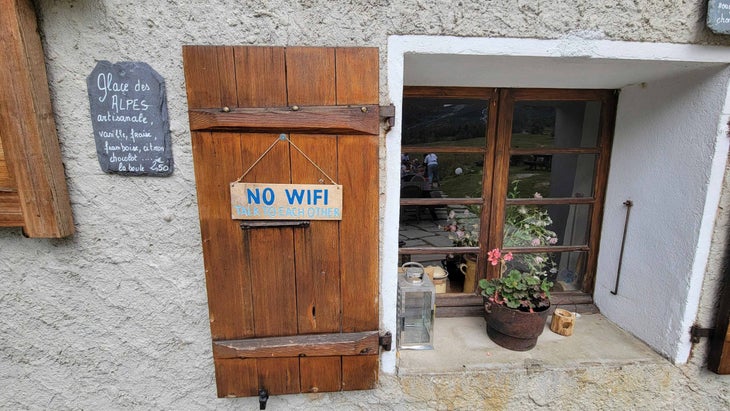
13) Important Resources for the Tour Du Mont Blanc
Helpful sites for diy planners.
Autour Mont Blanc is a one-stop online planning site, with links to key huts and other services along the way.
The Hiking Club offers paid support for DIYers who want a hand building their own trips.
Taxi Besson : Taxi Besson is the go-to company to shuttle your bags around the TMB. They work with most major hotels in the region. Drop your bag by in the morning after breakfast, and it will be waiting for you at your next hotel that evening. (In my outfit’s ten years of using them, they’ve never once failed us.) Pro tip: Follow the weight-limit guidelines, ask at the hotel desk exactly where to leave your bag, and don’t tie anything to the outside.
Mountain Drop Offs transfers between Geneva and the Chamonix valley.
Tour du Mont Blanc Facebook Group : With nearly 37,000 members, this Facebook group is lively, filled with useful information. Ignore the know-it-alls, and you’ll find tons of good intel.
If you’re going on your own, Emily Geldard, a longtime resident and the Run the Alps assistant manager, has created a handy summary of options to shorten many of the days, in the event of inclement weather or injury. “ The Long and Short of the TMB ” offers information on bail-out options, plus a list of ways to extend each day if yesterday’s pastries have you energized for bonus terrain.
Outfitter Recommendations for Guided and Self-Guided Hiking
Alpinehikers , Cloud Nine Adventure , Alpenwild, and Happy Tracks are highly regarded tour operators who offer both guided and self-guided trips on the TMB.
Outfitter Recommendations for Guided and Self-Guided Running
Run the Alps is an Alps-based company with U.S. roots. (The author is the founder and part owner.) Run the Wild and Tracks and Trails are two other good options.
If You Need a Doctor
If you have an emergency, use the emergency numbers or ask your accommodation host to call a local doctor. Les Contamines, Courmayeur, and Argentière have pharmacies.
A handful of apps make the TMB easier to navigate, including Gaia GPS, which also contains weather data. Meteo Swiss is often used for weather.
(Gaia is owned by Outside Inc., the company that owns Outside.)
Learn Some of the Local Language
French / Italian:
- Hello = Bonjour / Ciao
- Thank you = Merci / Grazie
- Breakfast = Petit Dejeuner / Colazione
- How much is it? = Ça coûte combien? / Quanto costa?
- Do you speak English? = Est ce que vous parlez anglais? / Parla inglese?
- Where are the toilets? = Où sont les toilettes? / Dove e’ il bagno?
- This way? = Par ici? / Da questa parte?
- It hurts here = Ça me fait mal ici / Sono ferito qui
- Mountain hut = refuge de montagne / rifugio di montagna
- I need help = J’ai besoin d’aide / Ho bisogno di aiuto

Great Side Trails to Explore
One of the best features of the TMB is that there are plenty of side trails to hike along the way. You can truly do your own hike, mixing the standard route with wilder variants, or hopping a local bus to skip sections. Hiking what we call a variant trail can be a great way to get away from crowds and find solitude. Here are a few of my favorites.
- France: Col de Fours : from Les Contamines to the must-see rustic lodge of Les Mottets, this is a direct variant that detours around Les Chapieux. It is a mere 350 feet of additional climbing–though much more technical than the norm–and a bit more than a mile shorter. It includes one of the highest points on the TMB (which should be avoided in bad weather). Best of all, there’s a high likelihood of seeing ibex.
- Italy: Val de Sapin : From Courmayeur to Bonatti Refugio, this adds an additional 1,300 feet of climbing and about a mile of distance. It is a wild and quiet valley, and you are likely to see ibex.
- Italy into Switzerland : Petit Col Ferret: Next to the Grand Col Ferret, this is an alternate route to La Fouly. It is the same distance and elevation, but the rocky descent is more technical. The trail is much quieter than the traditional route.
- Switzerland: Fenêtre d’Arpette : from Champex to Trient, this variant adds about 1,300 feet of elevation, and is a bit less distance, but it is a lot more technical and time-consuming. Because of the high altitude and slippery rock, it should be avoided in bad weather and certainly during the early season. The route’s steep and icy snowfields linger into early summer and have led to a fatal slide every few years. The scenery is wild and other-worldly, and the trail is usually quiet.
- Switzerland into France: Les Tseppes : From Trient to Argentière, France, this variant adds a few hundred feet of elevation and about a mile of distance. The start is steep and daunting, but worth the challenge. The trail is quiet, and you are treated to wide-ranging views of the Vallorcine valley and Mont Blanc.
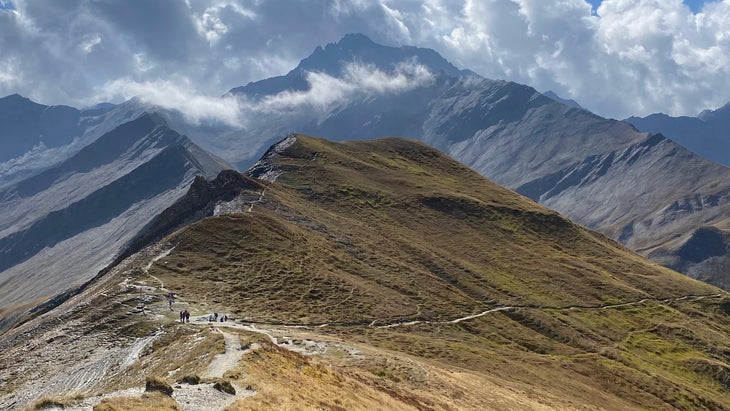
The Author’s Lodging Recommendations Along the TMB
- High End : If you want modern and plenty of amenities, Heliopic is your go-to. Want authentic French? Head to the Hameau Albert 1er.
- Middle : Le Refuge des Aiglons is modern, with a nice spa, pool, and outdoor seating. For something more rustic, head down the street to Hotel Oustalet, which features a large yard that’s somehow quiet, despite its central location.
- Rustic : La Boerne is located out of town in the tiny collection of chalets known as Tré-le-champ. It’s a ten-minute walk to the local train, which is 20 minutes from Chamonix. There’s also bus service from Argentière, a 15-minute walk away.
Les Contamines
- High End : Hôtel La Chemenaz. Spacious private rooms and suites, with an outdoor swimming pool and spa.
- Middle : Gai Soleil. Family-run by passionate staff, this converted farm has been hosting tourists since the 1920s. The private rooms have a cozy, alpine feel.
- Rustic : Chalet Refuge de Nant Borrants. Set on the TMB trail, a little outside of Les Contamines, this refuge is secluded and traditional. The dormitories are clean, with just six to nine people in each room.
Les Chapieux
- High End : Taxi to Bourg St-Maurice and stay at Hotel L’Autantic or Hotel Base Camp Lodge des Arcs.
- Middle : Chambres du Soleil. Family-run, with excellent food cooked by the husband. There are woodburners in the dining rooms, and blankets in the bedrooms made from local wool.
- Rustic : Refuge Les Mottets. The food is hearty mountain style using local cheeses, and the dining room is decorated with historic farming equipment. A refuge staffer often plays music at dinner time on the player piano in the dining room.
- High End : Grand Hotel Courmayeur. Modern and stylish rooms, with an indoor pool and spa.
- Middle : Bouton D’Or. Traditional, alpine decor, and a fantastic breakfast buffet that is all homemade. The fruits in the breakfast tarts are grown in the kitchen garden.
- Rustic : Cabane du Combal. A secluded location in the mountains, on the TMB but outside of Courmayeur.
- High End : Take a taxi to Verbier and stay at La Cordée des Alpes. Modern rooms with alpine decoration.
- Middle : L’Hôtel Edelweiss. Clean, modern rooms that have been recently renovated.
- Rustic : Gîte Alpage de La Peule. This is an active dairy where you can buy the products, and see how different cheeses are made.
- High End : Hôtel Alpina. A husband-and-wife partnership with Michelin-standard food cooked by the husband. The building is small and has a private, family feel.
- Middle : Hôtel Splendide. A historic and grand hotel built in the 1930s. Think high ceilings, stained-glass windows, and creaky wooden floorboards.
- Rustic : Relais d’Arpette. A traditional mountain auberge on a variant taking you a 20-minute walk off the TMB, on the Fênetre d’Arpette, in a secluded valley outside of Champex. Fantastic views.
- High End : Take a taxi to Argentière and stay at the Hôtel Les Grands Montets. Access to a spa and indoor swimming pool. The rooms are cozy and comfortable with alpine deco.
- Middle : La Grande Ourse. Clean, modern rooms and friendly staff.
- Rustic : Refuge Le Peuty. Excellent food served in a yurt with homemade, artsy decorations.
- High End : Hôtel Les Grands Montets. Access to a spa and indoor swimming pool. The rooms are cozy and comfortable with alpine deco.
- Middle : With an old standby, the Hôtel de la Couronne, newly sold and under renovation until at least December 2023, middle-of-the-road accommodations are thin in Argentiére. A good alternative is to take public transport or a train to Chamonix or Vallorine, and double up your nights in one of your last hotels.
- Rustic : La Boerne. Another traditional auberge that is right on the TMB trail. It is in a quiet, secluded spot with a beautiful terrace. The building is full of character, with wooden beams and bunkbeds.

If You Get Shut Out of the TMB This Year
Troy Haines of Alpinehikers likes to point clients toward other, quieter destinations in the Alps, such as the Haute Route between Chamonix, France, and Zermatt, Switzerland; Switzerland’s Bernese Oberland; or Italy’s Dolomites. “All of them, TMB included, are simply stunning,” Haines says. “You really can’t go wrong.”
How to Be a Conscientious Traveler
While the seven principles of Leave No Trace are not specifically called out along the TMB, they are excellent guidelines, particularly as the TMB or any other place becomes busier. Learning a few phrases of the local language is always a nice icebreaker and shows respect, and please be patient with busy hut and innkeepers. When passing through the huts, follow the simple protocol of removing and storing boots and poles. Protocols are often posted right inside the doors.
Doug Mayer is the founder of the trail-running tour company Run the Alps . He lives in Montroc, France, 100 yards from the TMB, where he often trail runs with his labradoodle, Izzy. His new book is The Race That Changed Running: The Inside Story of the UTMB.
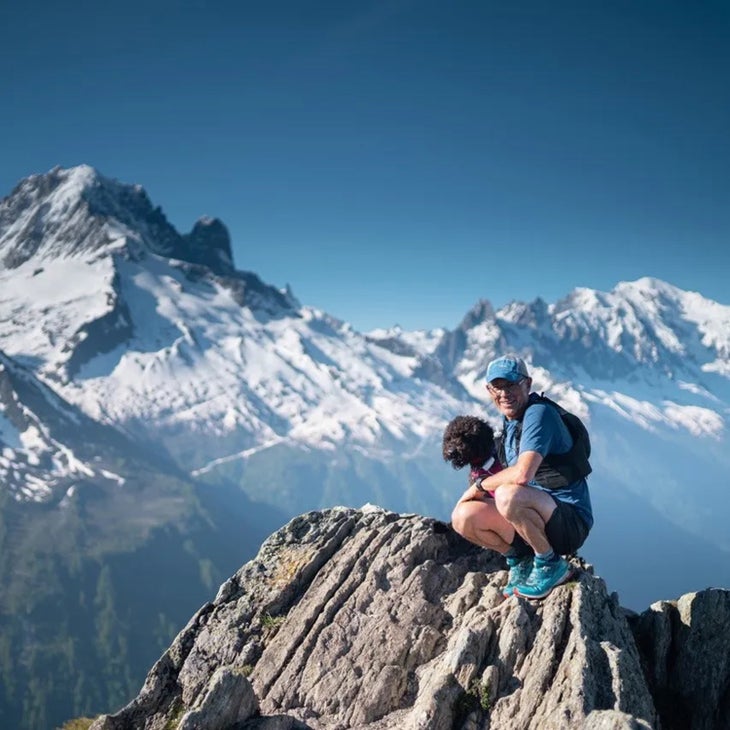
- Hiking and Backpacking
- Hiking Boots
- Switzerland
- Trekking Poles
Popular on Outside Online

Enjoy coverage of racing, history, food, culture, travel, and tech with access to unlimited digital content from Outside Network's iconic brands.
Healthy Living
- Clean Eating
- Vegetarian Times
- Yoga Journal
- Fly Fishing Film Tour
- National Park Trips
- Warren Miller
- Fastest Known Time
- Trail Runner
- Women's Running
- Bicycle Retailer & Industry News
- FinisherPix
- Outside Events Cycling Series
- Outside Shop
© 2024 Outside Interactive, Inc

- Best Hikes In The World
- Appalachian Trail
- European Hikes
- Nepal Hikes
- Patagonia Hikes
- See All Hikes
- Mount Kenya
- Mount Kilimanjaro
- Mount Toubkal
- See All Mountains
- South Africa
- New Zealand
- Switzerland
- United Kingdom
- Packing Lists
Tour du Mont Blanc (Expert Guide)
Europe , France , Hikes , Italy , Mountains , Switzerland
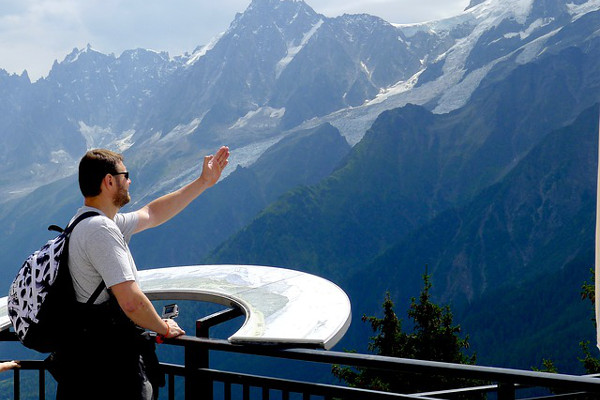
The Tour du Mont Blanc is one of the most popular treks in Europe. It covers a distance of roughly 170 kilometres and gains more than 10,000 meters of altitude over 11 stages.
In this guide we cover: what weather to expect and the best time to hike the Tour du Mont Blanc, which huts to book, what gear you might need, and much more...
Join a Tour du Mont Blanc Highlights Hike
Book with our recommended local guide
Tour du Mont Blanc
Route overview.
The Tour du Mont Blanc covers a distance of roughly 170 kilometres and gains more than 10,000 meters of altitude over 11 stages. Most people start their hike in Les Houches, France going in an anti-clockwise direction.
During this trek you will hike in the French, Italian and Swiss Alps and spend the night in mountain huts. This is one of Europe's best hikes and is a classic alpine trek. On the hike you will get splendid views of some of the highest mountains in Western Europe, as well as glaciers and alpine meadows.
The highest point reached is 2,665 meters.
The hike passes seven valleys along the way, which means there is a lot of altitude to be gained, making the Tour du Mont Blanc a physical challenge.
Fortunately, walkers are rewarded with some of the best views you can get of Mont Blanc . The route is not only one of the most beautiful long-distance treks in Europe (up there with the Walker's Haute Route ), but one of the most popular ones as well.
Nights can be spent in either mountain huts along the route or back in the valley, where you can have the luxury of a warm bed in a hotel.
What we like and dislike about the hike
- Incredible views of the Mont Blanc massif
- Hike in three countries
- Visit the beautiful villages of Chamonix and Courmayeur along the way
- Spend the night in some of Europe's most iconic mountain huts
- More expensive than other treks in Europe due to the cost of mountain huts
- Physically challenging
- Can be crowded during the summer months
Join the full Tour du Mont Blanc Hike (10-Days)
Tour du mont blanc circuit.
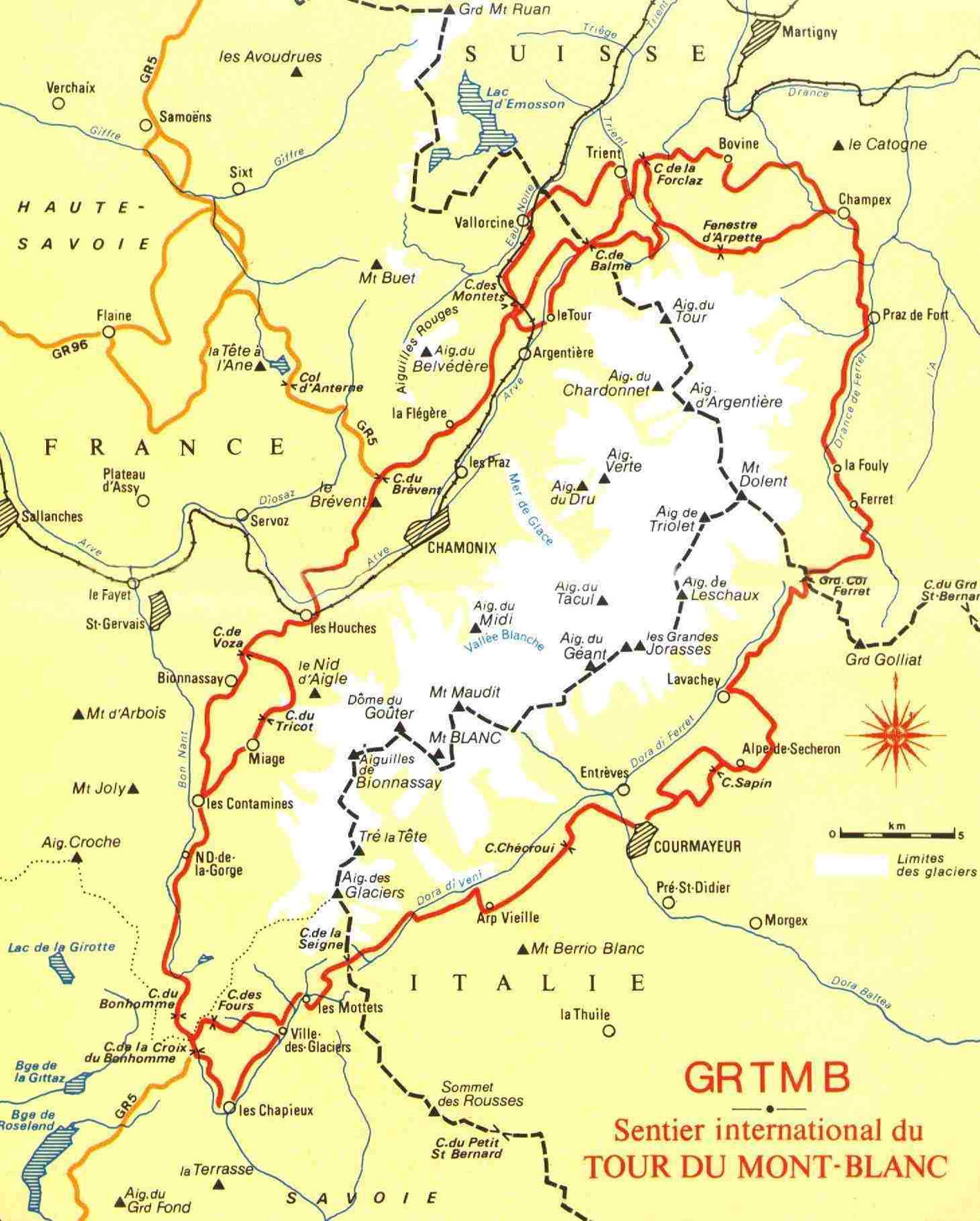
Source: chamonix.net
This map illustrates the Tour du Mont Blanc route. It starts off at Les Houches, France close to the Swiss and Italian border before heading west towards the Italian side of Mont Blanc.
There are 11 stages depending on your physical level. The route is circular around the Mont Blanc Massif, crossing the borders of France, Switzerland and Italy.
In terms of a trekking map we recommend:
- Chamonix, Mont-Blanc ~ IGN Top25 3630OT 2012 (English and French Edition)
And in terms of a trekking guide we highly recommend:
- Cicerone's The Tour du Mont Blanc: Complete two-way trekking guide
Altitude Profile
In the chart below you see the altitude profile of the full hike. It is quite clear there is a lot of altitude to be gained over the 11 stages, with the highest point reached just above 2500 meters. You can see that there are a few strenuous stages reaching high mountain passes that will require great effort.

Mont Blanc Route Itinerary
Below we have laid out the most popular version of the Tour du Mont Blanc Route – 11 days, starting and finishing in Les Houches. The itinerary includes approx. distances, hiking times and elevation changes.
Day 1: Les Houches – Les Contamines
Distance: 16 km Ascent: 646m Descent: 633m Hiking time: 5hrs
Easy first stage along, this is the most roadway you will see during the trek. The best views are to be seen at Col de Voza, where you get a look at Dome du Gouter and Aiguille de Bionnasay, with the glacier splitting it in half.
Day 2: Les Contamines – Les Chapieux
Distance: 18 km Change in elevation: 1316m+, 929m- Hiking time: 7.5hrs
A bit tougher than the first stage. Especially, since there is quite some altitude to be gained and distance covered.
Day 3: Les Chapieux – Rifugio Elisabetta
Distance: 15 km Change in elevation: 1004m+, 258m- Hiking time: 4.5hrs
This is the day you will leave France and enter Italy via Col de la Seigne. Despite being a short day, there still is some elevation to be gained as you will pass Col de la Seigne. At the highest point, you will gain some great views of both France and Italy and gaze into Val Veni. This is the first night you will spend in a mountain hut.
Day 4: Rifugio Elisabetta – Courmayeur
Distance: 18 km Change in elevation: 460m+, 1560m- Hiking time: 5hrs
Another short day, since you will mainly be descending. Still, some great views will be shared before reaching Courmayeur, the Italian equivalent of Chamonix.
Day 5: Courmayeur– Rifugio Bonatti
Distance: 12 km Change in elevation: 860m+, 101m- Hiking time: 4.5hrs
Often described as the most scenic stage of the Tour du Mont Blanc. With views on the glaciers of Planpincieux and Frebouze it’s not hard to see why. The high route along the Mont de la Saxe Crest is thought of as one of the best viewpoints of the southside of the Mont Blanc.
Day 6: Rifugio Bonatti – La Fouly
Distance: 20 km Change in elevation: 895+, 1410m- Hiking time: 6.5hrs
Today will cross another border and enter Switzerland. Cowbells and tiny villages that have been stuck in time are your scenery for the next few days.
Day 7: La Fouly - Champex
Distance: 15 km Change in elevation: 420m+, 565m- Hiking time: 4hrs
This probably is the easiest stage of the Tour du Mont Blanc since there are no cols to be conquered. This stage mainly is a valley trek with some great charming villages along the way. However impressive views of the mountains remain.
Day 8: Champex – Col de la Forclaz
Distance: 16 km Change in elevation: 742m+, 682m- Hiking time: 4.5hrs
There are two ways to reach Col de la Forclaz. A lower route via Alp Bovine, or the more scenic and higher route along the Trient Glacier. This latter passes the Fenetre d’Arpette, the highest point on the Tour du Mont Blanc, and should only be considered in good weather.
Day 9: Col de la Forclaz – Tre le Champ
Distance: 13 km Change in elevation: 1069m+, 1168m- Hiking time: 5.5hrs
From this point you re-enter France via Col de Balme. A lot of elevation is to be gained and lost, which makes the stage a strenuous one.
Day 10: Tre le Champ – Refuge Flegere
Distance: 8 km Change in elevation: 733m+, 257m- Hiking time: 3.5hrs
Short stage, but with some ascent. You will spend another night in a mountain hut. Refuge Flegere offers great views and is a perfect last night in the mountains before arriving in Les Houches the next day. There are some ladders to be climbed before reaching the refuge however.
Day 11: Refuge Flegere – Les Houches
Distance: 17 km Change in elevation: 772m+, 1546m- Hiking time: 6.5hrs
This last stage of the Tour du Mont Blanc goes along Le Brevent in the Aiguille Rouge. There are some splendid views of the Chamonix Valley before finally descending and arriving back in Les Houches.
Video Overview
A beautiful video overview, filmed with a GoPro, of the Tour du Mont Blanc by Eugenio psnt .
Join a Tour du Mont Blanc Hike
Frequently asked questions, how much does the tour du mont blanc trek cost.
The cost of the Tour du Mont Blanc trek is dependent on whether you plan to do a self-guided hike or join a planned tour. Self guided hikes cost in the region of $1500 (estimate of $50-$75 dollars a day). Most mountain huts / gites are around $50 (incl. breakfast).
Guided trekking tours can be quite expensive since not only do you pay for the guiding service, but you eat and spend most nights in hotels or mountain huts. This mostly includes a luggage transfer to your next accommodation as well, so you can hike with a small backpack. Guided tours range from $2000-$3500, depending on the company / season / size of the group.
Self guided is the cheaper option, however, it does mean you carry more weight in your backpack and some planning of logistics in the weeks / months before.
Are permits required for the Tour du Mont Blanc trek?
No permits are required for the Tour du Mont Blanc trek.
When is the best time to trek the Tour du Mont Blanc Route?
The best time to trek the Tour du Mont Blanc is between July-September, but exact start and end dates depend on the amount and timing of the previous winter’s snowfall and the onset of cold weather in the Autumn.
Since the Tour du Mont Blanc crosses high passes, snow could create problems / dangerous conditions. Therefore in a normal year it is not advisable to set out before July. In the summer months, mid-July through to end of August, are the busiest, and temperatures during the day can rise to 25 degrees. Nonetheless, thunderstorms or a dump of snow is possible as well.
By the end of September, huts will close and it might get a lot harder to complete the trek.
Is altitude sickness a risk?
No, you will cross passes slightly higher than 2500 meter and since you’re hiking slowly to this altitude, you have more than sufficient time to acclimatize. Most people don’t feel any symptoms of altitude sickness before reaching 3000-3500 meter.
How difficult is the Tour du Mont Blanc trek?
Hiking the Tour du Mont Blanc comes with great rewards. Rewards that will be more easily gathered when physically fit and mentally attuned. There are many steep and uphill sections to conquer, so exercising regularly at home before the trek is necessary to get in shape for the physical demands of this route. Mental fitness is as important and often go hand in hand.
The Tour du Mont Blanc is doable for any fit mountain walkers who are able to hike between 5h and 7h30 min per day for several days in a row.
If you are finding the trek tough there are a few sections where you can use public transport to shorten your hike.
What gear do I need?
To do a serious trek like the Tour du Mont Blanc, appropriate clothing and equipment is a must.
Some comfortable lightweight trekking boots are a must to enjoy this trek, while good waterproofs might be essential, not only to protect you against rain or snowfall but to double as wind-proofs. Since you’ll be crossing passes of more than 2500 meters, gloves and several layers will prove useful. Trekking poles are a good way to not overload your knees and ankles
To help you plan and prepare for your trek we recommend our Tour du Mont Blanc packing list .
What travel insurance do I need?
Trekking insurance is important when going into the mountains. See our article on insurance for more information.
Do I have to carry my own gear all the way?
It’s up to you. There are many organisations offering guided trips for this hike, meaning they do all the logistics for you. This often includes a luggage transfer to your next accommodation in the valley, so you only need to carry a small backpack with some lunch, snacks and clothes.
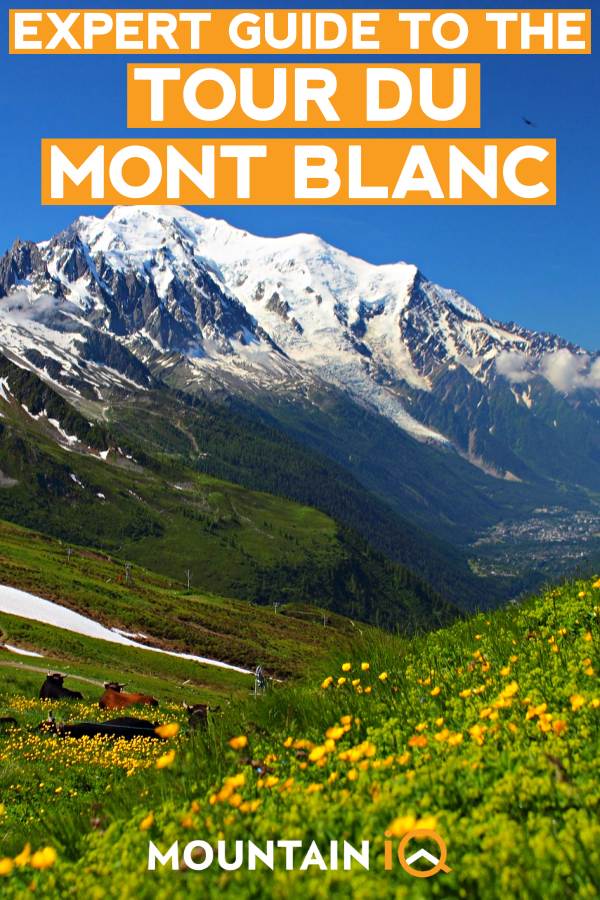
Browse more hikes in Europe
See our top European hikes picks, or check out these popular hikes.
- Tour de Monte Rosa
- Walkers Haute Route
- Camino de Santiago Routes
- Cinque Terre Hiking
- West Highland Way Hike
- El Caminito del Rey
- Laugavegur Trail
- Kungsleden Trail
- Rota Vicentina
- Slovenian Mountain Trail
About the author
Mark Whitman
Mark has trekked extensively in Asia, Europe, South America and Africa. He founded Mountain IQ in 2014 with the sole aim to be the best online information portal to some of the most popular mountain destinations around the world. When not writing for Mountain IQ, Mark is out exploring the outdoors with his wife!
Leave a Reply
Your email address will not be published. Required fields are marked
Hi Dempsey,
I’ve been thinking about doing that hiking for a long time and I think, after this pandemic crisis, it’s the time to see my dream coming true. I hope to do it as soon as possible, and to see it how beautiful the nature around is. Stay safe,
João Leite.
Wife and I are interested in doing this in last half of August. I know it is (too) late to reserve now. We plan to show up and hope for the best, perhaps taking advantage of late cancellations on a guided/luggage transfer arrangement. Any advice?
Hi Mike, there are a few dates available on this TMB highlights tour, which is amazing if you’re looking for a short circuit: https://www.skyhookadventure.com/trips/tour-du-mont-blanc-highlights
We work with local guides to offer great value adventures at unbeatable prices
- Chamonix Run Festival June 7th to 9th, 2024
- Weekend of 25 & 26 May 2024 was busy for the Chamonix PGHM
- The Panoramic Mont-Blanc Lift opens 25 May 2024 for the summer season!
- Gondolas, cable cars & trains open May 2024 in Chamonix
- End winter season at Grands Montets Freeride day Sunday 5 May 2024
At the foot of Mont Blanc (4808m or 15,770ft), the highest mountain in western Europe, Chamonix's alpine town atmosphere

The resort of Chamonix has three 5 star hotels, eleven 4 star hotels, twenty two 3 star hotels, thirteen 2 star hotels

Since 1934, Snell Sports has been the largest mountain shop in the Chamonix Valley.

Compare & Book Online with Chamonix.net
Tour du mont blanc hiking - routes, maps and itineraries.
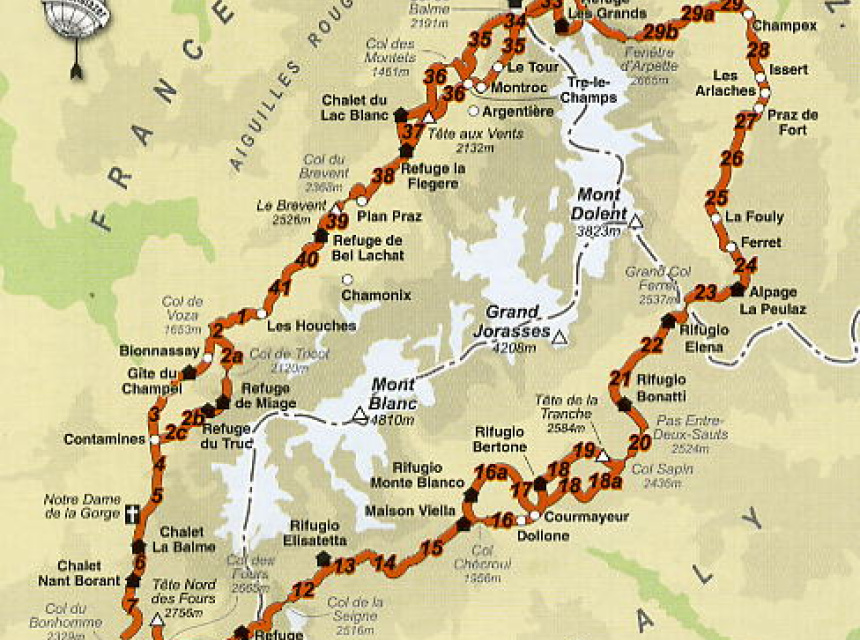
The Tour du Mont Blanc (TMB) is a 170 km trek that encompasses the whole of the Mont Blanc Massif; with nearly 10 000m of cumulative descent and ascent it is usually completed in a number of days.
The TMB has a variety of accommodation facilities along the route (hotels and mountain huts with possibility for vehicle support) that allow you to really enjoy the scenery, take lots of photos and walk each day with just a light pack.
Alternatively, the TMB can be done completely self-sufficiently: you carry all your own food and camping gear. This gives you a better sense of freedom and the ability to go where you please whenever you want.
Tour of Mont Blanc General Information
Mont Blanc Tour mountain huts are open, in general, from mid-June until the first or second week in September. It is advisable to reserve a bed, particularly in the high season of mid July to mid August.
Early in the season is the quietest and most beautiful, but beware of old snow on the higher paths which could be icy and dangerous and would make an ice axe essential.
For additional safety or to just show you the way you could hire an Independent Trek Leader .
Wildlife on the Tour du Mont Blanc
Have a look at the Chamonix.net nature, fauna and flora page for more information on wildlife you might encounter on the Tour of Mont Blanc. Chamois, deer, eagles and a range of beautiful alpine flowers can all be seen and photographed.
Tour du Mont Blanc Maps, Kit List and Equipment
Lightweight boots and shorts are sufficient as long as there are warm clothes in your backpack. Waterproofs are essential and trekking poles useful. Here are some of the best mountain equipment shops in Chamonix .
Do not forget sunglasses, skin and lip protection. Always carry drinking water and check the Chamonix weather forecast before starting your journey.
Maps for the Tour of Mont Blanc:
Tour of Mont Blanc - Route Descriptions
You have plenty of options: from 4 day sportive hikes to leisurely 12 day cultural experiences; there is not only one way to do the Tour of Mont Blanc. Here are a couple of different suggestions which may help you make up your mind on your particular style.
- You can go on your own with your own GPS track, or benefit from a mountain leader's experience
- You can carry your own gear or hike with a light pack with vehicle support
- You can sleep and eat in the refuges or carry a tent
Here is a list of contact information for the various mountain huts .
4 day trip: Not quite racing - but fast enough: For the hardcore hiker
This itinerary follows pretty much in the footsteps of the Ultra Trail race (which varies slightly from year to year). This is for very fit hikers and is done with only a light day pack, eating and sleeping in huts and is basically the run/walking version of the Tour du Mont Blanc. The times noted are for fit spandex-wearing (not obligatory!) hikers.
7 day trip: Hiking the Tour of Mont Blanc - hiker
Start with the previously mentioned itinerary and break up the days a bit depending on where you would like to spend the night.
For people who carry their own gear, plan on a 7 day trip.
9 to 11 day trip: Taking the time to look at the scenery
Of course if you really do have time, you can expand the experience. Here's an example of a slower pace, with time to veer a little off the path. This is described as an 11 day trip, but it would be really easy to knock off the first and last days as those days are dedicated to trekking in the Chamonix Valley.
Each year, in the last days of August, the trails around the Mont Blanc get really busy. This is because of one of the most amazing human competitions ever organized on this planet - The Ultra Trail du Mont Blanc - so keep this in mind when planning your hike of the Tour du Mont Blanc.
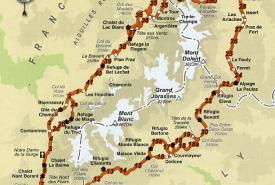
Social Networks

Latest News


The Ultimate Guide to the Tour du Mont Blanc
The Tour du Mont Blanc is one of the world’s most iconic treks. Frequently referred to as the ‘TMB’ for short, the Tour du Mont Blanc circumnavigates the Mont Blanc massif and takes trekkers through France, Italy, and Switzerland over the course of 11 stages. Along the way you’ll experience stunning valleys, high-mountain passes, incredible cuisine, and some of the best hiking in the world.
This guide is designed to be the perfect planning companion for your own Tour du Mont Blanc adventure. We’ve included everything you need to know to have a spectacular trip in one place, so you can be sure you’ve thought of everything. Read it through in a single go or jump to a specific section below, but rest assured knowing you’ve found the best resource on the internet for planning your Tour du Mont Blanc trek. Let’s get started!

In this Tour du Mont Blanc Guide
- How long is the Tour du Mont Blanc?
- How difficult is the Tour du Mont Blanc?
- Which direction should I hike?
- When should I hike the TMB?
- Designing your TMB Itinerary
- Shortcuts, detours, and rest days on the TMB
- Stage-by-stage Itinerary for the Tour du Mont Blanc
Tour du Mont Blanc Accommodation
- Getting to Les Houches from Geneva
- Getting to Champex from Geneva
- Luggage storage and transfer on the TMB
- Weather on the TMB
- Food and drink on the TMB
- Maps & Guidebooks
- Budgeting and money
- What to pack for the TMB
- How to train for the Tour du Mont Blanc
Everything you need to plan your TMB – all in one place.
Whether you prefer mountain huts or hotels, fastpacking or meandering, or something in between, we’ve got you covered. Our Guide to the Tour du Mont Blanc is the ultimate tool to help you plan your perfect trip.
When you purchase a guide, you’ll get instant access to all the information you need to plan your trip in our planning portal as well as in a downloadable PDF eGuide.
- Planning Portal Access: Get instant access to our online trip planning portal complete with 9-day, 11-day, and 12-day TMB itineraries.
- Accommodation Insights: You’ll get information on accommodation options for every stage, including where to book when popular huts are fully booked!
- GPS Maps: Every guide comes with custom GPS maps for three different itineraries. Download the maps for offline use so you’ll always be able to find your next campsite.
- Expert Advice: Find detailed maps for every stage, accommodation & booking information, packing lists, and much more.

We’re confident this is the best resource available for camping on the Tour du Mont Blanc. Pick up your guide below and if you’re not satisfied for any reason we’ll give you a full refund!
( 100% Money Back Guarantee )
About the Tour du Mont Blanc
The Tour du Mont Blanc (TMB) is a 170-km trek that circles the Mont Blanc massif. The route is traditionally walked in the anti-clockwise direction over 11-stages. The TMB starts and finishes in the French village of Les Houches , which sits adjacent to the popular mountain town of Chamonix . Along the way the trail passes through seven unique and beautiful valleys, where charming hamlets and regional delicacies abound. Between the valleys, the route traverses a rugged mountain landscape and stunning high alpine scenery.

The TMB is one of the most popular long-distance treks in Europe, with over 10,000 hikers per year embarking on their own walk around Mont Blanc. It is easy to understand why when considering the ease of access to the trek , plentiful accommodation options , and the fact that the route is achievable by most reasonably fit walkers . The closest major city to the TMB is Geneva, Switzerland, located just a few hours north by train or bus .
The route passes through seven mountain valleys (Val d’Arve, Val d’Montjoie, Vallee des Glaciers, Val Veny, Italian Val Ferret, Swiss Val Ferret, and Vallee du Trient) and visits charming alpine hamlets as it winds its way around Mont Blanc. Contrary to what many believe, the TMB does not go through the iconic French mountain town of Chamonix, instead taking a trail high-above this famed destination.

Want to see the entire TMB in three minutes? The fly through video below will take you along the entire circuit, providing a helpful overview of the trek.
How Long is the Tour du Mont Blanc?
The short answer: it depends! The Tour du Mont Blanc has many variations and route options as it makes its way around Mont Blanc. These variations include options to tackle challenging mountain passes (see the Fenetre d’Arpette ), visit crystal clear mountain lakes (such as Lac Blanc ), or to simply avoid some of the more challenging sections of the hike. However, the classic TMB route is approximately 170-kilometers long. Taking alternate routes may lengthen or shorten your total distance, depending on the routes chosen. Throughout the trek, you’ll have options to walk less or more depending on the weather, your preferences, and the conditions encountered on the trail.

How Difficult is the Tour du Mont Blanc?
If you are reasonably fit and have some trekking experience , you should be well-suited to the physical challenges of the TMB. It is a tough trek that involves long, steep ascents and descents on nearly every stage , but it isn’t too technically demanding. Remember, the Tour du Mont Blanc is a hike not a climb! Trekkers should be prepared for long days of hiking with plenty of elevation change, but frequent services along the route make it more approachable. Weather can add to the challenge , and hikers should be prepared to encounter rain and even snow at any time.
Many of the stages of the TMB are structured such that you’ll begin your hike from the valley floor, trek up and over a mountain pass, and then descend into the next valley to finish the day. This provides a nice rhythm to the Tour du Mont Blanc but can also make for some difficult days. Make sure you have healthy knees, as the downhill sections can take their toll! All that being said we truly believe that most walkers who invest a bit of time in training and preparation can complete the Tour du Mont Blanc with no problems and have a great time doing it! Our best advice is to be sure you are in good physical condition and also make sound decisions when you encounter bad weather or snow.
Get The FREE TMB Essentials Handbook

Our free PDF guide covers all the basics – when to hike, accommodation, typical costs, and more!
Your TMB Essentials Booklet will be emailed to you shortly.

Planning Your Perfect Tour du Mont Blanc
Now that you have a bit of background on the TMB let’s get to the heart of this guide: helping you plan your perfect Tour du Mont Blanc! First, we’ll start with some basics such as which direction you should hike in and what time of year will be best for you to tackle the TMB. Then we’ll dive into some more in-depth considerations such as designing your perfect itinerary and selecting your accommodation . Let’s get started!

Which Direction Should I Hike the TMB?

The TMB is traditionally hiked in an anti-clockwise direction beginning in the French town of Les Houches, adjacent to Chamonix. It is also possible to walk the route in a clockwise direction, and trekkers headed this way typically start in the Swiss town of Champex-Lac . Below we’ve outlined some pros and cons of hiking in each direction.
Anti-Clockwise (starting in Les Houches, France)
- Follows the classic route, good if you’re a sucker for tradition.
- Begins near Chamonix, which is easier to get to from the Geneva Airport than Champex.
- Rewards hikers with jaw-dropping views of Mont Blanc on the final stage.
- More people hike in this direction, so the trail could feel more crowded throughout the day.
Clockwise (starting in Champex, Switzerland)
- Fewer hikers walking in the same direction as you.
- The first few stages are a bit mellower, allowing you to get acclimated before tackling the tougher sections.
- You’ll meet different people at each stop along the way.
- You’ll pass a large wave of people walking in the opposite direction each day, which can get tight on narrow trails.
- Champex (your starting point) has fewer amenities and is less conveniently connected by public transport than Les Houches. If you want to start in Les Houches and hike clockwise, be warned that the first day involves a very challenging climb, which can be a tough way to begin your trek.
All things considered, you will be sure to have a great time on the TMB regardless of which direction you choose to hike in. Think through your options and make the best decision for yourself!

When Should I Hike the Tour du Mont Blanc?
The hiking season for the TMB generally lasts from late June through mid-September. July and August are the busiest months, and accommodation (with the exception of camping) must be booked in advance. There’s a chance you could get away without advance bookings in June and September, but we still wouldn’t recommend it.

June : Early in the season, you are likely to encounter snow on the trail. Depending on the snow levels, there could be sections that will be impassible and you may need to reroute. Otherwise, expect cool evenings, bright sunny days, and less crowded trails. Keep in mind that most mountain refuges don’t open until late June.
July : Hikers could still encounter some snow along the trail, but chances of significant snow will diminish as the month wears on. Expect beautiful warm days and abundant wildflowers. This is a popular month to hike.
August : Another busy month on the trail, hikers can expect snow-free paths and warm, sunny weather. The end of August brings the Ultra Tour du Mont Blanc trail race . Although the atmosphere during the race week is incredible, we recommend you try to avoid hiking during the UTMB to avoid crowds and logistical challenges.
September : Expect shorter days and increasingly chilly weather. This is a beautiful time to be on the trail and less crowded, although some accommodation providers may be closed for the season.
The bottom line : The best (and safest) time to hike the TMB is from late-June through early September. You’ll need to make advance bookings if you plan to hike during this time frame.

Designing Your TMB Itinerary

Now that you have a sense of which direction you’ll plan to hike in as well as which month you’ll embark of your trip it’s time to start thinking about your specific itinerary! As we’ve mentioned, the Tour du Mont Blanc in traditionally hiked over the course of 11 days, which will be a great pace for many hikers. However, there are certainly those who will want to tackle the trail in fewer days or savor their time in the Alps and extend their hike over the course of two weeks or more!
Whatever you choose be sure to consider your personal abilities, how much time you’ll have, and what you want your typical days on the TMB to look like. Given the amount of accommodation options on the TMB your itinerary possibilities are nearly endless! Checkout our general guidelines below as well as our stage-by-stage itinerary for the traditional 11-day Tour du Mont Blanc circuit to get some ideas of your own. Here are our general guidelines for thinking about how many days you’ll need to complete the TMB:
- 8-10 days : Fast pace (8 – 10 hours of hiking each day)
- 10-11 days : Average pace (without a rest day) (6-8 hours of hiking each day)
- 11-12 days : Average pace (with a rest day) (6 – 8 hours of hiking each day)
- 12-14 days : Leisurely pace (6 – 7 hours of hiking each day)
Shortcuts, Detours, and Rest Days on the TMB
One of the great things about trekking the Tour du Mont Blanc is the ability to alter your route based on the conditions encountered. Bad weather, injuries, fatigue, burnout, limited time; there are countless reasons why you may need to use alternative means of transportation to get from one point of the TMB to another. Fortunately, the trail rarely strays too far from civilization, meaning you have tons of options along the way for when you need them. Below, we’ve listed some of the most common detours and shortcuts used on the TMB, as well as a few great resources for problem-solving your unique situation.
Bellvue Cable Car: This option allows you to eliminate the lion’s share of the climb out of Les Houches on the traditional (anti-clockwise) first stage of the trek . Once you get to the top, follow the signs a short way to rejoin the main trail.
La Maison Vielle Cable Car (and chairlift): If you’d like to avoid the knee-wrenching descent into Courmayeur ( Stage 4 ), you can take a chairlift from La Maison Vieille down to Plan Chécrouit, where there’s a cable car that terminates in the town of Dolonne, across the river from Courmayeur. You can take a bus from Dolonne to Courmayeur if needed, otherwise it’s just a short walk.
La Flégère Cable Car: This gondola departs directly next to Refuge la Flégère and ends in the village of Les Praz. From there, it’s possible to take a bus or taxi back to Chamonix. This is a good option if you need to cut out the final day of the TMB , or if you want to hike in reverse and avoid the long, long climb out of Les Houches. You could also take the cable car down into Les Praz for more accommodation and services at this stage, and then take it back up the next morning to continue your trek.

La Chapelle to Notre Dame de la Gorge Navette : This free shuttle bus, or “navette,” runs from La Chapelle (a short walk from the trail on the outskirts of Les Contamines) to Notre Dame de la Gorge (at the beginning of Stage 2 ). This means you can pick it up at the end of Stage 1 to cut out the last hour or so of walking before reaching Les Contamines, and you can also take it from Les Contamines to Notre Dame de la Gorge on the next day to get a bit of a head start (30-60 minutes, depending on where you stay in Les Contamines).
Les Chapieux to Refuge des Mottets Navette : This shuttle allows you to avoid about 2 hours of road walking at the beginning of Stage 3 . It only costs a few euros to ride, and you can pick it up at the tourist information office in Les Chapieux. Make sure to buy your tickets in advance (do so the previous day, at the tourist office), as the shuttle fills up quickly in the mornings!
Arriva Bus-In and around Courmayeur: This is the bus network you’ll use if you need to take any alternative transportation in Val Ferret or Val Veny (the two valleys in the surrounding area). You can take a bus from La Visaille to Courmayeur to cut out the final hour of walking on Stage 4 . This bus can also be used to reach campgrounds that are not located directly on the TMB route. Additionally, you can use the Savda bus to get to either La Fouly or Champex (although you will need to transfer in Orsières and take a Post Bus the remainder of the journey).
TMR/SBB Bus La Fouly to Champex: You can get from La Fouly to Champex (effectively cutting out all of Stage 7) by bus. You’ll need to take line 272 from La Fouly to Orsières, where you’ll transfer to the 271 that will take you to Champex. Service is relatively frequent and easy to navigate.

SBB Train from Champex to Trient: It’s relatively easy and straightforward to take the Swiss SBB train from Champex to Trient, effectively cutting out all of Stage 8. You need to utilize the local bus in Champex and may need to transfer a few times on the way, but Swiss trains really do live up to their reputation for being timely and efficient.
Keep in mind that there are many more transportation options along the TMB! We’ve simply listed a few of the most common and straightforward ones. If you need to find a specific detour, we recommend using Rome2Rio or Google Maps as a starting point. PostBus and SBB also have excellent apps that can be used to plan trips and buy tickets.
NOTE: Many of the buses and cable cars only run during the peak months of the hiking season (July and August). Make sure that you check the websites and timetables before planning to use any of the options listed above.
Stage-by-Stage Itinerary for the Tour du Mont Blanc
We recommend most hikers take between 10-12 days to hike the Tour du Mont Blanc, depending on their hiking ability, pace preferences, and weather conditions. The classic itinerary described below takes 11 days to complete and will be the best option for the majority of hikers. We’ve given you a brief overview of each of the classic eleven stages, as hiked in the anti-clockwise direction. While your specific itinerary may look different, it’s still helpful to look over these stage descriptions to get an idea of what you can expect on the trail.
Be sure to check out our interactive map and elevation profile to get a comprehensive understanding of all of your options!
Stage 1: Les Houches to Les Contamines
- Distance & Elevation: 17 km // +1,112 m, -902 m
- Estimated hiking time: 5 – 6 hours
- Where to stay: Chalet-Hôtel La Chemenaz
Description: This stage is a perfect introduction to the TMB. It’s not too technical or demanding, yet it still gives walkers a decent challenge. You’ll start by climbing fairly steeply up out of Les Houches and past a ski area before topping out at Col de Voza . From the Col, you’ll descend along dirt then paved roads while enjoying incredible views of the surrounding glaciers and aiguilles. Continue along the road through some very quaint hamlets, before veering off onto a trail (pay attention-this is easy to miss). You’ll end this stage by walking along a mellow riverside path all the way to Les Contamines.

Stage 2: Les Contamines to Les Chapieux
- Distance & Elevation: 19 km // +1,440 m, -1,024 m
- Estimated hiking time: 7 – 8 hours
- Where to stay: Auberge de la Nova
Description: Start this stage by passing by the Baroque chapel of Notre Dame de la Gorge . From there, you’ll follow an old Roman road steadily uphill before getting a break when the trail levels out and passes through open meadowland. After that, prepare for another steep climb, much of it on stony steps and scree, up first to the saddle of Col du Bonhomme, and then even higher to the Col de la Croix du Bonhomme. Here you’ll find the Refuge de la Croix du Bonhomme , which makes a great spot to enjoy a break and small meal. Early in the season, it’s common to encounter snow on this section.
Upon reaching the summit of Col de la Croix du Bonhomme, begin your descent towards Les Chapieux. The trail on the way down begins as a steep footpath, eases to join a jeep road for a bit, and then finishes with steep zigzags through a pasture above Les Chapieux.

Stage 3: Les Chapieux to Rifugio Elisabetta
- Distance & Elevation: 14 km // +1,079 m, -480 m
- Where to stay: Rifugio Elisabetta
Description: Choose to begin this stage with either a couple of miles of road walking, or by short-cutting it on a bus to Refuge des Mottets . From the refuge, you’ll begin a relatively short and easy climb to the Col de la Seigne. Reaching the Col is special for a few reasons. First it marks the first of three international borders that you’ll cross on your trek. Standing at the top of the Col, you can look back towards France while also gazing ahead into Italy. Additionally, the wide-open views here are downright marvelous. From Col de la Seigne, enjoy a mellow descent to Rifugio Elisabetta.

Stage 4: Rifugio Elisabetta to Courmayeur
- Distance & Elevation: 16 km // +603 m, -1,536 m
- Where to stay: Maison La Saxe
Description: As indicated by the elevation statistics, this stage is dominated by a very long and steep descent into Courmayeur. Before beginning that section, however, you’ll cross through the expansive Vallon de la Lee Blanche, where Lac Combal reflects the magnificent surrounding peaks. From there, you’ll climb for awhile on an undulating path to reach Col Chécrouit, where the path begins its long downhill trajectory.
After passing a few ski areas (options to take the cable car down may be available), you’ll complete numerous switchbacks through the woods until you reach the quaint town of Dolonne. Walk through the town of Dolonne and cross the river to enter Courmayeur. Enjoy a wide arrange of excellent food and luxurious accommodation in Courmayeur. This is also a great place to take a rest day.

Stage 5: Courmayeur to Rifugio Bonatti
- Distance & Elevation: 12 km // +1,225 m, -415 m
- Estimated hiking time: 5 hours
- Where to stay: Rifugio Bonatti
Description: The views along this stage are some of the most spectacular of the entire walk, but you have to earn them with a very steep climb at the outset. You’ll enjoy the satisfaction of watching Courmayeur grow ever smaller down below you as you zigzag your way up the hillside to Rifugio Bertone.
From the Rifugio, you’ll enjoy an undulating, mellow walk with unparalleled views of Col de la Seigne, Aiguille Noire, Mont Blanc and the Grandes Jorasses. It’s an incredible experience to look back and see Col de la Seigne far in the distance, knowing you’ve traversed such an expanse in just a few days with your own two feet. The beautiful views continue to abound all the way until you reach Rifugio Bonatti, an atmospheric and memorable place to spend the night.

Stage 6: Rifugio Bonatti to La Fouly
- Distance & Elevation: 19 km // +1,032 m, -1,456 m
- Estimated hiking time: 6 – 7 hours
- Where to stay: Hotel Edelweiss
Description: This stage rewards hikers with another border crossing and more tremendous views. The walk begins with a relatively flat path that crosses a lovely hillside. Eventually, you’ll descend into Val Ferret (the Ferret Valley) before beginning a steep climb past Rifugio Elena and up further until you finally reach the Grand Col Ferret. At the top of the pass, you’ll enjoy your first views of Switzerland as well as phenomenal views of majestic peaks in every direction. It’s all downhill from there, much of which is pretty manageable, save for a few steep sections. There’s a rather uninspiring stretch of road walking at the very end of the day, but the charming town of La Fouly makes it all worth it.

Stage 7: La Fouly to Champex
- Distance & Elevation: 15 km // +729 m, -860 m
- Estimated hiking time: 4 – 5 hours
- Where to stay: Au Vieux Champex
Description: All of the guidebooks will tell you that this is the easiest day of the TMB (which is technically true), but don’t expect this stage to be completely effortless. Sometimes the “easiest” days can end up feeling really tough if we go into them with too cavalier a mindset. The first two thirds of this stage are quite mellow indeed; you’ll wind your way gently downhill through a quintessential Swiss valley filled with small farms and picturesque hamlets.
A substantial climb to Champex waits for you at the end of the stage, however. Even though it really is much less strenuous than the ascents of previous stages, it can be a shock to the body at the end of the day. Fortunately, the trail stays in the shade of the trees for much of the way up, and you’ll also get to experience the many wooden sculptures that are interspersed throughout the woods.

Stage 8: Champex to Col de la Forclaz
- Distance & Elevation: 14 km // +1,125 m, -1,066 m
- Where to stay: Hotel de la Forclaz
Description: On stage 8, the main TMB route follows an undulating path up to the Alp Bovine and then descends to Col de la Forclaz, but there are quite a few options to consider here. The Fenêtre d’Arpette route is a popular variant for those seeking challenge and adventure. With either route, you’ll also have a few options to choose from when it comes to your stopping point. For a shorter day, you can stop at Hotel de la Forclaz or you can continue on further to either Le Puety or Trient. There isn’t a clear “best” choice for what to do on stage 8, but it is important to think about what is best for you in terms of challenge, distance, and accommodation.

Stage 9: Col de la Forclaz to Tré-le-Champ
- Distance & Elevation: 14 km // +1,112 m, -1,229 m
- Where to stay: Auberge la Boerne
Description: This stage isn’t without physical demands, gaining and losing quite a bit of elevation in a relatively short distance. While most of the climb maintains a grade that isn’t crazy steep, the descent is another story. Even if you don’t love the arduous nature of stage 9, you’ll almost certainly be smitten by the scenery. Not only does summiting Col de Balme mean you’ll celebrate your third and final border crossing (back into France), but you’ll also get incredible views of Mont Blanc, back in sight for the first time in several days. Seeing Mont Blanc again and being back on French soil will likely remind you that your trek is nearing its end. Make sure to savor the final two stages of this incredible experience!

Stage 10: Tré-le-Champ to La Flégère
- Distance & Elevation: 7 km // +892 m, -446 m
- Estimated hiking time: 4 hours
- Where to stay: Refuge de la Flégère
Description: Allow yourself to sleep in on this stage, as you’ll have just a short walk ahead of you. Better yet, get to Refuge la Flégère early and enjoy a walk to the nearby Lac Blanc and a meal or beverage at the refuge. The final two days of the TMB follow the Grand Balcon Sud, a balcony trail with unrivaled views of Mont Blanc and the surrounding peaks. To reach the high point, you’ll need to climb a series of ladders, catwalks, and platforms that go on for longer than you might expect. If you have a fear of heights, we recommend taking the Col des Montets variant. This route takes about the same amount of time and still has great views. Upon reaching Refuge la Flégère, join in the festive revelry of your fellow hikers marking their final night on the trail.

Stage 11: La Flégère to Les Houches
- Distance & Elevation: 17 km // +969 m, -1,821 m
- Where to stay: Hotel Le Morgane (Chamonix)
Description: The final stage of the TMB is a big one in every way. Even though it’s dominated by downhill walking, the physical demands shouldn’t be overlooked. Start the walk on a very mellow uphill grade, before beginning a steeper climb past a ski area until reaching Col du Brevent. Take in the scenery (and catch your breath) here, but keep in mind that the best is yet to come. Climb further on more rugged terrain until you reach the almost-summit of Le Brevent (you can take a 5-minute detour to get to the actual top if you’d like).
From Le Brevent you’ll have an unobstructed and totally breathtaking vantage point from which to take in the entire Mont Blanc range. Take time to study every intricate glacier and craggy spire before finally tearing yourself away to make your way down towards Les Houches. Fortunately, you’ll continue to enjoy the scenery for awhile as you descend on a very long and very steep path. As you near Les Houches, the trail enters the woods where it passes a zoo and the large Christ Roi statue. Finally, the path ends at a road and perhaps the least scenic part of Les Houches. Keep walking to reach the more charming part of town, then stop and toast to your remarkable accomplishment!

There are accommodation options along the TMB to suit every budget and travel style. While not all of these options are available at every stage of the route, you can certainly customize your itinerary to fit your needs. It’s nearly inevitable that you’ll need to stay in a mountain refuge on at least one stage of your trek. Be prepared for basic, communal facilities, but don’t fear! These special places often yield the most memorable stays of the entire trip. We’ve provided a brief explanation of each of the options below:
Hotels on the Tour du Mont Blanc

Typically small and independently owned, the hotels along the TMB serve up a dose of luxury to the weary hiker. Unless otherwise noted by the hotel, expect all of the usual amenities (hot shower, private bathroom, breakfast offered, linens and towels provided, etc). Hotels typically cost upwards of €65 per person. For an additional fee, many hotels offer half-pension (AKA half-board or demi-pension ) which includes dinner and breakfast. A few hotels along the route have dortoirs in addition to private rooms. Dortoirs are dormitories that offer a good budget option.
Read More: TMB Accommodation and Refuge Guide
Refuges on the Tour du Mont Blanc
We consider a stay in a mountain hut to be a highlight of any TMB trek. Set in stunning and remote locations, the ambiance at the refuges (or rifugios in Italian) can’t be beat. Half-pension gets you a bed in a dorm (linens not provided), a delicious communal dinner, and a basic breakfast. Some refuges also offer private rooms (with shared bathrooms). Expect to pay around €55 per person for half-board in a dorm.

Gites d’Etape and Auberges
These are simple guest houses offering basic, dorm-style accommodation. Half-pension (dinner and breakfast) is typically included in the price. There are shared bathroom facilities with hot showers. Bed linens are usually provided. These are a good option for those who want to stick to a smaller budget, but don’t want to carry camping gear. Expect to pay around €50 per person for half-pension.

Camping on the Tour du Mont Blanc
Although they are the cheapest accommodation option along the TMB, the campgrounds on the route are quite luxurious. All provide sinks and toilets, and many offer hot showers and even WiFi! Expect to pay around €15 per person to camp. Note: you cannot camp on every stage of the TMB. Be sure to check out our Complete Guide to Camping on the Tour du Mont Blanc for a full camping itinerary.

Do I Need to Book my Accommodation in Advance?
This is a question that creates stress and anxiety for many hikers as they are planning for their TMB adventure. The short answer is that you should try to book your accommodation as early as possible, but the longer answer is a bit more nuanced. We’ve broken it down for you here, so you can plan with more confidence and less worry.
- Mountain refuges are the most important to book ahead of time. Many of these huts are quite small, so they fill up quickly. Many refuges accept reservations year-round, typically allowing you to book up to 12 months in advance. Some, however, do not respond to reservation requests during the winter months (September-March, typically). You should still try to email or call the refuge to reserve your spot as soon as you know your itinerary, even if it’s prior to March.
- Gites, auberges, and guesthouses should be your next priority when it comes to advance bookings. This is especially true in the smaller villages where accommodation options are limited, and/or if you have specific preferences for your lodging (ex; private room, linens provided, etc). As soon as you’ve made your travel plans, reach out to the gite/guesthouse (or book online). For peak summer months, it’s optimal to have these bookings made by the end of March.
- For larger hotels, you have a bit more wiggle room when it comes to making reservations. You should definitely still try to do it as early as possible, but they have more rooms and are often located in places with greater availability of lodging options.
- You do not need to make advance reservations for any of the campgrounds on the TMB. In fact, we recommend that you don’t. This will allow you to maximize the freedom and flexibility that camping provides, and it will make it much less complicated to check in at the campgrounds.

Booking your Accommodation for the Tour du Mont Blanc
When it comes to booking your TMB accommodation, there’s good news and bad news. Let’s get the bad news out of the way first. There’s no single, streamlined booking platform for all of the refuges and/or accommodation providers along the route. In fact, the way you book will vary greatly from place to place. The good news is that most (but not all) can be booked using the Autour du Mont Blanc platform . Many refuges, hotels, and gites also have their own websites with easy online booking platforms. Some require that you send an email or complete a contact form on their website.
The TMB is relatively easy to get to given its close proximity to Geneva, Switzerland. Flight connections from the rest of Europe, the US, and other international destinations are frequent. Travel by train to Geneva is also straightforward, if not a bit more time consuming than air travel. We recommend booking you flights as soon as you are able, as fares during the peak summer season can be quite high.
Getting to Chamonix/Les Houches from Geneva
The vast majority of walkers will get to the start of the Tour du Mont Blanc by first flying into the Geneva Airport (GVA). There are frequent flights to Geneva from the rest of Europe as well as a good number of flights from the U.S. Once you’ve landed in Geneva, you’ll have several options for getting to Chamonix/Les Houches:
- FlixBus – This is one of the least expensive and highest rated options. The service departs directly from the Geneva Airport and will take you to the Chamonix Sud bus station, in the heart of Chamonix. Expect the journey to take about two hours.
- AlpyBus – AlpyBus runs a door to door transfer service from the Geneva Airport to hotels in the Chamonix Valley. It is more costly than FlixBus, but also more convenient since they’ll drop you directly at your hotel or campground.
- Mountain Drop-offs – Similar to AlpyBus, Mountain Drop-offs runs a door-to-door transfer service for walkers arriving in Geneva. Very highly rated.
All of the options above will also be able to transport you back to the Geneva Airport at the end of the TMB. Many also offer discounts for booking a return ticket.

Getting to Champex from Geneva (for clockwise TMB hikers)
If you plan on walking the Tour du Mont Blanc in the clockwise direction, you may be choose to start your hike in the Swiss town of Champex. You’ll likely begin your travel by first flying into the Geneva Airport (GVA). Once you’ve landed in Geneva, you’ll need to connect via train and local bus to reach Champex. Unlike Chamonix, you have few options other than public transportation to reach Champex. However, Swiss trains are renowned for being on time and generally pleasant. Here are the instructions for reaching Champex from the Geneva Airport:
- Step One – Train to Martigny : Upon exiting the airport in Geneva you’ll need to catch a train to the Swiss town of Martigny. Most of these trains will be signed in the direction of Brig, so be sure to inquire that the train you are boarding stops in Martigny. The journey should take around 1 hour and 45 minutes.
- Step Two – Train to Sembrancher : From Martigny you’ll take a 15-minute train ride to the town of Sembrancher.
- Step Three – Train to Orsières : From Sembrancher, you’ll catch another train to the town of Orsieres. This is a short, 10-minute ride from Sembrancher.
- Step Four – Local bus to Champex : Unfortunately, Champex is not on a train line so you’ll have to complete the final leg of your journey via the local bus. From outside the Orsieres train station, you’ll need to catch bus #271 to Champex. The ride takes approximately 30 minutes and will drop you conveniently in the center of Champex.
The Swiss train provider, SBB , has an excellent website to help you plan your journey. We also recommend downloading the SBB app to your phone, which is very helpful for viewing timetables while traveling. Rome2Rio is also an excellent resource for mapping out your specific trip.

Luggage Storage and Transfer on the Tour du Mont Blanc
Many walkers will be traveling with more luggage than they might want to carry for the entire TMB. Storing extra luggage or having it transferred to your next stop is a great way to avoid carrying excess weight on your trek, while still allowing you to have everything you need for the remainder of your trip. This is especially true if you plan on traveling elsewhere on your holiday.
Luggage Storage on the TMB
Unfortunately, there are no luggage storage facilities at the train station in Chamonix. Walkers can store their extra luggage at the Gite le Chamoniard , which charges €4-6 per day, depending on the size of the bag. Other hotels and accommodation may store your baggage if you have a reservation before and after you walk, but you’ll want to confirm this ahead of time.
Luggage Transfer on the TMB
If you’re concerned about the difficulty of the TMB and have room in your budget, using a luggage transfer service can be an excellent way to reduce your effort on the trail and make your trek more enjoyable. Both of the companies we’ve recommended below come highly rated and allow you to customize services to your itinerary and preferences. Each morning of your trek, you’ll simply leave your bag in the designated storage location to be picked up by 8:00am. Your luggage carrier will deliver your bags to the next stop on your itinerary by 6:00pm each evening. Keep in mind that they will not be able to deliver your luggage to any of the mountain refuges that are inaccessible by road (including Rifugio Bonatti and Rifugio Elisabetta). Additionally, they will not drop your luggage at private residences or AirBnB’s.
- Besson Taxi Mont Blanc : This carrier typically charges between €150-€300 per bag for transfers, depending on how many days you use their services and how many people are in your group. They charge per bag and have a strict policy that bags may not exceed 15kg. This company also can provide shuttle services between stops on the TMB, if needed.
- Chamonix Valley Transfers : This company offers a variety of customizable luggage shuttles that range in price from €400-€800 for up to eight bags. The price increases with the number of stops added to your itinerary. They get good reviews for their reliability and friendly service.

Tour du Mont Blanc Weather
Mountain weather is always volatile, and what you’ll experience on the Tour du Mont Blanc is no different. Conditions can change very rapidly in the Alps, meaning that you can find yourself in the middle of a whiteout blizzard or on an exposed ridge during a thunderstorm without much warning. However, for the most part the weather during the hiking season is ridiculously lovely. Expect warm, sunny days, cool evenings, and not too much rain. You should also need to be prepared for very hot temperatures, very cold temperatures, rain, and storms (and you could even see all of these in the same day!)
Getting caught high up in the mountains during a storm or without the right gear is extremely dangerous, but you can greatly minimize your risk by taking a few important precautions:
- Meteoblue is arguably the best resource for predicting the weather. It allows you to see the forecast for specific peaks or coordinates, plus it has excellent radar displays and wind predictions. Check it every time you have cell service. Chamonix-meteo also gives detailed and accurate forecasts for the Mont Blanc region.
- If you’re ever unsure about whether you should hike in the current conditions, it can be helpful to ask the warden at the nearest mountain refuge. When in doubt, it’s usually better to air on the side of caution and give the mountains the respect they deserve. You can almost always find a detour or shortcut to get back on track the following day.
- Start hiking early in the day! This will allow you to avoid hiking in the heat of the day and greatly reduce your risk of getting caught in afternoon thunderstorms.

Food & Drink on the TMB
One of the many wonderful things about the Tour du Mont Blanc is that you don’t need to worry about carrying (and eating) eleven days’ worth of underwhelming freeze-dried backpacker meals. Due to the fact that the trail passes through many towns and villages, you will be able to resupply every few days. For budget travelers, it is possible to self-cater and keep your food and drink costs quite reasonable. You’ll need to bring your own camp stove and cooking equipment if you plan on fixing most of your own meals along the TMB. You can purchase baguettes, good local cheese and charcuterie, fresh fruit, and delicious pastries for very reasonable prices.
Most of the shops along the route have convenient foods like instant noodles and canned soups, as well as dried fruits, nuts, energy bars, and other snacks so you should have no problem putting together quick and delicious meals and snacks along the route. Some hikers choose to use some backpacker meals and supplement with foods they purchase along the way.
Additionally (for those with slightly deeper pockets), nearly all of the hotels, gites, and refuges offer the option of purchasing meals. You can just show up for lunch or a snack, but you’ll need to order ahead of time for dinner. Most refuges and many hotels and gites offer the option of half-board ( demi pension ), which includes dinner and breakfast.
Dinners at the mountain refuges are typically indulgent, multi-course affairs. Expect a soup or salad as a starter, a hearty pasta dish as the main, and either a cheese course or dessert to finish. Breakfast is much simpler, typically consisting of a selection of breads, cold cereals, juice, and coffee or tea.
Whichever way you approach your food and drink strategy, we think you’ll find that trekking in the Alps is every bit as much a culinary delight as a natural one!

Dietary Restrictions
The restaurants and accommodation providers along the TMB are generally quite willing to provide a vegetarian option. Those who are vegan, gluten-free, or have a specialized diet will have a harder time finding suitable meals. While certain places will be able to accommodate your needs, that will be the exception and not the norm. Make sure to inform all of your lodging providers of your dietary needs in advance, as they will be much more likely to accommodate you. That being said, we’d recommend bringing along plenty of your own food as a back up.
All of the hotels, gites, and campgrounds provide potable water ( eau potable ). You will pass through many villages with public drinking fountains, but make sure to plan ahead and carry 1-2 liters of water each day. Due to the presence of agricultural activity near large swaths of the trail, we do not recommend drinking any water from natural streams without filtering it first.
If you need to purchase fuel for a camp stove, your best bet is to get this in Chamonix or Les Houches. Both towns have outdoor retailers that sell a few different kinds of fuel, and will be able to accommodate most standard stove types. It is unlikely that you’ll be able to find it at most of the stops you’ll pass through along the TMB, so plan on getting enough fuel to last your entire trek.
Maps & Guidebooks for the Tour du Mont Blanc
Carrying a good map is essential on the Tour du Mont Blanc. While the trail is generally well-marked and easy to follow, there are countless trail junctions, detours, and confusing sections that require some form of navigation.
When we hiked the Tour du Mont Blanc we did not rely on traditional, paper maps that are available for the route. Instead, we preferred utilizing GPS maps on our phones to ensure we knew where the trail was as well as where we were in relation to it . Cell phone service is very limited along the TMB, so it is critical to have a good offline mapping app such as Gaia GPS to ensure you’ll be able to view the map at any point along the route.

You can learn more about how to navigate on the Tour du Mont Blanc here.
With all this considered, we still recommend carrying a paper map. While technology has done a tremendous amount to make navigating while hiking easier, there is simply no replacement for carrying a physical map with you. We recommend bringing the IGN 3630 OT Chamonix and IGN 3531 ET St-Gervais with you, as they provide a detailed view of the TMB route. A weatherproof carrying case like this one wouldn’t hurt to have either.
Find everything you need to know about Tour du Mont Blanc maps here.

As for guidebooks, you’ll have two excellent options to choose from. The first, and the one we recommend, is Kev Reynolds excellent Tour of Mont Blanc: Complete two-way trekking guide published by the renowned guidebook company, Cicerone. Another good option is the Trailblazer Guides Tour du Mont Blanc guidebook . Trail Blazer guides are known for their excellent maps and exhaustive list of accommodation options.
Budgeting & Money on the Tour du Mont Blanc
At first glance, the Tour du Mont Blanc might seem physically daunting, but many might find it even more financially intimidating. The beautiful thing about the TMB, however, is that it’s pretty much up to you how expensive you want to make it. There are hikers who choose to spend more to take guided tours, stay in private rooms at upscale hotels and huts, and buy all of their meals at restaurants along the way. Others take a more frugal approach, camping as much as possible, cooking their own meals, and minimizing expenses wherever they can.

Regardless of your budget and travel style, it’s important to get an idea of what to expect in terms of expenses so you can plan accordingly and avoid any stressful situations when it comes to money. Additionally, you might find that an experience like the TMB is more within reach than you originally thought, if you just make a few intentional decisions when planning your travel.
In this section, we’ve broken down the typical costs for things like transportation, accommodation, and food. Obviously, prices will vary from place to place, but this should give you a good starting point.
- Average Hut Price: €65 (per person)
- Average Campsite Price: €15 (per person)
- Hotel in Chamonix for before and after the hike: €140 (per night)
- Hotel in Courmayeur for rest day: €150 (per night)
- Bus from Geneva to Chamonix: €50 (round trip)
- Bus from Chamonix to Les Houches: €3 (each way)
- Shuttle Bus from Les Chapieux to Refuge Des Mottets: €3
- Average one-way cable car ticket: €25
- Bottle of Wine: €10
- Baguette: €2
- Breakfast/Lunch Mountain Hut: €15
- Dinner at Mountain Hut: €25
- Coffee/Tea: €3
- Sandwich: €10
- Stove Fuel: €7
- Laundry: €4 for wash and dry
Find more detail on how to budget for the Tour du Mont Blanc here.
Cash or Credit?
While an increasing number of accommodation providers, shops, and other services are beginning to accept credit cards, cash is still the primary payment method used along the TMB . It is important to carry enough cash to cover all of your expenses for several days, as ATMs are infrequent along the trail . Below we’ve provided a list of stops along the TMB that have ATMs:
- Les Houches
- Les Contamines
- Argentiere*
*These stops require a short detour from the main TMB route.
Currency on the TMB
The TMB crosses the borders of three different countries, meaning that you’ll need to switch from using Euros in France to Swiss Francs in Switzerland then back to Euros upon entering Italy . While most places in Switzerland will accept Euros, you’ll be better off using Francs if you can.
What to Pack for the Tour du Mont Blanc
Making smart choices about what to pack (and what to leave behind) is a vital part of setting yourself up for a successful and enjoyable Tour du Mont Blanc experience. It’s simple- the heavier your pack, the harder your effort . However, with a little thoughtful planning, you can keep your pack weight manageable while still ensuring you have everything you need to be comfortable on the trail and while relaxing at the refuges, campgrounds, and villages along the way.
Find our complete Tour du Mont Blanc Packing List here.
Our best advice for packing for the Tour du Mont Blanc is to adopt the mantra less is more . Here’s a few tips for ensuring you pack weight is manageable:
- You only need a couple of shirts. Same goes for underwear and socks. You’ll have plenty of time and sunshine to wash and dry laundry Second, clothes are heavy, so cutting out everything but the absolute essentials will make a huge difference.
- Plan out when/where you’ll restock food provisions and don’t carry more food than you need. This is especially true for those camping along the route.
- Consider leaving your bulky camera equipment at home. Unless photography is your passion, most smartphones take great photos and save a ton of space and weight.

A few of our essential items for the Tour du Mont Blanc are outlined below:
- Trekking poles : You (and your knees) will be so glad to have them on steep sections, and this is especially true for campers who are carrying heavier loads
- A good backpack: Backpacks need to be broken in through use, and your body needs to get used to the feeling of wearing it for extended periods of time. In terms of size, most campers will need between 45 and 65 liters. Those staying in refuges will find that 30-40L is perfect
- Down jacket: We’ve found this to be a perfect piece of gear for the Tour du Mont Blanc. It can be quite chilly in the Alps in the early morning and evenings, but a heavy fleece or bulky jacket can really sabotage a lightweight pack.
- Ear plugs: A must for sleeping in mountain refuges!
- Good base layers: A good base layer is an essential part of any complete TMB gear list. We always bring a high-quality merino wool base layer and recommend all TMB hikers do the same.
- How to Train for the Tour du Mont Blanc
With just a bit of advance work and preparation, you can make sure you’re physically ready to have your best experience on the Tour du Mont Blanc. Because of its relatively low elevation and minimal technicality, the TMB is a pretty approachable long-distance trek for the casual hiker. That being said, it’s still a serious physical challenge that will push your body to new limits. You will enjoy your trip infinitely more if you train ahead of time. Here is a rough outline of a training plan to get you in shape for the TMB:
- Six Months Before Your Trip: Build the Base Obviously, everyone will approach the TMB with varying levels of fitness, past injuries, and overall health needs. You’ll know your individual situation best, but you should generally focus on building your aerobic endurance in the months leading up to your trip. Start to incorporate longer bouts of walking or running into your regular fitness routine.
- Three Months Before Your Trip: Go Uphill Ideally, at this point in your training you should increase the frequency and intensity of your hiking. If possible, try to hit the trails once a week and select hikes that would take two hours or longer with at least 1,500 feet of elevation gain.
- Two Months Before Your Trip: Put on Your Pack In the eight weeks or so before your trip, try get in as many longer hikes (or walks) with your gear as possible. Think of it as a “dress rehearsal” for your trek. The benefits of breaking in your gear at this point are twofold. First, you’ll be able to test your boots, backpack, socks, and so on to ensure that they fit well during longer hikes. Second, you’ll begin training your body to hike while wearing a heavy backpack.
- One Month Before Your Trip: Time for a Test Run If at all possible, try to take a 1-2 night backpacking trip in your local woods. If you aren’t planning on camping along the TMB you don’t need to take an overnight trip, but you should still try to fit in two back-to-back days of long, hard hiking. This important step allows you to try out different ways of packing your backpack for maximum fit and comfort, practice setting up camp, and get your body used to hiking for consecutive days in a row.
Follow our outline above and you will be able to enjoy every moment of your incredible trip so much more. Plus, the time and effort you spend working towards your goal will make the real thing that much sweeter!
For more details on how to train for the Tour du Mont Blanc check out our comprehensive guide here.

Let Us Make Your TMB Trip A Success
We have used our experience, research, and passion to create effective and trail-tested resources for all TMB hikers. If you plan to trek without the support of a tour company, our resources can help you with the logistics of preparing for the trip of a lifetime.
- Camping Guide (Our Best Seller): If camping is more your style, our dedicated camping guide is just for you. It includes detailed campground descriptions and camping-specific itineraries.
- GPS Digital Downloads (2nd Best Seller): Navigate the TMB with ease using our GPS files, updated yearly and compatible with most devices. The files cover the entire trek, including common alternate routes.
- Guide to the TMB: Our comprehensive guide includes everything you need to know about the TMB. It’s available on our online planning portal and as a downloadable eGuide. The guide includes accommodation recommendations, offline GPS & maps, and video fly-throughs of the trail.
- Custom Itineraries: We’ll help you design a TMB itinerary that fits your specific needs, including your trip length, accommodation type, hiking ability, budget, and more.
- Custom GPS Files: For a truly personalized experience, we can create a GPS file customized to your specific itinerary, including your accommodations and route preferences.
As passionate hikers, we’ve made it our goal to empower you with all the information you need for your best TMB experience. We’ve helped over 2,500 hikers prepare for their trips, navigate on the trail, and simplify the planning process.
What’s Next?
If you’ve made it through our post above, you’re well on your way to having an incredible experience on the Tour du Mont Blanc. However, you still have lots of preparation before you’re truly ready! Be sure to read our entire series on the TMB to learn everything you’ll need to know to prepare for your trip and don’t hesitate to comment with your questions below!
- Tour du Mont Blanc Packing List – Be sure you’ve got everything you need!
- Tour du Mont Blanc Logistics – Don’t forget the small details!
- How to Navigate on the TMB – Turn your smartphone into a GPS!
- How to find all of your campgrounds on the TMB – Know where you are and where you’re going!
- TMB Trip Report – Know what to expect!
- 10 Essentials for the Tour du Mont Blanc- The quick and dirty basics
- Guide to Camping on the Tour du Mont Blanc – The essential resource!
- Tour du Mont Blanc Photo Galley – Find some inspiration!
- How to hike the TMB for (nearly) free – save BIG on your TMB costs!
- How Much It Cost Us to Hike the TMB
- Tour du Mont Blanc Map
- Tour du Mont Blanc Accommodation and Refuge Guide
Leave a Comment Cancel reply

We’re Emily and Ian, outdoor lovers and planning nerds who live in Boulder, Colorado. The only thing we love more than researching and mapping out our next adventure, is actually being out there on the trail. Between the two of us, we’ve been to over 30 countries, and much of our travel in these countries has been on two feet or two wheels. When we’re not in a far-flung destination, we spend a lot of time exploring the amazing camping, hiking, and biking destinations in our home state of Colorado. Learn More About Us
Tour du Mont Blanc
West highland way, laugavegur trail, walker's haute route, coast to coast walk, national parks.
Let Us Help Plan Your TMB!

We’re here to help! We offer comprehensive TMB planning support so you can plan your perfect trip!
TOP 5 CAMPING FAVORITES FOR 2024
1. Rumpl Puffy Blanket - The coziest camp blanket out there.
2. Solo Stove - Elevate your campfire with this smoke-free fire pit.
3. Solar Power Bank Charger - Keep your gadgets charged with the power of the sun.
4. Yeti Tundra 45 Cooler - The ultimate camping cooler.
5. Gaia GPS - Download offline maps for easy navigation! Get 20% here .

How to Hike the Tour Du Mont Blanc Self-Guided
By: Author Gabi
Posted on Last updated: April 7, 2024
The 105-mile Tour du Mont Blanc hike is one of the most renowned, prestigious, and extraordinary backpacking trips in the world. While challenging, this trek doesn’t require any special expertise, and hiring a guide isn’t necessary. This guide will help you plan your very own, self-guided Tour du Mont Blanc trek and experience one of the greatest hikes on earth.

While the Tour du Mont Blanc is considered one of the greatest walks in the world, a surprisingly large number of people have never heard of this famous hike that takes you around the base of one of the Alp’s largest mountains, Mont Blanc.

Mont Blanc’s grandeur at 15,771 feet captivates Le Brévent, Courmayeur, and the thrilling Aiguille du Midi cable car.
Sure, tackling the Tour Du Mont Blanc can be a life-changing experience suitable for various skill levels. But before diving in, it’s crucial to thoroughly understand what the journey entails to set yourself up for success.
The Tour du Mont Blanc: a trek that beckons with beauty and challenges alike. Despite my extensive prep, key details eluded me. Still, the journey was magical. Yet, more insights beforehand could’ve elevated the experience. Research consumed hours, but info scarcity was a hurdle.
I hope this planning guide will give you ample beta so you can plan the perfect Tour du Mont Blanc adventure.
Table of Contents
What Is The Tour Du Mont Blanc?
The Tour du Mont Blanc is a 168 km (104 mile) trail that goes around the Mont Blanc Massif and has a total height gain and loss of 32,000 feet (10,000m) depending on the variants you choose…that’s the equivalent of climbing Mount Everest (without the high altitude of course).
Mont Blanc isn’t solitary. It’s surrounded by a breathtaking lineup of peaks like Grandes Jorasses, Aiguille Noire, Aiguille du Midi, the Verte and Drus, Mont Maudit, and Mont Dolent. These names might not mean much during the planning phase, but once witnessed in person, these jagged, glacier-clad summits etch themselves into your memory for a lifetime.

Mont Blanc, spanning France, Italy, and Switzerland, offers diverse cultures and cuisines along its perimeter hike.
This trek stands out from other renowned treks because it offers diverse accommodation options like refuges, chalets, and hotels instead of solely relying on camping, though camping remains a viable choice.
When you hike the Tour du Mont Blanc you aren’t summiting any of these peaks. You rarely even walk along the base of peaks. Usually, you walk along a hillside across the valley so that you can look at the Mont Blanc Massif from a better vantage point.

The Tour du Mont Blanc winds through valleys, crossing 10 or 11 passes, revealing stunning mountain landscapes.

You never have to worry about getting lost, the trail is very well-marked.
Besides making the hike easier than what a mountaineer would take on, you get incredible views of Mont Blanc from many different vantage points along the way because you are looking at the mountain from a distance.
Map of the Tour du Mont Blanc
I found this map to be most helpful in the preliminary stages of planning our Tour du Mont Blanc trek.
I suggest pinning this map to one of your Pinterest boards or screenshotting it for easy access.
Planning your self-guided TMB trek is going to be very confusing until you’ve got a good understanding of this map.

Reasons To Hike The Tour Du Mont Blanc
I’ve done a lot of hikes and traveled to many countries, hiking the TMB is at the top of my list for 3 reasons:
- Glaciers: We’ve seen a lot of glaciers through our travels but never so many in such a short period. If glaciers make you happy, you have to do the TMB.
- Food: The food in Europe is so delicious, but to me, the French do food best. I’m not talking about overpriced Parisian food. I mean the down-to-earth real food you can find in every French town. Baguettes, butter, croissants, chocolate cakes, berries, coffee, and most of all the incredibly fresh and gorgeous looking produce. You haven’t had lettuce until you’ve had it in France! The refugees in Italy were insanely good good too.
- Solitude: Sure we passed people on the trail but for the most part, we had a ton of solitude. I can’t remember the last time my mind felt so at peace. Despite occasional pangs of guilt for leaving my children behind, the immeasurable personal wellness and growth gained from this life-changing adventure make it entirely worthwhile.
If that isn’t enough to inspire you, check out these 35 insane pics that Gabi captured along the way .
Why You Should Go With Self-Guided
Up until I was actually on the trail, I didn’t realize so many people chose to go with a guide on the Tour du Mont Blanc.
Honestly, a guide is unnecessary and this hike is anything but a rugged adventure. Challenging? Yes. But rugged? No. There is almost no risk of getting lost, you’re practically staying in a hotel every night, and you pass through civilization daily.

If you’re here, you likely know the perks of self-guided TMB trekking: cost-effective, flexible, and less obligatory socializing. Refuge communities suffice for social butterflies.
The only reason not to go with a self-guided tour would be if you’re the type who doesn’t like planning and doesn’t mind letting someone have full control of the schedule.
Where Does the Tour du Mont Blanc Start & End?
Traditionally, the Tour du Mont Blanc starts in the Chamonix Valley in Les Houches , which is a short bus ride from Chamonix. Many hikers also choose to start in Courmayeur, Italy especially if it is easier to get a flight into Milan.
Technically, the Tour du Mont Blanc is circular so you really can start it anywhere.
The reason most start in Les Houches and hike it in a counterclockwise direction is that it leaves the most dramatic views of Mont Blanc and the slopes of the Aiguilles Rouges chain for the end.
Most people choose to start the Tour du Mont Blanc in Chamonix, France, or Courmayeur, Italy because these towns are big enough to get supplies in, they are easy to find transportation to and from, and are lively ski towns that are destinations in themselves.
How to Get to The Tour du Mont Blanc
The closest international airports are Geneva, Switzerland, and Milan, Italy, and getting a bus to Chamonix or Courmayeur is very easy. As I’ve mentioned, depending on where you’re flying from, Milan may be a cheaper and/or easier flight though I will say that I liked Chamonix far more than Courmayeur.
We always use Skyscanner to find cheap flights. Use the search box below to find cheap flights from your chosen location.
Buses and Trains to Chamonix
Since we were starting in Chamonix, we flew into Geneva and then took a bus to Chamonix. We used both AlpyBus, Easy Bus, and Swiss Tours for different legs of our bus ride.
The most important about this part is to try and avoid flying in late at night. There are very few bus services that run late at night which means you have to opt for the train (which is painful) or pay for a private transfer .

Initially, we booked with AlpyBus because they were one of the few options that had the option at 11 pm but unfortunately, our flight got delayed to get to Geneva, and by the time we arrived, we had missed our booked shuttle ride and no other shuttles were running that night that they could re-book us on.
We ended up rebooking a new ride with EasyBus since their first bus of the day was at 6 am whereas AlpyBus wasn’t until 10 am or so and on the way back we rode with Swiss Tours.
Bus Services to Chamonix
Prices are per person
- AlpyBus : 25 Euros one way, 50 Euro round-trip; I can’t vouch for AlpyBus since I never actually got a chance to ride there however their booking process was really easy and the benefit of their service is that they’ll drop you off at your specific accommodation. They also have private transfers and they can take you to Courmayeur or Champex if you’re starting somewhere else.
- EasyBus : 17 Euros one way, 34 Euro round-trip; A cheap option with early morning service. Smooth and easy process even though we booked less than 24 hours in advance.
- SwissTours : 10-15 Euros one way (depending on the day); SwissTours was simple and easy and even though it’s a bus, not a shuttle, they were upscale busses with restrooms and wifi. Slightly longer bus ride since they stopped in the city of Geneva. Amazing value for the price.
- Mountain Drop-offs : Did not ride this one personally but is known as one of the highest-rated ride services to Chamonix. Suitable for late arrivals since they offer private shuttles.
Riding a train can be a cheap option however the train route to Geneva requires a lot of transfers which can be a real drag especially when you’re super excited to get on the trail.
Overall, try to avoid arriving at Geneva Airport late at night and if you do, it’s best to save yourself the headache and pay for a private transfer.
If you are traveling within Europe, local train travel to Chamonix is a very easy option and often doesn’t require many transfers
Staying in Chamonix
Most hikers opt to stay in their starting town for a few days before or after their TMB trek purely for the sake of enjoying the beautiful towns.
I loved staying a few days in Chamonix. If you are considering spending a few days here before or after (or both like us) then check out our complete guide to Chamonix (coming soon).

We loved staying at La Folie Douce Hotel and highly recommend it to all trekkers.
Related: Why We Love La Folie Douce Hotel in Chamonix
If you’ve brought a tent and are planning on tent camping on the TMB, you’ll want to stay at Camping Les Arolles in town.
The town of Chamonix is super pedestrian-friendly no matter where you stay and there’s even a free bus system to get around town if necessary.
We use Booking.com to find great hotel deals.
Getting to Les Houches
Assuming that you’re tackling the TMB in the traditional anti-clockwise direction, you’re starting point is in the town of Les Houches which you pass right through when you drive into Chamonix from Geneva.
When you’re ready to begin your trek, you’re going to want to get on the bus that departs every 30 minutes from Chamonix Sud, the main bus station in Chamonix that is hard to miss.
Note that this isn’t the only way to start the TMB and that there are many alternate starting options.

For example, we started our tour by riding the Le Brevent cable car right from the town of Chamonix. We did this because of unfavorable weather conditions to unfavorable weather predictions and we wanted to make sure we didn’t miss out on the amazing views of stage 11.
Because weather is so unpredictable in the Alps, even in the summer, I highly encourage you to have a plan and then a few back up plans.
Read How We Fast Packed the TMB to get ideas on how you can deviate from the traditional route in case the weather isn’t ideal for you.
Refuges vs Camping
There are two main ways to go about accommodation on the Tour. The most popular option is to stay at hotels and refuges as mentioned earlier.
Refuges are what make the TMB a unique backpacking experience. Not only does it mean you can carry a very light pack, but you also get to trek through one of the world’s most stunning mountain ranges whilst eating like a king every evening from a remote and cozy mountain hut.

Refuge food is ridiculously food and there is nowhere else in the world where you can eat so luxuriously while backpacking.
At the same time, refuges are very expensive ranging from 50-60 Euros per person per night (half board price with dinner and breakfast included) so we opted for camping (with 2 nights at a refuge).

I loved camping and don’t regret our decision to camp since we got to sleep in the most stunning spots but it’s not a decision that should be taken lightly. By camping you will have to carry at least 20lb packs as opposed to when staying refuges, you can carry as little as 8lb packs.
If you’re considering camping, read this blog for all the details on Camping the TMB.
Staying at Refuges
Staying at a European mountain refuge is a one-of-a-kind experience. It’s one part shelter and ease of travel, one part incredible culinary delights, and one part a community experience of people who are all here for the same reason, to hike the Alps.

Now there are a few things you should know about staying at refuges.
Refuge Basics
A refuge is a mountain hut and is run like a bed and breakfast. Some are privately owned and some are owned by the county/city (Elisabetta for example). Either way, every refuge is dedicated to providing you with the utmost comfort on your adventure. That’s not to say that all refugees are on par with one another. It’s important to consider which refuges you’re going to stay at because not all of them deliver a 5-star Alps experience (Chalet Refuge de la Balme for example).

In refuges, the schedule revolves around dinnertime. Dinnertime is one of the most wonderful experiences of the TMB and includes 3-4 courses. In general, dinner is served between 6:30 pm and 7:15 pm which means that you should be arriving at least an hour before that so that you can settle in, shower, and clean yourself up for dinner.

If you haven’t booked your stay ahead of time, plan on arriving no later than 5 pm, or else they may not be able to accommodate you for dinner.
Hiking boots are not allowed in refuges so upon arrival, you’ll remove your hiking boots in the boot room and switch to sandals. If you don’t want to pack sandals, crocs are provided by refuges.
Half Board vs Dorm Only
Many of the bigger refuges give you the option of paying for half board, dinner, and dorm, or dorm only. Half board is the most typical choice and includes dinner, a bed, and breakfast.
If you’re the type of person who doesn’t need breakfast, going with the dinner and dorm option is a nice option so you can save a little bit of money. If I’d been staying at refuges the whole trip, I would’ve chosen to do this.

If perhaps you’re trying to save money and are hauling your food, paying for just the room is an option.
No matter which board option you go with, you can choose to pay for a take-away lunch for the next day, just make sure you request it the night before.
Espresso/Alcohol Isn’t Included
This isn’t crucial knowledge but I sorta wish I had known this about espresso ahead of time.
While an unlimited supply of coffee and cream is provided with breakfast (assuming you opt for breakfast) at refuges, espresso, which is of course the local specialty, is not included. Each morning we paid for the espresso separately as did many other guests.

You may have already assumed that alcohol isn’t included in which case you’d be correct. Beer and wine are always available but they are not included in dinner. They are added to your tab and paid for separately.
Cost of Refuges
Refuges are pricey as I mentioned previously. Refuge prices can vary greatly depending on the type of refuge you’re staying at. Some refuges offer private rooms, semi-private dorms, and traditional dorm-style rooms. There’s also the option of dinner or no dinner and breakfast or no breakfast as I mentioned before. Depending on which room you choose/are available will greatly affect the cost.
For example, this is what a typical rate sheet looks like when you look at each refuge’s info online:
Half board (dinner and breakfast): – € 43 in dormitory – € 57.50 in twin room Overnight stay (no dinner or breakfast): – € 21 in dormitory – € 36.50 in a twin room – € 9.50 for breakfast Packed lunches are available to purchase: € 9.50
In addition, some refuges charge less for kids, but not all.
On average, half board in refuges cost 50 Euros per person per night and in Switzerland, they cost around 20 Euros more.
When you go to book your actual refuges, the rates will be shown on the TMB website (see next section).
Booking Refuges
If you’re doing a self-guided Tour du Mont Blanc trek in the high season of July or August, you’ll need to book your refuge around 6 months in advance. Yep, seriously. Thousands of people hike this every year primarily between July and August which means with only a limited amount of available beds in each refuge, you’re going to want to make sure you secure your reservations ahead of time.
To book refuges, the best place to go is 1) the guidebook as I mentioned at the bottom of this post, or 2) the Tour du Mont Blanc website.
The TMB website gives good, basic information on each accommodation including rates, and contact info to make reservations. Click here to start making bookings.
The entire TMB website helps plan your TMB trek but only if you’re staying on huts. There’s an interactive map that shows where each refuge is. We didn’t use the website because we were camping and it doesn’t give any information on camping spots.
How Long Does it Take to Hike the Tour du Mont Blanc?
- 9-11 days: Leisurely hiking – Most popular option
- 6-8 days: Fastpacking
- 4-5 days: Nearly running
The traditional and most popular way of hiking the Tour du Mont Blanc is in 9-11 days. Since the Tour du Mont Blanc is made up of 11 stages, doing 1, or just a little more than 1 stage per day requires a very leisurely pace, little challenge, and a lot of time spent relaxing in refuges or campgrounds.
Realistically, more experienced hikers would rather take on more mileage in a day and would be the kind of people who would rather Fastpack like we did.

Fastpacking is ideal for people who regularly tackle strenuous 12+ mile day hikes and are carrying just a light pack. It is a bit more challenging to pack fast if you go with the self-sufficient approach of camping. Get more details on this with our Camping on the Tour du Mont Blanc Guide.
If you’re interested in doing the trek in 6-8 days, see our guide on How to Fastpack the Tour du Mont Blanc .
If You Don’t Have Time to Hike it All
Opting for intermittent public transportation allows you to leisurely explore the TMB while discovering its highlights.
We met several people who did this and were only hiking some stages of the TMB due to time limits on their trip.
Another popular option that could easily choose is to just do half of the Tour by starting in Chamonix and finishing in Courmayeur (or vice versa). If you do choose this option, I recommend prioritizing the France/Italy side as opposed to the Swiss side.

The final option if you’re crunched on time is to just do day hikes from Chamonix or Courmayeur and there is a cable car, The Aiguille du Midi, that takes you over the mountain from Chamonix to Courmayeur (or vice versa).
Clockwise vs Counter Clockwise
When planning your Tour du Mont Blanc adventure, it feels like a huge decision on whether you should go clockwise or anti-clockwise but first let me reassure you, you can’t go wrong with either option. In fact you should probably do it one time in each direction, it’s that amazing.
Hiking the TMB anti-clockwise aligns with the popular route, ensuring encounters with fellow hikers, a potential positive or negative experience.

Hiking Tour du Mont Blanc clockwise offers solitude initially, with Champex as the starting point, bypassing challenging ascents.
Hiked Tour du Mont Blanc, and might try the opposite direction. Loved the trek, keen to see Val Ferret and Val Veni from a new angle.
Will you be alone on the Tour Du Mont Blanc?
No. Besides the fact that thousands of people hike the Tour du Mont Blanc every summer, many sections are also hiked as day hikes from many different starting points.
Having a semi-crowded trail provides some inspiration and healthy peer pressure to keep moving and it also makes you feel like you are part of something bigger when you are hiking it.
Consider this: Civilization is nearby, but some remote areas may necessitate mountain rescue in case of emergencies. Thus, getting travel insurance is strongly advised.
Are There Cities Along the Tour du Mont Blanc?
Yes. The TMB goes through populated areas and there are refuges along the way, but if you choose to camp it is very important that you read this blog because finding ample food along the way was a challenge for us despite affirmations from others that it’s super easy to find food on the Tour du Mont Blanc.

If you are following the traditional 11-day route and reserve your refugios and hotels as outlined in Overview of the Stages of the TMB , you will not have trouble finding food, entertainment, and a hot shower along the way.
How Hard is the Tour du Mont Blanc?
The Tour du Mont Blanc is rated as difficult and demanding. You should not underestimate the effort it takes to do this hike of a lifetime.
With that being said, there are many ways to make it easier, whether bypassing some strenuous sections or taking cable cars to minimize the impact of the steep downhills.
Not all effort can be avoided, however, and if too many challenges are avoided, then you’d miss out on the true goal of taking on this quest.
Technically speaking, there are a few sheer cliffs, some ladders (that can be avoided), and exposure that under ideal circumstances are perfectly safe. But in the Alps, normal doesn’t exist and the only certainty is uncertainty.

Weather patterns change quickly and there are remote sections that would require a mountain rescue. Not to scare you out of doing it, but rather to encourage you to be smart about it. It’s very cheap to travel with travel insurance from World Nomads and then you can hike knowing that if something were to go wrong, you’d be covered.
To prove to yourself what you are you are capable of and then experience the pride, joy, and exhilaration of achievement that soaks into your soul and will prove to be some of your happiest moments in life.
Best Time to Hike the Tour du Mont Blanc
Summer, with ample daylight and mild temperatures, is perfect for TMB hikes. June start might encounter snow, requiring crampons.
By July, just patches of snow remained. In August, only the majestic glaciers and clouds atop the peaks were white. Rain seemed most frequent in August, but in an era of climate change, anything feels possible when you travel frequently.

September is a great time to do the TMB as it is less crowded and temperatures are still warm enough for a pleasant hike. Supposedly it’s also drier weather in September than in August.
Most refuges close up by the end of September so hiking in October might require some creativity of fastpacking or camping and there is a good chance of snowfall. If you are flexible, tenacious, and want more solitude, this might be a good time for you.
The Ultra Tour du Mont Blanc
This is a good time to note that there is a huge race along the Tour du Mont Blanc route that takes place at the end of August each year, also known as the UTMB.
The UTMB is an ultra-marathon race that follows the Tour du Mont Blanc hiking route. Top runners can finish the entire 100 miles in less than one day. Crazy, huh?!
Hiking alongside the racers unexpectedly was worrying at first, but it turned out to be an amazing experience!

During the Tour du Mont Blanc, we hiked alongside runners for half a day, maintaining a respectful distance to avoid disrupting their race. Surprisingly, we matched their uphill pace, feeling invigorated by the energy of such an impressive athletic event. Timing our trek with the UTMB (Ultra-Trail du Mont-Blanc) wasn’t a significant issue. Many hikers avoid this period, assuming it’s crowded. However, in late August, the trail was surprisingly quiet, perhaps due to this misconception.
Weather on the Tour du Mont Blanc
A big reason we ended up fastpacking the TMB was due to the weather. We were constantly trying to time our mountain pass crossings on sunny days.

Plus, each day you’ll be going over mountain passes at much higher elevations than Chamonix and Courmayeur so expect days to feel hotter and nights cooler at the passes or Refugios.
Temperature: June and September average a high in the mid-sixties and a low in the mid-fifties, while July and August average a high of seventy and a low of sixty.
Rainfall: Summer averages 90 mm of rainfall but July typically has the least rain.
How Fit Do You Need To Be To Hike the Tour du Mont Blanc?
The Tour du Mont Blanc is hard, there’s no doubt about that. But if you are an avid hiker, you shouldn’t have any problem.
You can also check out my blog How To Train For A Strenuous Hike for some tips to make sure you are fully prepared.
If you aren’t an avid hiker but have the desire to take on this incredible journey, set up a free consult with Victor ([email protected]) and he can get you set up on a program to make sure you are in your best conditioning for this once in a lifetime experience.
Things to Consider before taking on the TMB
- Weather is unpredictable. Build a flex day into your schedule.
- Maximize your time in the TMB area. We spent 2 days in Copenhagen on the way in and 2 more in Paris on the way out. I wish I hadn’t. If I had known how amazing the towns along the TMB were, I would have flown directly here and spent more time enjoying Chamonix, Courmayeur, and Champex.
- Siesta is a thing. Many businesses close from about 1-4 p.m. and some even longer than this.
- While there are places to get supplies, it takes up quite a bit of time and isn’t as easy as I thought it would be.
- Reserve your huts way in advance.
TMB Guidebook and Map
If you are seriously contemplating the TMB, you’ll want a copy of the Cicerone Guidebook. I normally don’t use guidebooks I dragged my feet on getting the Tour du Mont Blanc guidebook, but when I finally got the book I was so glad I did. It is a crucial part of hiking the Tour du Mont Blanc on your own.
While I’ve provided you with a lot of information and these blogs will help tremendously with your planning, I loved that I could stop along the trail and see how much further I had to go or to double check that I was on the right path.
The book contains very little information on camping opportunities ( which is why we wrote a whole blog on it ) but contains good info on refugees and contact info to make bookings.

You could get this map too but I honestly didn’t need it for the TMB. If you plan on doing hikes in the area around Chamonix, then definitely grab it.
What to Pack for the Tour du Mont Blanc

Every ounce counts on the TMB and that’s why we’ve put together a complete list of everything you need to pack, and everything you shouldn’t pay for for the Tour du Mont Blanc.
Click here to see the pack list.
Overview of the Stages of the Tour Du Mont Blanc
The Tour du Mont Blanc (TMB) is a challenging hike with steep ascents and descents. It typically involves climbing around 3,000 feet and then descending the same amount daily. Fastpacking, where two passes are covered in a day, is quite intense and not recommended for most.
The estimated times for hiking provided by Cicerone’s guide were fairly accurate for uphill climbs, but we often took longer to appreciate the scenery. Expect these times as actual hiking durations and allocate additional time for scenic breaks or picnics.
Following the suggested stages allows ample time to relish the journey. Most days involve less than 6 hours of hiking, leaving room for a leisurely morning with breakfast, breaks at refuges, and the chance to freshen up before dinner, usually around 6:30 or 7:00 pm.
Additionally, there are options to adhere to this itinerary while using buses or cable cars to bypass certain sections. Details on these shortcuts can be found in the blog ‘How to Fast Pack the TMB’.
Stage 1: Les Houches to Les Contamines
Distance: 16 km Elevation Gain: 646 m Elevation Loss: 633 m Time: 5 – 5.5 hrs
Stage 2: Les Contamines to Les Chapieux
Distance: 18 km Elevation Gain: 1316 m Elevation Loss: 929 m Time: 7 – 7.5 hrs
Stage 3: Les Chapieux to Rifugio Elisabetta
Distance: 15 km Elevation Gain: 1004 m Elevation Loss: 258 m Time: 4.5 – 5 hrs
Stage 4: Rifugio Elisabetta to Courmayeur
Distance: 18 km Elevation Gain: 460 m Elevation Loss: 1560 m Time: 5 – 5.5 hrs
Stage 5: Courmayeur to Rifugio Bonatti
Distance: 12 km Elevation Gain: 860 m Elevation Loss: 101 m Time: 4.5 hours
Stage 6: Rifugio Bonatti to La Fouly
Distance: 20 km Elevation Gain: 895 m Elevation Loss: 1410 m Time: 6 – 6.5 hrs
Stage 7: La Fouly to Champex
Distance: 15 km Elevation Gain: 420 m Elevation Loss: 565 m Time: 4 – 4.5 hrs
Stage 8: Champex to Col de la Forclaz
Distance: 16 km Elevation Gain: 742 m Elevation Loss: 682 m Time: 4.5 – 5 hrs
Stage 9: Col de la Forclaz to Tré-le-Champ
Distance: 13 km Elevation Gain: 1069 m Elevation Loss: 1178 m Time: 5.5 hrs
Stage 10: Tré-le-Champ to Refuge La Flégère
Distance: 8 km Elevation Gain: 733 m Elevation Loss: 257 m Time: 3.5 – 4 hrs
Stage 11: La Flégère to Les Houches
Distance: 17 km Elevation Gain: 772 m Elevation Loss: 1546 m Time: 6.5 hrs
Tour du Mont Blanc Resources:
- Ultimate Tour du Mont Blanc Pack List
- Guide to Camping on the Tour du Mont Blanc
- How to Hike the TMB in 7 days: Fastpacking Guide
- 35 Photos to Inspire You to Hike the TMB
- Best Place to Stay in Chamonix Before/After the TMB
- Access our course Fit To Hike
- Get Travel Insurance
- Book Hotels or Airbnbs for your Trip
- Check Skyscanner for Cheap Flights
If you find this planning guide useful and you believe in karma, we’d feel honored if you could:
- Share this blog or save it to one of your Pinterest boards!
- Purchase through our affiliate links! We receive a small commission at no extra charge to you when you click to buy something through our website.
- Leave a comment below with questions or even just let us know if they helped you plan your self-guided TMB trip
Click here to join and get ready to tackle bigger adventures this year .


Share it or Pin it:

Hey! We're glad you found us! You may want to also join us on Instagram and follow our travels. .
Notify me of follow-up comments by email.
Notify me of new posts by email.
This site uses Akismet to reduce spam. Learn how your comment data is processed .
Wednesday 1st of November 2023
Easy read and a wealth of information! Thank you so much. Very detailed just like I wanted. All your details are helping me with decisions for our July 2024 trek on the TMB. I’ll check out the links you provided too. Much thanks for your help. Happy you absorbed the TMB experience!
Sunday 26th of March 2023
This blog has been SO HELPFUL!!!! I know it's late in the game but I am trying to plan a trip this August. Unfortunately Rifugio Bonatti is all booked and it looks like there are no other options in that area. So my back up plan is to camp between COURMAYEUR TO LA FOULY. I came across Camping Grandes Jorasses in another blog. Do you think this is the best bet since the Rifugio Bonatti is all booked or should I try to push it from COURMAYEUR TO LA FOULY in one day? I think thats around 20 miles? What are your thoughts?
Tuesday 25th of April 2023
That should work fine. We camped at a campground just a few miles before Bonatii but past Courmayeur (it might have been Jorassses) and it was great for us. I wouldn't push past Bonatti because you don't want to rush the Italy section there since it is so gorgeous. The Switzerland part can be pushed faster imo.
Friday 23rd of December 2022
I'm practically shaking with anticipation for this adventure. I'm going to try to make it there in July of 23.
Saturday 24th of December 2022
It’s so amazing! I hope you get to experience it:)
Atashi Mandal
Monday 26th of July 2021
Very helpful and overall fantastic blog! I am about to embark on the tour and your blog definitely injected even more excitement to get on the trail. Thanks for all the thoughtful details
Tuesday 27th of July 2021
Wonderful to hear! Enjoy the incredible trek!
Monday 19th of April 2021
I have been reading a lot about TMB for next year hike and your article is very clear and precise! It helps me to plan for my trip. Thank you.
Tuesday 20th of April 2021
That is so great to hear! I wish I was hiking the TMB this year...It is so amazing! My mouth is watering thinking about the chocolate croissants and Italian espresso :)

Well and Good Travel

The Foolproof Tour du Mont Blanc Itinerary: 10-Days
10 days of hiking in the Alps – the ULTIMATE wellness trip if you ask me. This Tour du Mont Blanc self-guided itinerary follows the traditional TMB route, includes tips, daily trail specs, and accommodation suggestions, and addresses some of the most common questions you might be asking yourself as you begin planning your tour.
The Tour du Mont Blanc, or the TMB, is a 105-mile (170 km) trail that circumnavigates Mont Blanc, the highest peak in Europe. The TMB is often considered one of the most beautiful through-hikes in the world, introducing hikers from around the globe to the exquisite and dramatic scenery of the Alps.
👉 Don’t forget travel insurance for this trip! I always use SafetyWing !
Want to save yourself a lot of planning time? Check out Skyhook Adventures’ 10-day guided trek if you want all of your accommodations, food, and transportation taken care of!
Tour du Mont Blanc Itinerary 10 Days

This itinerary does not include, but I recommend, staying in Chamonix for a couple of days before and after your tour, first to acclimate and then to relax.
The TMB is broken up into “stages”. Traditionally, there are 11 stages but depending on how many days you want to trek you can find different versions of the stages.
During your planning, and your trekking, take all distance, time, and elevation markers or estimations with a grain of salt. Mileage on GPS and in guidebooks and blogs rarely match up, and there are a lot of variables that affect the accuracy of the time estimations. The trail markers seem to allot 30 minutes for every mile, but depending on your age, the weather, and what shape you’re in, that will be different for every person. For your own sake, just always assume you’ll have an additional mile or 30 minutes 🙂
Tour du Mont Blanc Trek Specs:
- Distance: 105 miles / 170 kilometers
- Route Type: Loop
- Starting Point: Les Houches (traditionally)
- Direction: Counter-clockwise (although it can also be hiked clockwise)
- Total Elevation Gain/Loss: 33,632ft / 10,251 m
- Maximum Altitude: 8,500 ft / 2600 m
- Days To Hike: 7-12 days
- Countries: France, Italy, Switzerland
- Difficulty: Difficult (never flat, always up or down)
Tour du Mont Blanc Itinerary Disclaimers:
- Most stages have alternative route options, or “variants”, as they are called. This itinerary follows the traditional TMB route, except for day 10. Refer to the recommended guidebooks for variant options.
- Some stages have options to use public transport and lifts/gondolas to accelerate and shorten the path. This itinerary discloses any shortcuts by calling out *SHORTCUT*.
- There are many mountain huts/refuges along the TMB to choose from. This allows for total personalization of your trek. The huts recommended in this 10-day Tour du Mont Blanc itinerary are huts that I stayed in and will provide my honest opinion about.
Day 1: Les Houches to Les Contamines

Do not get off at the first stop in Les Houches – stay on until you see the Office de Tourismo (on your left). Here you will see the TMB starting point arch. Take a photo and walk onward for about 10 minutes until you see the “Telecabine Bellevue”. *SHORTCUT* This will cut off a 2600 ft / 800 m climb through the forest. Begin your trek at the top of this cable car.
You’ll pass through many towns and villages today, and you won’t feel very “out there”. The signage is decent, just make sure you pay attention and don’t pass any turnoffs. Use the guidebooks and GPS for support.
✔ Mileage: 9 miles / 14.5 km (if you take the cable car, 11 if you don’t)
⛰️ Elevation Gain: ~ 1000 ft / 300 m (if you take the cable car, 3550 ft if you don’t)
✔ Estimated hiking time: 5 hours (with cable car)
💤 Where to stay: Gai Soleil

Gai Soleil is a quaint and quiet hotel just off the main road in Les Contamines. There is a lovely yard to relax in after hiking all day. The rooms are basic but very comfortable with amazing views. Breakfast was great and there is wifi. I would recommend staying here.
Day 2: Les Contamines to Les Chapieux
💪 This is one of the most challenging days of this 10-day tour du mont blanc itinerary.

Today you will climb over two Cols (mountain passes). You will see fewer towns and be pleasantly surprised by the beauty that is everywhere. Be prepared for lots of elevation gain and possible weather. It can get very cold (and wet!) at the top of the cols.
When you begin to descend from the second col, you’ll pass Croix du Bonhomme – a refuge. Stop here for hot chocolate or coffee but DO NOT stay here (outhouses, flies, no showers, etc).
BONUS: Look out and listen for lots of Marmots as you descend from Croix du Bonhomme!
✔ Mileage: 14 miles / 22.5 km
⛰️ Elevation Gain: 4500 ft /3000 ft down
✔ Estimated hiking time: 7 hours
💤 Where to stay: Auberge de la Nova
You will see the Auberge immediately as you descend into Les Chapieux (there isn’t much else here!). Try to get a private room if you can – unless you are fully comfortable sleeping in dorms. The dinner was one of the best dinners of the trek! Hot showers but no wifi or service.
ALSO READ: Tour du Mont Blanc Packing List 🥾 👚 👖 🧳
Day 3: Les Chapieux to Rifugio Cabane du Combal
🌀 One of the most beautiful days of the trek!

Today you will get your first view of Mont Blanc from the trail and cross over into Italy via Col de la Seigne. To begin, take a bus from Les Chapieux to Les Mottets (NOT Ville des Glaciers). *SHORTCUT* This will cut about an hour and a half of walking on a skinny paved road which made sense to us (and most others).
There is a small wooden information center in Les Chapieux, just outside Auberge de la Nova. You can buy bus tickets here – try and buy them the night before in order to get the first bus, otherwise, you may have to wait until the 9 am bus (or just walk).
BONUS: When you get to Cabane du Combal, continue on another 10 minutes to see Lac Miage and the adjacent moraine – you’ll see the signs outside the rifugio. If you sit and listen at the top, you’ll hear small rockslides happen every few minutes as a result of the melting glacier.
The All Trails map linked below maps you to Rifugio Elisabetta. A lot of people like to stay here but I saw the sleeping area and would highly recommend continuing on to Cabane du Combal. It’s another 30 minutes and 1.5 miles on FLAT gravel road. Definitely stop at Elisabetta for a cappuccino though. You’ll have to climb up their long and steep driveway but it is worth it!

✔ Mileage: 10 miles / 16 km
⛰️ Elevation Gain: 3400 ft / 1036 m
✔ Estimated hiking time: 5.5 hours
💤 Where to stay: Cabane du Combal

Cabane du Combal is a very sweet rifugio with large, clean rooms and the dinner was really very good. They tend to get herds of ibex hanging around (hence their logo), so be on the lookout! We saw several here 🙂 Lastly, there is no wifi or service here.
ALSO READ: Tour du Mont Blanc Refuges: Everything You Need to Know
Day 4: Cabane du Combal to Rifugio Maison Vieille
🌀 One of the most beautiful days of this tour du mont blanc itinerary!

This was one of my absolute favorite days. It was a short day but SO beautiful. On several days you trek through villages and towns, but this day you are just in the mountains the entire time. You’ll be walking at eye level with glaciers and alongside grazing sheep and cows. Take your time and admire the beauty in every direction.
ALTERNATIVE ITINERARY: As much as we loved Maison Vielle, I recommend continuing past Rifugio Maison Vielle and booking a hotel in Courmayeur. Courmayeur is the largest town you will go through and a great opportunity to stay somewhere nicer, and it will balance out the distances on days 4 and 5. The Alltrails map below goes to Courmayeur.
✔ Mileage: 6 miles / 9.6 km (to Maison Vieille)
⛰️ Elevation Gain: 1900 ft / 600 m
✔ Estimated hiking time: 3 – 4 hours
💤 Where to stay: Rifugio Maison Vieille

As I mentioned, I would continue on to Courmayeur. However, if you choose to stay at Maison Vieille you can spend the afternoon lounging in lawn chairs and sipping on cold beers. This is a popular lunch stop for day hikers so it’s very busy and fun. They only have dorms – no private rooms, FYI. But, they do have wifi.
Day 5: Rifugio Maison Vieille to Rifugio Walter Bonatti

Maison Vieille is situated at the top of a ski lift. When you depart on day 5 you can either sleep in and wait for the ski lift to open at 9 am to take you down to Dolonne or you can walk down the very steep descent which will take you about 2 hours. * This is another reason to stay in Courmayeur because you can take the ski lift down in the afternoon the day before.
*SHORTCUT* We chose to save our knees and took the ski lift as soon as it opened. You have to take a Gondola following the lift which drops you in Dolonne. You’ll walk about 10 minutes to Courmayeur. Build in some time to walk around and get some coffee if you can because it’s very cute here.
Next, begin your ascent through a paved neighborhood and then into a popular wooded hiking area. Stop at the top at Rifugio Bertone for a snack and beverage and then continue on. Today is another day of hiking eye to eye with massive glaciers… in fact, you’ll be sleeping directly across from one at Rifugio Bonatti!
✔ Mileage: 9 miles / 14.5 km (from Maison Vieille)
⛰️ Elevation Gain: 3600 ft / 1100 m
✔ Estimated hiking time: 6 hours
💤 Where to stay: Rifugio Walter Bonatti

Rifugio Bonatti is situated directly across from a massive glacier – it is an unbelievable location. The rifugio is a little newer and offers dorms and private rooms that are quite comfortable and clean. The dinner was pretty good. You have to get a coin for the shower and only get 4 minutes. There is no wifi, but some service. Although, if you ask nicely the staff might share the wifi password.
Day 6: Rifugio Walter Bonatti to La Fouly

On day 6 of this Tour du Mont Blanc itinerary, you’ll cross over into Switzerland. This is an absolutely stunning day of hiking, especially the climb to Grand Col Ferret (tough!). Prepare to see lots of rolling green hills, glaciers, cows, and sheep.
⛰️ Elevation Gain: 3200 ft. / 975 m
⏳ Estimated hiking time: 7 hours
💤 Where to stay: Auberge des Glaciers

This Auberge is right in the center of town – as soon as you enter La Fouly you will see it. The rooms were cute (private) and the showers were hot! Dinner was delicious but it was an expensive auberge/refuge. Conveniently, there is a market right next door if you need to stock up on snacks.
Day 7: La Fouly to Champex

Day 7 is one of the easier days of this Tour du Mont Blanc itinerary. You will be in the forest most of the time. Look for wooden animal carvings along the whole trail. This day was very rainy for us – several people ended up taking the bus from La Fouly to Champex to avoid hiking in the rain. We were soaked by the time we got to La Fouly but ultimately we were glad we didn’t take the bus. You’ll pass through some really interesting and tiny Swiss towns today – not the most exciting day though.
✔ Mileage: 9 miles / 14.5 km
⛰️ Elevation Gain: 2000 ft. / 609 m
✔ Estimated hiking time: 4.5 hours
💤 Where to stay: Hotel Splendide

I had originally booked Hotel Belvedere, but when we arrived I was informed I accidentally booked it for the night before. They didn’t have room for us the night we needed it but it ended up being a BLESSING IN DISGUISE. Belvedere was very dark and dingy and the husband of the husband-wife combo was RUDE. We went next door to Hotel Splendide which happened to have a cancellation. It was such a treat to stay there. The rooms are sweet and gorgeous – amazing views and breakfast!!
Day 8: Champex to Trient

This day was challenging for us, mentally. Not incredibly tough but it felt very long. This was the easiest stage to get lost, in my opinion. When you leave Champex Lac, stay on the main road through town, following the TMB signs. If you turn off the road too soon you’ll find yourself in a maze of trails and the GPS is unreliable here. You’ll see a large boulder with “bovine TMB” painted on it. This is where you turn off.
When you reach Trient, continue on another km (15 minutes) to reach Le Peuty – it’s on the map.
BONUS: If you do the main route and not a variant, you’ll pass by Alp Bovine, a small unassuming rustic restaurant in the hills. The homemade tarts are AMAZING. The views and atmosphere are warm and authentic. A must-stop.
✔ Mileage: 12.5 miles / 20 km
⛰️ Elevation Gain: 2800 ft. / 853 m
💤 Where to stay: Le Peuty

I booked Le Peuty on a whim because it looked unique and fun and wow am I so glad I did. This was one of, if not the top place of all the places we stayed in this tour du mont blanc itinerary. The atmosphere and vibes here are unbeatable. There is a dorm above the kitchen, a huge field for camping, and one private yurt. I booked early enough that I was able to get the yurt and it was awesome. The BEST part of our stay though was hands down the food. Dinner was cooked fresh from scratch and could have come from a multi-star restaurant. Breakfast was equally as delicious. Best food and best vibes of the trip.
Day 9: Trient to Tre le Champ

This was one of our favorite days of the TMB. Our bodies felt conditioned to the daily grind and the weather and views were gorgeous. You’ll return to France today, via Col du Balme. It’s a steep ascent to the top so stop at the top for a coffee or beer (and photos!). As you reach the top you regain an unobstructed view of Mont Blanc and it remains in site the rest of the trek.
✔ Mileage: 10.5 miles / 17 km
⛰️ Elevation Gain: 3400 ft. / 1036 m
💤 Where to stay: Auberge la Boerne

The location of this Auberge is great, it’s very cute and rustic, unique, and has a very cool history. However, the dorm we stayed in was literally the size of a closet (not joking see pictures). It was fine – just funny. The dinner was also not very good – maybe the worst of the whole trip. All part of the experience though! I’d probably choose to stay here again versus hiking down into Argentiere if that’s any consolation.
Day 10: Tre le Champ to Chamonix

The final stretch! Today you will go through the “ladder section” which you will hear about during your TMB planning. It is a little nerve-wracking, but totally doable so don’t be deterred. If you have an intense fear of heights, you can avoid the ladders by doing the Col Des Montets variant.
We decided to take our first variant today and go to Lac Blanc. It adds on another hour or so and a bit of elevation gain but the views are worth it in my opinion. And the hike out of Lac Blanc is very cool and different from much of the rest of the path.
When you reach the ski lift, take it down to La Flegere, then continue on the TMB path to the Plan Praz gondola. This will drop you in Chamonix! Below is the trail map to La Flegere. If you want to do the Lac Blanc variant, just follow the signs once you get to the top of the ladder section.
There are a number of options to descend into the Chamonix valley (i.e. at La Flegere, Plan Praz, or further along) so decide what is best for you. We felt strong when we reached La Felgere so we decided to continue to Plan Praz. You do NOT need to buy lift cable car tickets ahead of time. However, make sure you get there before they close (5 pm).

✔ Mileage: 11.5 miles / 18.5 km
⛰️ Elevation Gain: 3200 ft. / 990 m
💤 Where to stay: Grand Hotel des Alpes

Treat yourself! Stay at the Grand Hotel des Alpes , in the center of Chamonix. They have an amazing spa with a gorgeous sauna and hot tub area (this was the major selling point for me). The rooms are stunning and the beds are amazing just stay here!!
Tour du Mont Blanc Itinerary Planning Resources
Blog posts, facebook groups, the official TMB website, GPS and weather apps, and guidebooks are all of the resources you will need to plan and hike your tour du mont blanc itinerary.
This Facebook group is very active and super helpful. People share their experiences, share all sorts of tips, and provide a decently accurate picture of what the current conditions and situation is on the trail.
I carried Jim Manthorpe’s Tour du Mont Blanc guidebook (2nd edition) with me and while it is not always 100% accurate, the detailed maps and elevation and distance charts were really helpful. He also covers all of the different variants available to you.

The official TMB website is a somewhat helpful planning resource. It is also the only way to book some of the refuges so if you plan on staying in mountain huts you will need to utilize this site.
Meteoblue is a helpful weather app to have – again, not always accurate of course but it’s more detailed than weather.com.
Tour du Mont Blanc Alltrails
While not always accurate, alltrails was the best GPS app for us. There are a number of route options that are downloadable. This way, if you don’t have service (which you won’t) you can still use the map. Alltrails has all of the traditional stages mapped out, as well as variants, alternative stages, and the entire loop even.
You will need to create an AllTrails account. Search for your desired stage, crosscheck it with guidebooks to make sure it’s accurate, and then download it. While you are hiking you will be able to go into the app and click on the respective stage and the app’s GPS will follow along the route.
FAQs About the Tour du Mont Blanc Hike
If you are just getting started with your TMB planning, I’m sure you have a LOT of questions. Don’t worry, everything will start to make sense and come together. It seems more daunting than it actually is. Hopefully, this FAQ gets you off to a good start!
What is the best time to hike the Tour du Mont Blanc?
August. I hiked this tour du mont blanc itinerary August 13th-22th and it rained two of those days. Earlier August you may see less rain, but I think generally anytime in August is a great time to hike the TMB. It was in the 80s in Chamonix, but higher up on the trail it was perfect hiking weather (60s and 70s).
If you go in June, you may encounter remnants of winter, in July it may be scorching hot, and in September it could snow. That being said, the trail will be busy June through September.

How much water should I carry on the TMB?
At least two liters. Although, you may need three liters during the hottest months or if you are planning on hiking longer distances than most people each day.
I carried two 1 liter Nalgene’s (I am not a fan of camelbacks) and never ran out of water. There are several water troughs along the route to refill if you are running low, although I recommend that you never begin the day with less than two liters just in case.
There are some occasions, particularly towards the end of summer, when the water is not flowing in all of the troughs along the trail. That being said, we found at least one water refill trough at every stage – and usually several.
How far in advance should I plan my Tour du Mont Blanc Itinerary?
Approximately, 6 to 10 months. If you plan on staying in refuges/mountain huts along the trail, you’ll need to book them well in advance. I booked all of our accommodations about 7 months ahead of our trip. If you plan on camping you have some more freedom to start your planning later.

Do I have to start the TMB in Les Houches, Chamonix?
No, absolutely not! Les Houches is the “official” starting point, and made the most sense for us because we wanted to spend time in Chamonix before and after our trek. However, there are several other starting points – pretty much any main town along the path can be a starting point. The only other starting point I would consider, personally, is Courmayeur.
How do I book the refuges?
The refuges, also called mountain huts, rifugios, and auberges, depending on what country you’re in, can be somewhat challenging to reserve. They need to be booked early if you want a guaranteed spot, and they all have different booking processes. For more information on how to book the refuges, refer to my post Refuges: Everything You Need to Know .
What gear do I need for the TMB?
See my Tour du Mont Blanc Packing List .
What To Expect on The Trail
- A variety of weather! Make sure you pack for every condition.
- Wildlife! Specifically, marmots, ibex, chamois, vultures, deer, sheep, cows, and goats.
- Crowds. The TMB is one of the most famous treks in the world, you are going to be hiking with a lot of people. There are days when you may not see many people, but most days you will see a lot. One positive is that it makes the trek feel very safe and is a great option for solo female hikers.
- Wild berries! You will find wild blueberries along much of the route, and occasionally some wild raspberries.
- Water refill stations. As I mentioned earlier, there are several water refill troughs along each leg of the hike. Make sure to always pack enough water for the day in case they are dry. Check Facebook groups to know the status of the water before you go.

Wrap-Up: Tour du Mont Blanc Itinerary 10 Days
So, if you are on the fence about hiking the TMB, let me just give you a little push. Allow yourself to breathe in the freshest of air, to gravel at the massive glaciers all around you, to sleep in places so remote that the stars seem brighter and more abundant than any place you’ve ever been. Give yourself a screen break, clear your head, and meet amazing people from around the world. Eat fresh homemade food every day, and drink untouched mountain spring water.
Use this Tour du Mont Blanc itinerary as a starting point – take what works for you and customize the rest to your needs.
Jade Gershen is the founder of Well and Good Travel. She has lived on three continents and explored more than 20 countries in the past 10 years. U.S. based, she also shares her favorite places to go and things to do in the States. Having experienced the impacts of chronic stress Jade has a particular interest in using travel and outdoor adventure to improve well-being and shares that with her readers.

Tour du Mont Blanc: A guide to the trek
The Tour du Mont Blanc is a walking trail in the French, Italian and Swiss Alps making a 180km (112 miles) circuit of Mont Blanc, starting and finishing in Les Houches near Chamonix.
The highest point reached by the standard route is 2,584m (8,478ft) and the height gain (and therefore loss) around the whole Tour is around 10,600m (35,000ft).
Trekkers typically take 11 days to complete the circuit, give or take a day or two.
Our clients say... We ask our TMB clients which stages they enjoyed most. Often the voting is in favour of the two stages above the Chamonix valley from Argentiere to Les Houches. We agree!
With good weather this section reveals the most stunning views of Mont Blanc on the trek, across the deep Arve valley, with the panorama from Le Brevent at 2,525m (8,284ft) being particularly good.
On a typical trek starting in Les Houches, these two stages have the end in sight and the 'home' valley of Chamonix waiting below.
Other highlights Other stages on the Tour have their own attractions. For calming, pastoral beauty the relatively easy stage from La Fouly to Champex in the Swiss Val Ferret is hard to beat in all of the Swiss Valais region, not just along the Tour du Mont Blanc.

Names - a brief note
Tour du Mont Blanc is the proper French name for the trek and is often shortened to TMB or to the Tour when in context. Tour of Mont Blanc would be the English equivalent. Tour de Mont Blanc, the most popular name among English-speakers, isn't quite right. Mont Blanc Tour or Mont Blanc Circuit are readily understood. In Italian it's the Giro di Monte Bianco.
Is it for me?
The joy of trekking There is great satisfaction in completing stages of a long-distance trek, even more so when it's a famous one like the TMB. There might be times when the climb seems too much effort, and when you encounter bad weather; at such times the goal keeps you going. Equally there should be days when you feel all-powerful, tackling the mountain trails as if they were paths in the park!
One of the best feelings on trek can be nearing the end of a stage, once you're well into the walk, knowing that you've ticked off another leg of the quest. At such points you've also got an evening in a new village to look forward to. Travelling in a self-sufficient manner through the culturally and linguistically diverse terrain of the TMB, this all makes for a thoroughly enjoyable and satisfying holiday.

Can I manage it? The TMB is manageable for normal fit mountain walkers who are happy to walk for between 5h and 7h 30m per day along a long-distance trail. It will greatly help your enjoyment of the trek to arrive fit at the start, used to walks of similar distance and height gain to those that you are about to face.
One tough stage for many trekkers is the 21km (13 miles) walk from Les Contamines to Les Chapieux. This involves a total ascent of 1,430m (4,692ft) to cross the Col de la Croix du Bonhomme at 2,479m (8,133ft). The next-toughest stage can be the walk from Courmayeur to Rifugio Bonatti.
The villages and huts used determine the distances each day, of course, and we book many variations on our schedules according to how our clients want to approach the TMB. If you'd like a fast dash or a trip that minimises the longest days, please contact us to chat about the options.
For those wary of walking the TMB in one go, there are many towns and villages along the route suitable for rest days. Our normal schedule spends a rest day in Courmayeur, a superb little Italian town and in many ways a counterpart to Chamonix. Our favourite spots for second rest day would be Champex, a quaint Swiss lakeside village surrounded by mountains and a perfect place to relax, or Argentiere in the Chamonix valley, home to so many outdoor activities.
Of course, the TMB can also be tackled over two holidays each fitting into a week. We offer both the North and the South halves and we enjoy booking these in as excellent trips in their own right.
Long weekends are possible too, as indeed are trips of any length. Please contact us and we'll plan a trek for you over a suitable section of the TMB.
What's it like underfoot? Underfoot you will experience a variety of tracks and trails on the TMB. The mountainous sections most often run on single-track paths that can be rocky in places, sometimes with steps but mostly just the bare earth. Mud is not a problem in the same way as on paths in the UK, for example! Tracks are also common - perhaps gravel forest roads, ski pistes, or rough tracks for vehicles over agricultural land. There are some sections of country lanes, of which the longest is one 4.5km stretch near the tiny hamlet of les Chapieux.
Is the route obvious? The TMB is waymarked well throughout its length. Waymarks vary between countries, the Swiss signage being the clearest and most comprehensive by a small margin. However, it is essential for all parties on the TMB to have at least one competent navigator with a map and compass, for those situations where the route is not marked at a turning or where the clouds have closed in. The best maps for the route unfortunately still have mistakes, in a few places superimposing the TMB route along the wrong footpath, and being behind the times with changes to the routing. Our routecards, notes and maps give you all you need to complete the circuit under your own steam.
During each summer season, snow falls on typically two or three or more occasions. It tends to go away equally quickly and tends not to be deep at the altitude of the TMB, but for the time it remains it can make navigation even more challenging. Under a cover of snow, ground features are hidden and reliance on map and compass skills is key.
Is it technically difficult? The TMB is first and foremost a walk. There is no glacier walking, no via ferrata and no rock climbing. There are however some sections where the path crosses rocky and steep ground. In particular there are three sections on the standard route, all on the two stages above the Chamonix valley, where metal ladders or steps have been installed to make the route easier across rocky ground. The hardest two of these sections can be avoided by alternative routes, but none of them should present problems to regular hillwalkers. Please contact us and we'll be happy to describe these spots in more detail. Your joining notes contain detailed information about likely hazards on the trail.
Some of the variants on the standard TMB route cross steeper, looser and more technical walking ground than the main route. Of particular note are the Col des Fours and Fenetre d'Arpette, both of which cross steep and rocky cols requiring good balance and foot placement. Our routecards describe these variants to the trail in detail.
Unseasonal weather The typical summer's day in the Alps brings hot sun, perhaps with occasional rain or afternoon storms, but in any case paths that are clear of snow. However, fresh snowfalls occur each summer on a handful of occasions. Most often, these leave a coating of an inch or two on higher passes only, and they disappear in a day or two. However, sometimes the snow stays for longer periods and is deeper. While the TMB should be approached as a summer Alpine trek, with snow quite unlikely, it is wise to know that snow can fall even in summer.
We show this photo in order to be clear what an unseasonally wintry day can mean for the terrain underfoot. This is the TMB under a very light covering of fresh snow. It's falling, and more snow will mean white terrain everywhere.
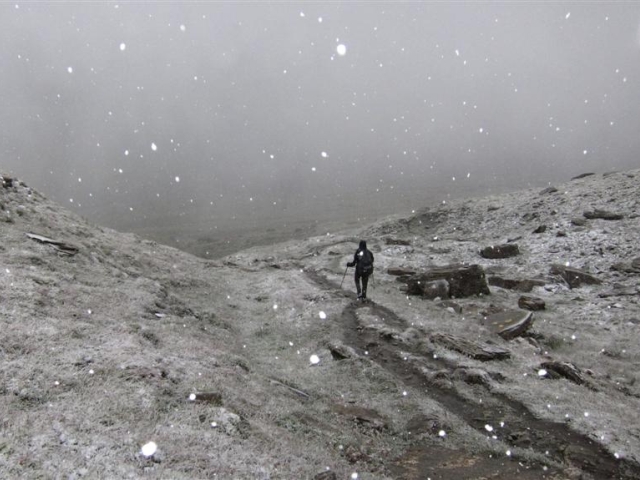
When to go? Our Tour du Mont Blanc season runs from the start of July to the middle of September.
This short season is imposed by the weather: the chance of late-Spring snow patches remaining into late June across the higher passes, and the chance of the weather deteriorating into late September. Because we can't predict the weather for the coming summer, we have to set these dates in advance.
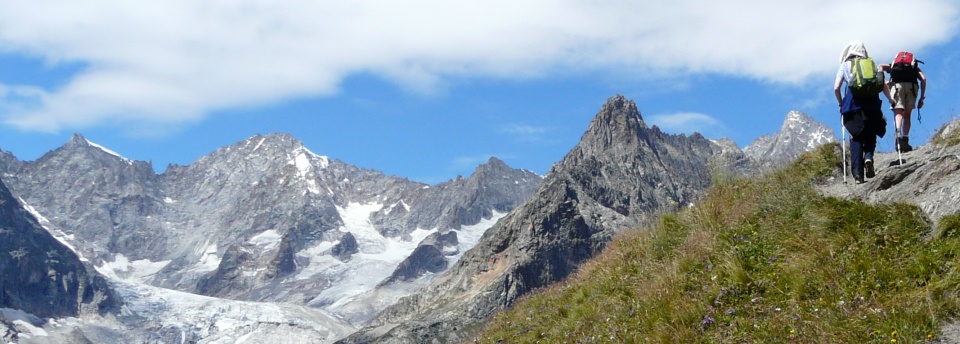
Where to stay
The TMB's accommodation is a major attraction of the route. At various points there are choices of mountain huts, campsites, luxurious hotels, more modest hotels, and auberges with a mix of rooms and dormitories.
Most accommodation is family-run, even in the larger places such as Courmayeur. Our TMB clients often volunteer how much they enjoy the variety of the places we book for them; we aim to give a true experience of the Alps and of the Tour du Mont Blanc. In Chamonix we book as standard our friendly and central hotels, for an unforgettable finish to the trip.
The huts on the TMB follow a common Alpine pattern, catering for big numbers of hikers in a practical and comfortable way. Dormitories are common, but private rooms are available in many of the huts too, subject to availability. (We will advise on the sleeping arrangements according to your particular schedule.) Showers are available, sometimes with a token system for a small extra payment to the warden. For food, expect a simple menu of large portions and plenty of cake, beer, coffee and soft drinks. Our standard Tour du Mont Blanc trip uses 4 welcoming huts, but we are always happy to put together 'hutty' schedules if you would like to see more of this side of the world of Alpine hiking!

City breaks after trekking
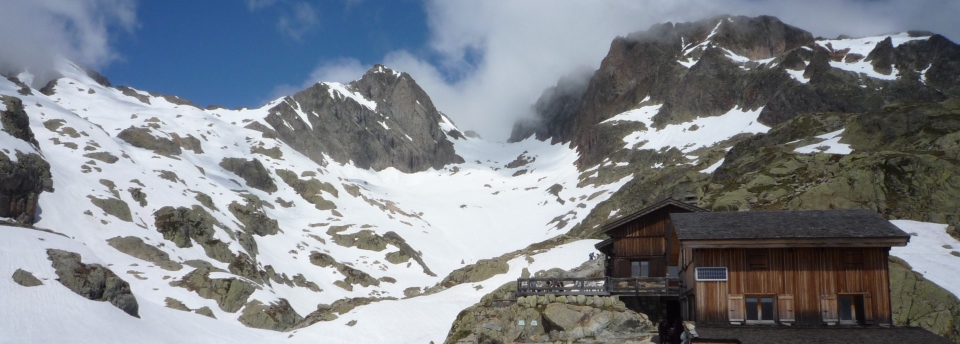
Here's a brief guide to the places and experiences on the TMB, on our normal 11-stage schedule.
Stage One We start in Les Houches , the village at the foot of the valley not far from Chamonix . (The TMB does not pass through Chamonix itself - all travel details are included in your joining notes.) The first climb, up to Col de Voza at 1,653m (5,423ft), is not too bad in the overall scheme of things, but may be a tough start for legs that have yet to fully warm up! At the col, the main route is a gentle descent to the Montjoie valley through the villages of Bionnassay, le Champel, la Villette, la Gruvaz and Tresse before the final pull up to Les Contamines . A good alternative, harder but with close views of the Bionnassay glacier, is the high-level route over Col de Tricot at 2,120m (6,955ft).
Stage Two From Les Contamines the route plots a course due South. Follow the Torrent le Bon Nant along forest tracks to the famous church of Notre Dame de la Gorge. Here the climbing begins! An initial ascent along a steep track, built by the Romans, brings you to the flat upper valley beyond la Rollaz; higher up, pass the Refuge la Balme and complete the main part of the climb, reaching Col du Bonhomme at 2,329m (7,641ft). A traverse round to the Col de la Croix du Bonhomme at 2,479m (8,133m) finishes the climbing - relax here to take in the new views to the South over the Beaufortain mountains. All that's left now is a grassy walk downhill to the hamlet of Les Chapieux .
Stage Three The next stage climbs and then descends to Rifugio Elisabetta . Along the way, the Italian border is crossed at the Col de la Seigne. Start the walk by climbing gently along a lane in the narrow trench of the Vallee des Glaciers, reaching the Refuge des Mottets. The climb to the Col starts here and is not too demanding. Arriving at the Col at 2,516m (8,255ft) the view ahead is of the highest scenic quality. It stretches as far as the Grand Col Ferret, 3 stages away, along the lengths of the Val Veni and Italian Val Ferret. On the left hand side of these valleys is the Mont Blanc massif in all its splendour, with the best view of Mont Blanc itself since leaving Chamonix. Drop down from the col to reach the Rifugio at the lip of the Vallon de la Lee Blanche, below a trio of glaciers.
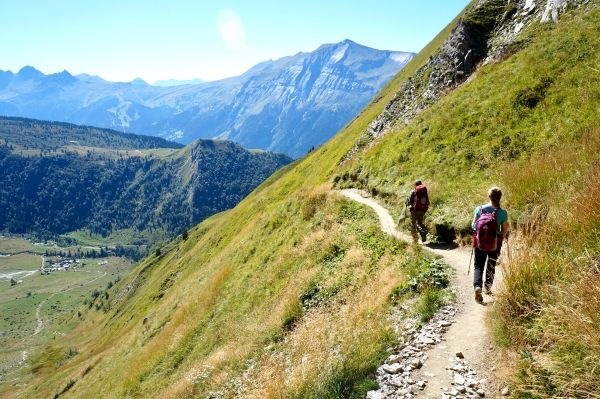
Stage Four Today's destination is the Italian resort of Courmayeur . Begin by descending towards Val Veni with the huge Glacier du Miage prominent to your left. The TMB takes a high route along the Northern slopes of Mont Favre in order to gain better views of Mont Blanc across the valley. From Col Checroui the TMB descends rapidly down steep ski runs to the village of Dolonne and then Courmayeur itself. Courmayeur is a bustling and lively town with all facilities and a noticeably Italian feel, in contrast to Chamonix and the settlements met on the route so far.
Stage Five The next stage, which has much climbing, passes Rifugio Bertone on the way to Rifugio Bonatti . Options exist to make this stage easier or harder. A highlight of the day, in fact of the whole Tour, is the traverse of the long grassy ridge of Mont de la Saxe which acts as a lookout for the Mont Blanc range opposite - while this is a variant rather than the main TMB trail, we recommend it over the lower 'Armina' route for its fantastic outlook. Cross Col Sapin at 2,436m (7,992ft) and Pas Entre Deux Sauts at 2,524m (8,281ft) before dropping down to the Rifugio. Named after the famous Alpinist Walter Bonatti this is a modern and comfortable hut known for its generous and delicious food. Its position on a grassy shelf opposite the Grandes Jorasses is enough to recommend it!
Stage Six Follow the recently re-routed TMB path from Rifugio Bonatti on a traverse of the hillside, before it begins the stiff climb to Grand Col Ferret. Glacier de Pre de Bar dominates the view to the North, flowing down from Mont Dolent on the border of France, Italy and Switzerland. At the Col at 2,537m (8,323ft) the whole of your Italian adventure can be seen, from its start at Col de la Seigne. Now you are in Switzerland. Begin by descending gently to the farm buildings of la Peule, then lower down to the Swiss Val Ferret. Pass the village of Ferret to arrive in La Fouly , a calm village amidst some of the most charming scenery of the whole trek.
Stage Seven Wander down-valley past meadows, the river (la Drance de Ferret) and through woods. Walk along the top of a wooded glacial morraine, the Crete de Saleina, arriving soon after at the village of Praz de Fort. Pass les Arlaches and Issert in the valley floor. So far today the route has been gradually downhill. Now start a gentle ascent all the way through woods to Champex and its high position in a saddle between the mountains le Catogne and la Breya. This stage is the easiest and lowest of the Tour, not crossing any passes, but it is full of charm.
Stage Eight Champex might be hard to leave with its picturesque lake and calming air. The TMB splits into two for the journey to Trient : the main route climbs through woods to the alp of Bovine at 1,987m (6,519m) while an alternative route climbs higher to the Fenetre d'Arpette at 2,665m (8,743ft). Neither route is easy, but the Fenetre route involves high, rocky walking that some will find especially tough. Arrive at Col de la Forclaz directly on the Chamonix-Martigny road, or drop to the quiet Swiss village of Trient in the valley.
Stage Nine Leaving Trient, pass the hamlet of le Peuty and begin the steep climb to Col de Balme at 2,131m (6,991ft). Once at the col the nature of the TMB changes remarkably, for now you are in the realm of Chamonix and all that that entails. The view to Mont Blanc is suddenly revealed upon reaching the Col, this time from the French side, and is one that will hopefully accompany you for the next two and a half stages. The peaks, needles and rocky spires of the massif will rearrange themselves throughout your walk to Les Houches. Back to the current stage, follow the Tour over the narrow ridge of Aiguillette des Posettes at 2,201m (7,221ft). Descend along the crest to Tre-le-Champ , a hamlet from which the views of Aiguille Verte are especially good. From here it is easy to reach Argentiere , the informal centre for the upper Arve valley.
Stage Ten The next two stages make the link to Les Houches and will see you walking high above the Chamonix valley. Climb from Tre-le-Champ into the Aiguilles Rouges nature reserve, giving one of your best chances to spot ibex (bouquetin) and chamoix. Pass the rock needle of Aiguillette d'Argentiere before climbing up the rocky hillside on ladders. Lac Blanc is a very worthwhile diversion. The climb to this famously scenic lake at 2,532m (7,717ft) can be incorporated into the stage or treated as an out-and-back. Either way, traverse further along the hillside to reach the hut and cable car station at La Flegere . This connects with Les Praz, between Chamonix and Argentiere in the valley below.
Stage Eleven Pick up the route at La Flegere and prepare yourself for a very scenic introduction to the day. For about 90 minutes your route takes you across the rocky hillside on an easy path, high above the forests on the North-West side of the Arve valley. Looking up at the hillside from the valley below, you wouldn't think it possible. The route follows the well-known Grand Balcon Sud. Reach the cable cars at Planpraz , connecting to Chamonix, and turn up towards Col de Brevent. Here the GR5 - from Lake Geneva to Nice - joins our route. The link from here to the summit of Le Brevent at 2,525m (8,284ft) is intriguing - it passes through a high rocky hollow and then along the steep hillside with a short section of ladders. The summit viewpoint is perhaps the best position yet from which to look at Mont Blanc, as well as the Col d'Anterne area to the North. The Brevent has a cable car link to Planpraz and Chamonix. The final part of the TMB is now beckoning, down rocky slopes past Refuge de Bellachat and further down into forests, arriving at Les Houches . This is the end of your trek!

The TMB in context
The TMB compared to treks in the UK Compared to most long-distance routes in the UK, the TMB has lower daily distances but more ascent. On the Coast to Coast route in England, for example, the average stage length is twice as long but most stages do not climb as much. An extra factor is that the TMB's altitude is higher throughout, as it is on most Alpine treks. (The highest point in England is under 1,000m whereas on the TMB even the valleys are around 1,000m!)
The TMB compared to the Walker's Haute Route and AV1 The TMB sits below the Alta Via 1 and the Haute Route in its difficulty. These are three of the classics of Alpine walking. Compared to the AV1, the TMB has more daily distance and elevation gain, but covers generally more hospitable terrain with fewer of the bold mountain settings and the steep drops to the side. The uphill walking tends to come in more concentrated chunks, with typical mornings being spent climbing to a pass, instead of the ascent being spread out during the day. Compared to the Haute Route, the TMB is notably less challenging, because the Haute Route is right at the top end of Alpine walking terrain.
Comparing our 5 big Alpine treks The Haute Route is substantially the toughest, suitable only for trekkers with particularly solid experience, balance and fitness.
The Via Alpina includes three rocky cols that approach the Haute Route's level of challenge, though the route as a whole is more forgiving. The same applies to the Adlerweg but in its case one col (the Eppzirlerscharte) stands above the rest as very difficult, and it can be skipped by descending and taking the train. The Adlerweg is notable for some long days on wide tracks.
The AV1 is more consistent in its difficulty but is especially demanding of good balance, with steep, rocky and wild situations calling for mountain experience.
The TMB is a superb all-rounder that mixes tough, solid mountain days with gentler ones, allowing trekkers to sample the harder terrain as at the Fenetre d'Arpette (a variant, shared with the Haute Route) while not requiring any extremes.
It's worth noting that each trek has different possible schedules, governing the physical difficulty, and on many days different variants affect the terrain difficulty.
Below we compare the stats of our 5 big trips:
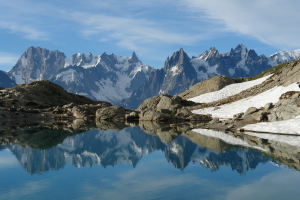
Hike the Tour du Mont Blanc with Alpine Exploratory
Alpine Exploratory offers four self-guided options for the TMB, plus one guided trip. As well as the full circuit from Chamonix we offer half-routes which we call North and South. These end and start, respectively, in the roughly half-way resort of Courmayeur. Our weekend trip explores the final 3 sections of the trip high above Chamonix. We're also pleased to book shorter or longer sub-sections of the route according to your available dates. Please contact us to discuss options.
Our self-guided holidays give you what you need to complete the route under your own steam. We book your accommodation in a mix of hotels, huts and auberges and we give you our detailed routecards, the local maps, and lots of notes. Importantly we will advise on the ideal schedule and accommodation to suit your approach to the TMB. Our guided trips are similar but give you the benefit of an Alpine Exploratory leader to show the way.
Please ask us any time for more details. Please feel free to describe your walking experience and preferences, and we'll suggest which trek you might enjoy most.

Alpine Exploratory Alpine Exploratory is a system of knowledge on the best mountain trekking in our areas, giving clients superb holidays based on this exploration. About us
Trek with us in the Alps, Scandinavia, UK or Ireland. Go self-guided or join a guided trip.
We research and interpret the trail to give you the finest walking holiday.
Alpine Exploratory is a system of knowledge on the best mountain trekking.
UK Edition Change
- UK Politics
- News Videos
- Paris 2024 Olympics
- Rugby Union
- Sport Videos
- John Rentoul
- Mary Dejevsky
- Andrew Grice
- Sean O’Grady
- Photography
- Theatre & Dance
- Culture Videos
- Fitness & Wellbeing
- Food & Drink
- Health & Families
- Royal Family
- Electric Vehicles
- Car Insurance Deals
- Lifestyle Videos
- UK Hotel Reviews
- News & Advice
- Simon Calder
- Australia & New Zealand
- South America
- C. America & Caribbean
- Middle East
- Politics Explained
- News Analysis
- Today’s Edition
- Home & Garden
- Broadband deals
- Fashion & Beauty
- Travel & Outdoors
- Sports & Fitness
- Sustainable Living
- Climate Videos
- Solar Panels
- Behind The Headlines
- On The Ground
- Decomplicated
- You Ask The Questions
- Binge Watch
- Travel Smart
- Watch on your TV
- Crosswords & Puzzles
- Most Commented
- Newsletters
- Ask Me Anything
- Virtual Events
- Betting Sites
- Online Casinos
- Wine Offers
Thank you for registering
Please refresh the page or navigate to another page on the site to be automatically logged in Please refresh your browser to be logged in
Tour du Mont Blanc: The complete travel guide to Europe’s popular long-distance walk
If you relish hiking 18km a day at altitude in all weathers for days on the trot, the tmb offers a classic adventure, writes margaret batty, article bookmarked.
Find your bookmarks in your Independent Premium section, under my profile

Sign up to Simon Calder’s free travel email for expert advice and money-saving discounts
Get simon calder’s travel email, thanks for signing up to the simon calder’s travel email.
“Top Ten Hikes of the World” lists always feature the Tour du Mont Blanc (TMB). And rightly so; it loops 170km (106 miles) around Mont Blanc, the highest mountain in western Europe which is 4,810m (15,781ft), traversing not one but three countries: France, Italy and Switzerland. Vistas around the Tour du Mont Blanc are superlative and, with a lung-busting 10,251m (33,631ft) meters of ascent, they will, quite literally, take your breath away.
Mont Blanc is surrounded by seven valleys radiating from its core. The TMB links them all via high mountain passes. Chunk the trail down into 11 sections and it starts to form the energetic backbone of a superb two-week holiday. You can start and end anywhere and walk in either direction. The French resort of Chamonix is a logical start/finish point and most people walk the trail in an anti-clockwise direction. The main trail is well sign-posted and is not technically difficult (but avoid “variant” options involving chains and crampons). The TMB does not summit Mont Blanc itself, however: that is an entirely different mountaineering adventure.
How long does it take?
There is a rare breed of ultra trail endurance runners who complete the TMB non-stop in a phenomenal sub-20-hour annual event. These are world-class athletes with lungs and legs that defy science. Lesser mortals, ie competent, fit walkers, take nine to 11 days to complete the whole circuit.
The Mont Blanc road tunnel slices through the mighty mountain, offering hikers an easy option to split the TMB over two holidays using local coach services to and from Chamonix and Courmayeur (eg year one trek Chamonix to Courmayeur, the following summer complete your circumnavigation from Courmayeur to Chamonix).
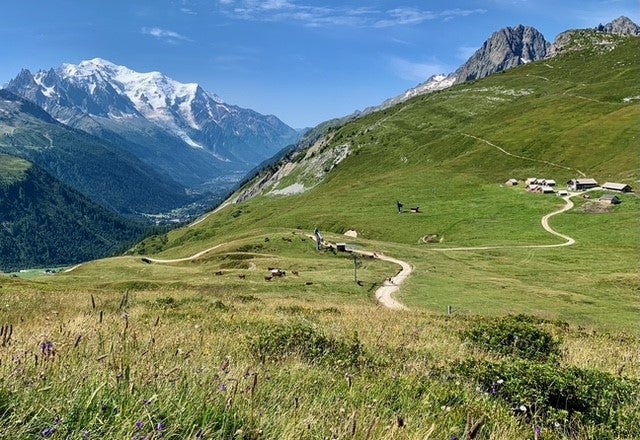
If you don’t want to commit to the whole TMB, base yourself in Chamonix and tick off a few sections of the route, using local transport each day.
11-day itinerary
Sample daily itineraries: +/-18km (11 miles) distance/1,000m (3,280ft) ascent/6-8 hours walking
Day 1: Chamonix Les Houches (Bellevue cable car) to Les Contamines, France
Day 2: Les Contamines, via Col de la Croix Bonhomme is 2,476m (8,123ft), to Les Chapieux
Day 3: Les Chapieux (valley bus), via Col de la Seigne is 2,516m (8,254ft), to Refugio Elisabetta, Italy
Day 4: Elisabetta to (Dolonne cable car) Courmayeur, Italy
Day 5: Courmayeur to Lavachey, Switzerland
Day 6: Lavachey, via Grand Col Ferret is 2,537m (8,323ft), to La Fouly, Switzerland
Day 7: La Fouly to Champex, Switzerland
Day 8: Champex to Forclaz, Switzerland
Day 9: Forclaz, via Col de Balme is 2,191m (7,188ft) to Le Tour, France
Day 10: La Tour, via Col des Montets, to Flegere, France
Day 11: Flegere, via Brevent is 2,368m (7,769ft) to Les Houches Chamonix, France
How to plan a trip
The TMB does present logistical challenges, but overcoming them is all part of the fun.
You can plan your route and reserve most refuges using one incredibly useful website, autourdumontblanc.com , enabling you to join the dots between each day’s walk.

As you plot your itinerary, bear in mind that walking at altitude can impact stamina and sleep quality, and that the ascent profile of a walk is as important as the distance. Alpine guides indicate the typical number of hours per walk as a good benchmark of effort required. Before you go, practise long, hilly, multi-day walks, with a loaded backpack.
If you’d like hiking buddies or an expert guide, organised group trips are also available (eg exodus.co.uk , keadventure.com ). Some even offer luggage transfer.
Mid-June til late September is TMB season. The main snow melt ends in June, long summer days are a bonus, Alpine flower meadows peak in July and, come September, summer tourists are replaced by glorious autumnal colours.
If you yearn for solitude, avoid the week of the annual Ultra Tour du Mont Blanc event (28 August 2023), when Chamonix and the TMB trail will be ultra-busy, with 10,000 runners and their supporters zipping around.
Packing list
- Quality trail boots
- Collapsible trekking poles
- Sunhat, sunglasses and sun lotion
- Water bottles and energy bars
- Basic first aid kit and blister repair
- Euros: many refuges are cash-only and lack wifi
- Flip-flops and dry, warm kit for evenings
- Sleeping bag/liner
- Earplugs to block out noisy bunk companions
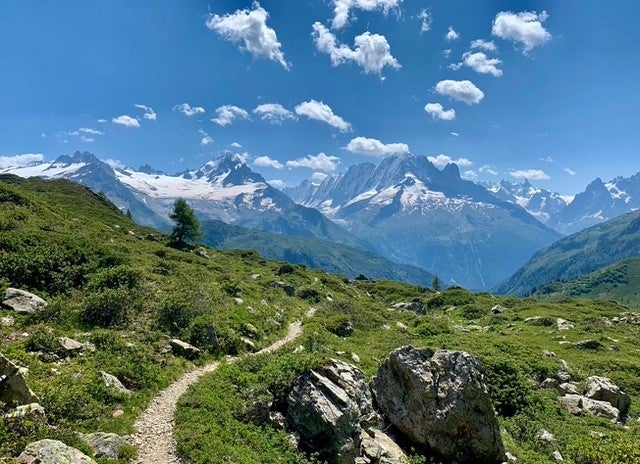
Delight in the rustic charm of ‘refuge’ mountain huts. You’ll be thankful for their warmth, chilled beers, hot meals, and beds. Some refuges offer private rooms, although most have mixed-sex bunk dormitories; all have shared bathrooms and water (sometimes hot!). Bed and half board costs around €60-80 (£53-71). But it’s impossible to put a true price on the experience of staying in these off-grid, remote locations, nestled amid extraordinary Alpine scenery, with sublime starry skies.
Where the trail touches the resorts of Chamonix, Les Contamines, Courmayeur and Champex, you can swap these stripped-back stays for normal hotels.
It helps to like cheese on the TMB. A hunk of Comte and baguette for lunch? Tartiflette (melted cheese, potatoes, and ham) for supper? “La Vache Qui Rit”, soft, triangular cheese, for breakfast? And repeat... This is Savoie mountain food. You won’t go hungry, and you won’t have to carry much with you. Refuges ensure hikers are fuelled up with breakfast, supper and packed lunches.
Highlights of the TMB
- The views. Impossible to pick one (Col de Balme? Col de la Seigne? Val Ferret?). Each day will reveal stunning scenery: vertiginous mountains, ancient glaciers, and snowy 4,000m (13,123ft) peaks.
- The simplicity of the daily TMB rhythm is a tonic: life slowed to a walking pace, mountain air, summer pastures filled with wildflowers and jingly cowbells.
- Meander through three European countries, witnessing rural life in traditional mountain communities.
- Experience warm camaraderie between fellow hikers relaxing in remote mountain refuges.

- Underestimate the TMB at your peril. You’ll be climbing more than the equivalent trek to the summit of Everest.
- Book accommodation early (especially Les Chapieux), ideally before Easter.
- Acclimatise in the Alps for a day or so and consider a rest day in Courmayeur.
- Don’t overpack, aim for 10kg maximum.
- Use cable cars where they make sense (unless you’re a route purist).
First up, treat your weary body to a luxury spa in Chamonix when you finish. QC Terme is bliss. Indulge in a Brasserie du Mont Blanc beer on a cafe terrace by the glacial River Arve, and be sure to take a celebratory ride up the Aiguille du Midi cable car. From Chamonix, the distinctive red cable car shoots up to a giddy 3,842m (12,604ft), seemingly within touching distance of Mont Blanc itself. Survey your route around the massif. This is the 360-degree panorama to beat them all. Mission accomplished.
“Holiday” doesn’t do the TMB justice: the post-trek sense of accomplishment is profound and will leave a lifelong imprint.
Getting there
Chamonix is accessible by flights to Geneva and onward by a 90km (55 miles) mini-bus transfer from the airport. Chamonix is also connected by train, via the scenic Mont Blanc Express Railway.
Join our commenting forum
Join thought-provoking conversations, follow other Independent readers and see their replies
Subscribe to Independent Premium to bookmark this article
Want to bookmark your favourite articles and stories to read or reference later? Start your Independent Premium subscription today.
New to The Independent?
Or if you would prefer:
Want an ad-free experience?
Hi {{indy.fullName}}
- My Independent Premium
- Account details
- Help centre
You are using an outdated browser. Please upgrade your browser or activate Google Chrome Frame to improve your experience.

- Trip Styles
- Destinations
Hiking the Tour du Mont Blanc
- All Inspiration and Destinations
- Canadian Rockies
- New Hampshire
- New Zealand
- North Carolina
- Vancouver Island
- Washington State
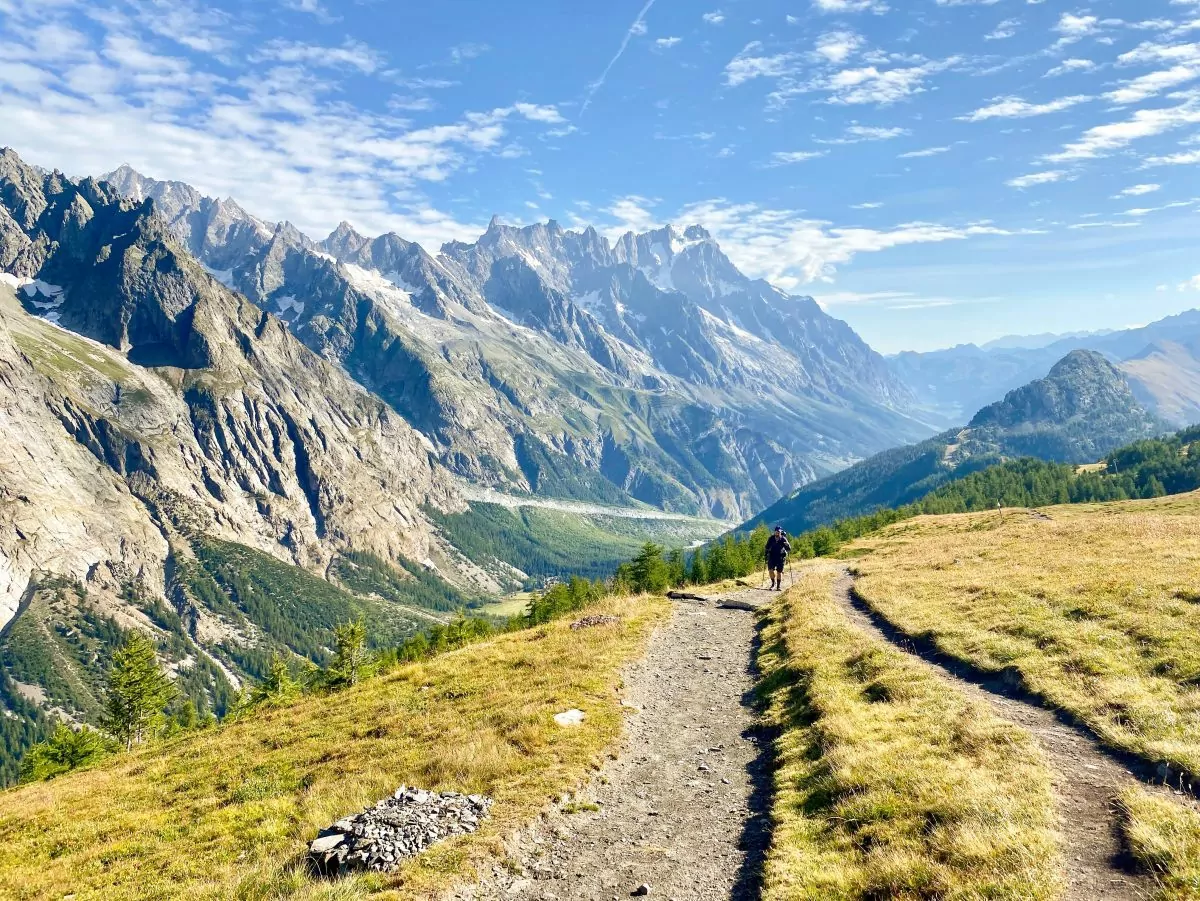
Photo by Ana Frantz on Unsplash
The Tour du Mont Blanc is a popular hiking trail in Europe that stretches 170 kilometers (106 miles), through France, Italy, and Switzerland. The Mont Blanc Trail traverses through one of the most impressive and beautiful ranges in the world, and it’s a relatively accessible trail for anyone in good shape. The hike is also a dream for foodies, as it allows you to explore new foods in different villages and hamlets throughout three countries. Hiking the Tour du Mont Blanc is a bucket list item for many backpackers, and for good reason.
Between the stunning landscape, inclusive trail, and customizable experience, the Tour du Mont Blanc offers an adventure unlike any other in Europe. If you’re looking for a unique, challenging experience to remember for the rest of your life, you need to hike this trail. Here are some of the reasons you should add this experience to your bucket list:
- Hike through three countries: The hiking trail of the Tour du Mont Blanc extends through three European countries: France, Italy and Switzerland.
- A good option for beginners: Many hiking tours around the world are challenging , even for seasoned hikers. However, the Mont Blanc trek is special because it’s doable for anyone who is reasonably fit. There are 17 towns, along with several other smaller villages, along the route, so there are plenty of places to stop, see the sights, eat a hot meal and get some rest before you continue on your way.
- Adjustable routes and lengths: While there is an “official” route that many hikers and tours follow, there are plenty of variations to choose from, depending on the desired length and difficulty. Generally, hiking the entire route at a reasonably comfortable pace takes about nine to 11 days. However, some routes will only take about two to five days, following a small portion of the trail. Meanwhile, some advanced hikers have been known to hike the whole route in just a few days.
- Breathtaking views: Magnificent sights, like glaciers, meadows, lakes, mountains and wildlife surround the route. High points like the Fenêtre d’Arpette and the Col des Fours are sure to take your breath away, as they allow you to admire your surroundings in all directions as far as you can see.
Hike Tour du Mont Blanc with Award Winning Guides
What to Expect When Hiking the Tour du Mont Blanc
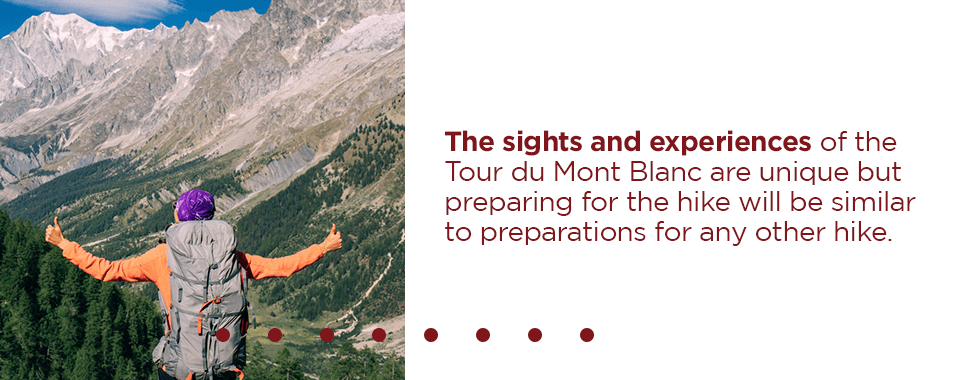
The sights and experiences of the Tour du Mont Blanc are unique but preparing for the hike will be similar to preparations for any other hike. Generally, there’s no need to pack more than a day’s worth of supplies, as the towns and villages are relatively close together on the path. Water is also readily available, whether it’s naturally occurring from springs or at a resupply stop.
Before you set out on your journey, there are a few things about the trail you need to consider, including:
Due to the high altitude and the extreme weather in the colder months, the besttime to hike Tour du Mont Blanc is in June or September, when the weather is slightly cooler, but the trails and towns are quieter and less busy. Families are less likely to go during these months because school is in session. The temperature generally ranges from 8 degrees Celsius (46 degrees Fahrenheit) to 20 degrees Celsius (68 degrees Fahrenheit).
July and August are also good months to go, but the weather is much hotter and the trails will be much more crowded. During the peak of summer, the temperature on the mountain can get up to 22 degrees Celsius (72 degrees Fahrenheit). If you’re looking to see the most foliage and mountain flowers, late June and early July are the best times to go.
Annually, the region gets about 1073 mm (42 inches) of rainfall. Afternoon thunderstorms are most common in the summer months, while September is usually the driest.
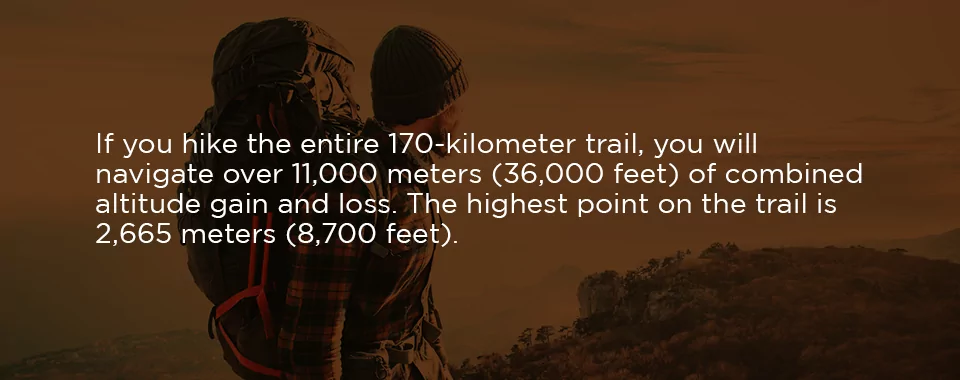
If you hike the entire 170-kilometer trail, you will navigate over 11,000 meters (36,000 feet) of combined altitude gain and loss. The highest point on the trail is 2,665 meters (8,700 feet). Since altitude sickness can kick in at about 8,000 feet (2,400 meters), you may start to feel sick at some of the higher points. Altitude changes can make things a bit challenging. A rapid increase or decrease in altitude can lead to altitude sickness and symptoms including dizziness, headaches, nausea and fatigue. However, traveling at a reasonable pace can help prevent sickness.
The route is relatively easy to navigate, as the trail is well-marked with signs. If you already do some form of exercise a few times per week and regularly walk or hike, you shouldn’t have a problem hiking the trail.
One particularly difficult part of the hike involves climbing a series of ladders up a steep mountainside. The ladders are just past Col du Montets, and are a popular spot for photos. If the ladders are too much to handle, you can take an alternative route, just down the path.
Basecamps vs Camping Out
There are two types of accommodations you’ll find on the Tour du Mont Blanc:
- Basecamps: The more than 50 official accommodations along the trail are usually the easiest and most comfortable options. They are popular with tour groups. Accommodations range from full-service hotels and lodges with private bedrooms and bathrooms, restaurants and spas, to dorm-style basecamps with shared bathrooms.
- Camping out: Another option is to bring your shelter with you and camp out. Camping is a much cheaper option, although some areas charge a fee. Camping out is only recommended for experienced hikers, since it requires you to carry more weight throughout the trip. You’ll have to carry your tent, sleeping bag and other gear from place to place.
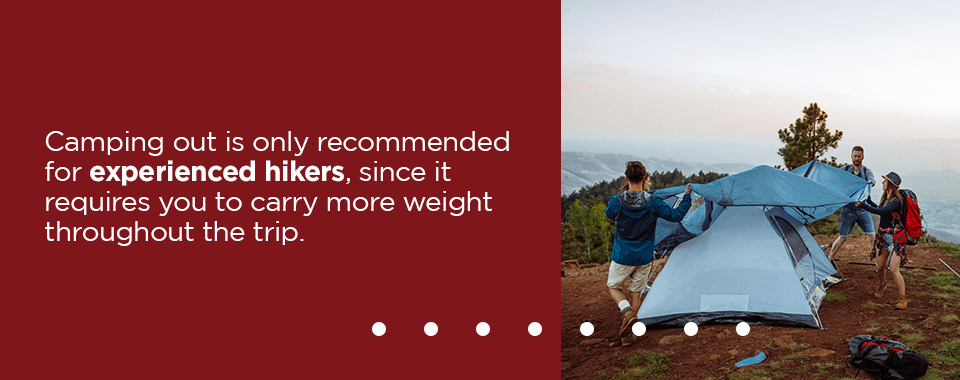
Top Rated Alps Hiking Tours
Tour du Mont Blanc Itinerary and Sights to See Along the Way
Once you know what to expect, you can start planning your adventure. Make sure you give yourself plenty of time at each place and that you’re able to see as many attractions and sights as you wish.
There are many ways to see the Tour du Mont Blanc. You can hike the trail by yourself or with a guided tour. If you decide to take a tour, your trip itinerary might look something like this:
France: Days 1-3
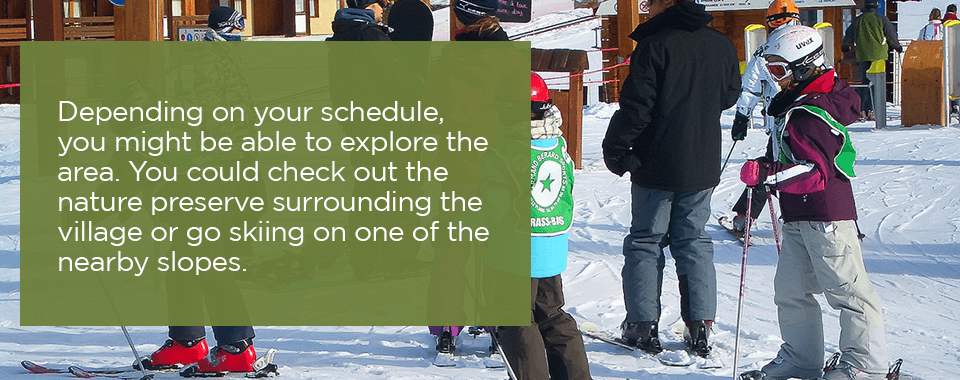
The first day of the trip will likely start in the village of Les Houches in France. Depending on your schedule, you might be able to explore the area. You could check out the nature preserve surrounding the village or go skiing on one of the nearby slopes.
The second day of the trip will be your first experience trekking through the Alps. You’ll start with a cable car ride high into the mountains. Then, you’ll start hiking through the deep conifer forests above Bionnassay Valley and the quaint alpine hamlets with stunning views of Mt. Blanc.
You’ll see two iconic mountains, the Aiguille de Bionnassay and the Dôme du Gouter, and a massive glacier between the two peaks. Then, you’ll descend through a series of switchbacks to Chalet de Miage, and eventually to Les Contamines, where you’ll stay the night. In this ancient village, one of the main attractions is a world-class ski resort, where you can ice climb, go tobogganing, ride dog-sleds and of course, ski. Les Contamines is also known for Patrice Dominguez Park, a popular destination in the summer for swimming, tennis, horseback riding and archery.
After a delicious breakfast in Les Contamines, you’ll start the next leg of your trip. You’ll begin with a brief shuttle to Notre Dame de la Gorge. The biggest highlight of the day is the Aiguille des Glaciers, a peak of the Mont Blanc massif that is completely covered by ice. Finally, you’ll make your way down to the Chapieux Valley towards Bourg Saint Maurice, where you’ll spend the night.
Italy: Days 4-5
On the fourth day of the trip, you take a short shuttle from Bourg Saint Maurice to Ville des Glaciers, where you’ll start your journey into Italy. Then, you’ll begin your descent into Val Ferret, a lush alpine valley on the Italian side of the border.
You’ll then take a bus from La Cantine de la Visaille to Courmayeur, where you’ll stay for the night. If you have time, try to explore Courmayeur. It’s home to one of Italy’s best ski resorts and to the Alpine Botanical Garden. It also offers a gorgeous, panoramic view of Grandes Jorasses, a mountain that lies on the border of France and Italy.
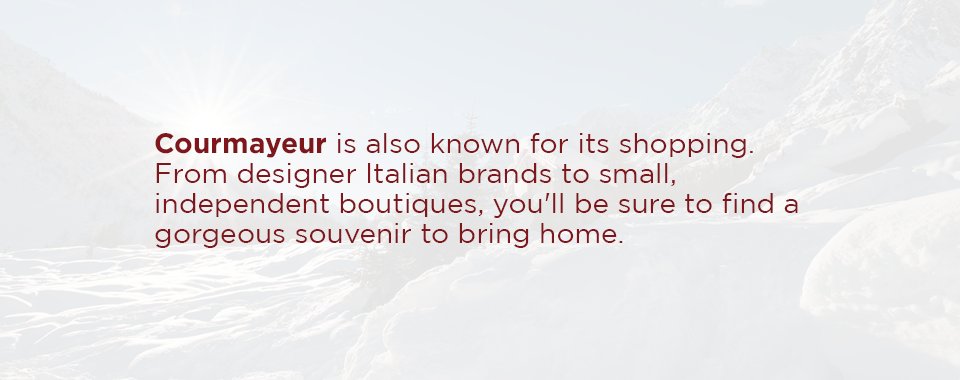
Courmayeur is also known for its shopping. From designer Italian brands to small, independent boutiques, you’ll be sure to find a gorgeous souvenir to bring home. Another popular attraction is the Skyway Monte Bianco cable car, which rotates 360-degrees as it travels towards the Punta Helbronner station.
The fourth day of the trip starts in Italy and ends in Switzerland. You’ll begin by crossing the gorgeous mountain pass, Grand Col Ferret, and arrive in a small village called La Fouly in Switzerland. Throughout the hike, you’ll see stunning views over the massif of Combins in the East and on the Italian side of Mont Blanc. Then you’ll take a shuttle to a small, French-speaking Swiss village called Champex.
Switzerland: Days 6-7
Before you set out on the next leg of your hike, be sure to check out Champex, where you can taste some Swiss wine, rent a boat to take out on Champex-Lac, or go skiing down one of the nearby slopes. You could also visit the Musee de La Fondation Pierre Gianadda, a world-famous museum just a few miles outside of town. There, you’ll be able to see permanent exhibits like the Automobile Museum and the Gallo-Roman Museum, plus plenty of other temporary displays.
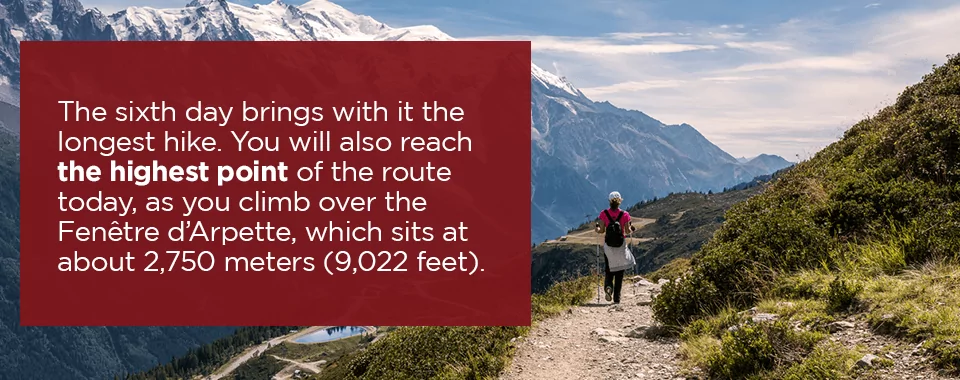
The sixth day brings with it the longest hike. You will also reach the highest point of the route today, as you climb over the Fenêtre d’Arpette, which sits at about 2,750 meters (9,022 feet).
On the seventh day, you’ll circle back around to France. You’ll start by going up and over Col de la Balme with fantastic views of Mont Blanc and Aiguille Verte. You’ll end in the iconic French Alps village of Argentières. Once you arrive, you can explore the charming town and maybe take part in some skiing, snowboarding or snowshoeing. You’ll also be able to find some delicious French cuisine here as you rest up for the last leg of your trip.
Return to France: Day 8
The eighth day will likely be the last day of heavy hiking through the Alps . You’ll start by hiking up and over the Balcon des Aiguilles Rouges, the “Balcony over the Red Peaks,” then climbing Lac Blanc. As you descend, you’ll pass through the hamlet of Le Praz and eventually find yourself hiking into Chamonix.
After a much-deserved long night of rest, you can choose to stay in Chamonix and explore the sights and attractions nearby.
One popular spot is the Aiguille du Midi, a nearby mountain you can travel to via cable car. In about 20 minutes, the cable car will take you up the mountain, where you can see a stunning, 360-degree view of the surrounding Alps. Once you’re at the top, you can stand in a glass case over the precipice, stop by the souvenir shop, eat at the “3,842-meter restaurant, ” or take a gondola ride over the Glacier du Géant to the Pointe Helbronner in Italy.
There is also a bustling cafe and pub scene in Chamonix. After a long day of hiking and seeing the sights, stop by Le Matafan for some traditional French cuisine or the Bighorn Bistro & Bakery for a smaller snack.
Finally, you’ll want to take a ride on the cogwheel train before you depart from Chamonix. The famous railway leads to the Montenvers site, where you can see the iconic glacier, the Mer de Glace. Once you’re there, you can also take a tour of the Grotte de glace, or ice cave, which takes you into the heart of the massive glacier.
How to Prepare for the Tour du Mont Blanc Hike
As your trip gets closer, you’ll need to seriously consider what you’ll bring with you. If you’re a beginner, you might need some assistance figuring out what to pack. If you’re using professional Tour du Mont Blanc guides, they will likely provide you with a list of everything you’ll need for your specific trip.
Basic Prep Tips
To prepare for such a long trip, you’ll need to consider a number of factors, including:
- Language barriers : You can usually get away with only speaking English in most major cities in France, Italy and Switzerland. However, you’ll only be passing through small towns and villages on the Tour du Mont Blanc. So, a basic knowledge of French and Italian will be extremely helpful during your trip. There’s no need to become fluent, but learning basic words and phrases will make your trip much easier.
- Jet lag : Depending on where you’re traveling from, you may experience jet lag upon arrival. However, you’ll likely need to start hiking on the first or second day or your trip. This can be especially difficult if you’re suffering from sleep deprivation. Consider arriving in France a few days before you start hiking so your body has time to adjust.
What to Pack

Your packing list might vary if you’re using a tour guide or camping out, but there are a few essentials everyone should bring. Before you begin your journey, make sure you have:
- Travel documents: You need your passport when traveling to Europe. Keep yours in a safe location during the hike.
- Travel equipment: You might want to pack outlet adapters so that you can charge your devices at your accommodations. A travel wallet and luggage locks can help to keep your stuff secure.
- Travel clothing: Aside from your hiking clothes, be sure to bring a few sets of travel clothes, depending on how much time you’ll spend traveling. These should be comfortable, easy-to-remove items that are layered so you can adjust as the temperatures change.
- Hiking clothing: While hiking clothes will vary from person to person, you will need to bring several sets for all weather conditions. Be sure to have something for hot weather, cool weather, sunny weather and rain. You’ll also need a hat, bandanna, sunglasses, gloves and gaiters.
- Hiking gear: High-quality gear is essential. You’ll need a day pack with a cover, waterproof hiking boots that have been thoroughly worn in, a headlamp with spare batteries and trekking poles.
- Personal items: The list of personal items varies the most from person to person, so be sure to tailor it to fit the needs of your trip. You’ll likely need water bottles, a camera, insect repellent, binoculars, cellphone with waterproof case, hand and toe warmers and a book.
- Toiletries: Depending on your chosen accommodations, you might need some toiletries for your trip, like sunscreen, toothpaste and a toothbrush, feminine hygiene products, soap, shampoo and conditioner, deodorant and prescription medications.
Additional Packing Tips
Some other things to consider while packing:
- Pack essential items, like your passport, glasses, medications, money and a change of clothes in your carry on, in case your checked luggage gets lost.
- Depending on the time of year, you might want to have an umbrella handy for brief rain showers. It’s much easier to open an umbrella for a short time, rather than stop and put on all your rain gear.
- Be sure to break in your hiking boots long before you start hiking. Test out which combination of socks are best beforehand and bring moleskin or large bandages for blisters.
- Bring both Euros and Swiss Francs with you. Most vendors on the trail only accept cash.
Training for the Hike
To prepare for hiking Tour du Mont Blanc, you’ll need to focus on strength and endurance. Condition your body to keep a solid pace for several hours per day to prepare your body for the trip. If you’ve never done a hike before or it has been a while, you might want to schedule a physical with your doctor to make sure you’re in good enough shape for the trek.
If you can, practice hiking with significant elevation gains and losses for several hours or days at a time. Always account for the weight of the pack. Make sure you’re wearing a pack that holds a similar weight to the one you will wear on the trail to get your body accustomed. If you live in a flat area, focus on cardio workouts and strength training. Activities like running, swimming and biking are great ways to work out your legs, core, shoulders and back.
At a certain point in your trip, you may encounter a series of ladders. While this part of the hike is optional, many hikers attempt to climb them without the proper training or experience. Climbing up vertical ladders can be challenging for even the most in-shape hikers, especially after a long hike. To prepare for this, try adding an upper torso workout after a long cardio session.
Tour Mont Blanc With Wildland Trekking
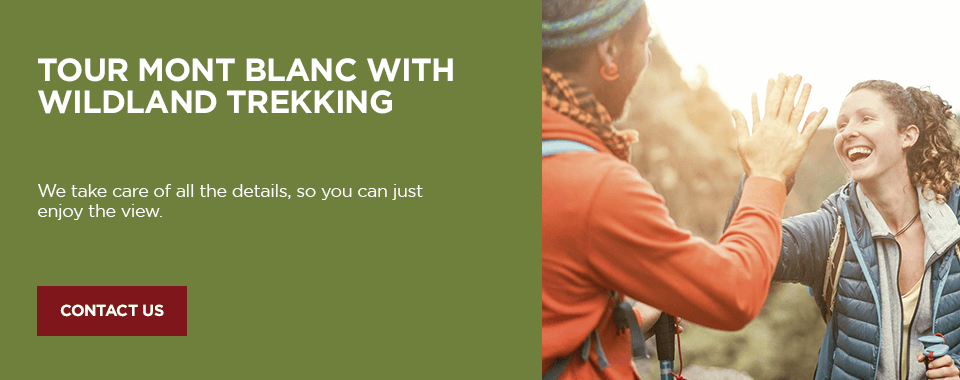
From Chamonix to Courmayeur, the Mont Blanc hike is breathtaking. The best way to hike Mont Blanc is with Wildland Trekking.
Our route takes us through deep valleys, over high passes, and into quaint European mountain villages. With Wildland Trekking, we take care of all the details, so you can just enjoy the view. We promise to provide a quality guide, high safety standards, natural and cultural history, great cooking and great gear to make sure you have the best adventure possible.
For the adventure of a lifetime book a Wildland Trekking tour today.
About WildlandTrekking

Wildland Trekking, a home-grown USA adventure travel company started in 2005, has become one of the world’s leading trekking companies. Learn about the origins, mission and people of Wildland, America’s #1 source for Unforgettable Hiking Vacations!

wildland Wires
Sign up to receive our exclusive Wildland Wire emails and stay up to date with Wildland Trekking's promotions, discounts, contests, outdoor tips and tricks, trip reports and more!
Welcome to the Tour du Mont Blanc (TMB)
3 countries, one identity, 10,000 m in altitude and about 60 hours of walking, 170 km of discovery for a total of 10 days of satisfaction!
Online bookings of huts, rooms, hotels
Trails conditions
The Tour du Mont Blanc trail conditions
The itinerary of the TMB and trail stages
The hikers diary
The Tour du Mont-Blanc hikers diary

Summer 2024: good practices in the Nature Reserves
Get ready to go.
The route, the safety, the conditions, the equipment: everything you need to know about the Tour du Mont-Blanc
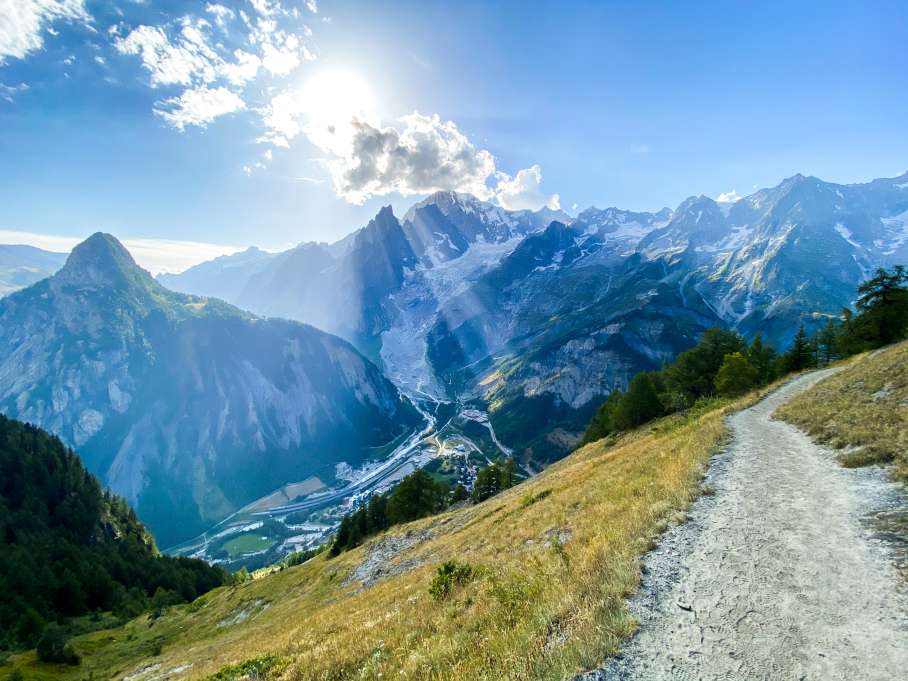
The TMB and the trails around Mont Blanc
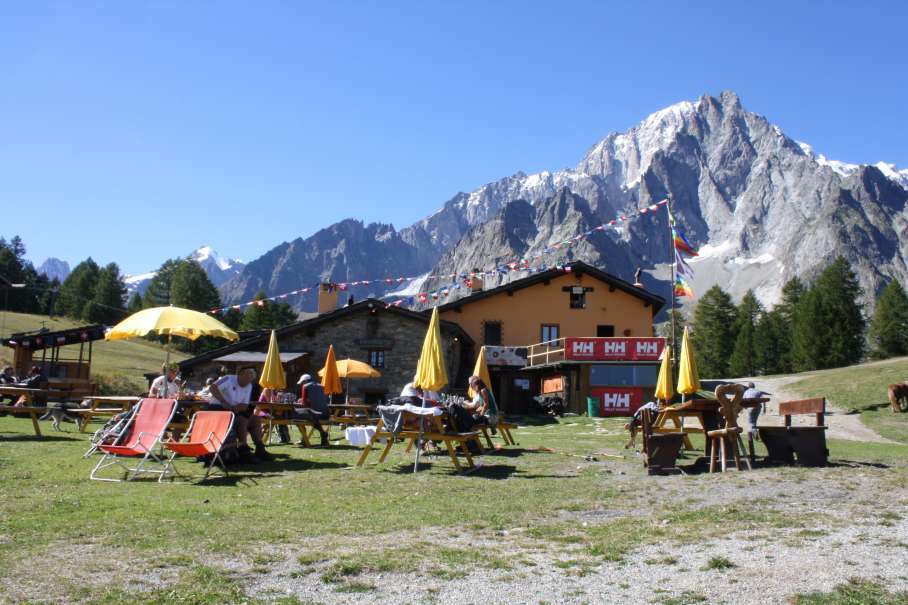
Accomodations
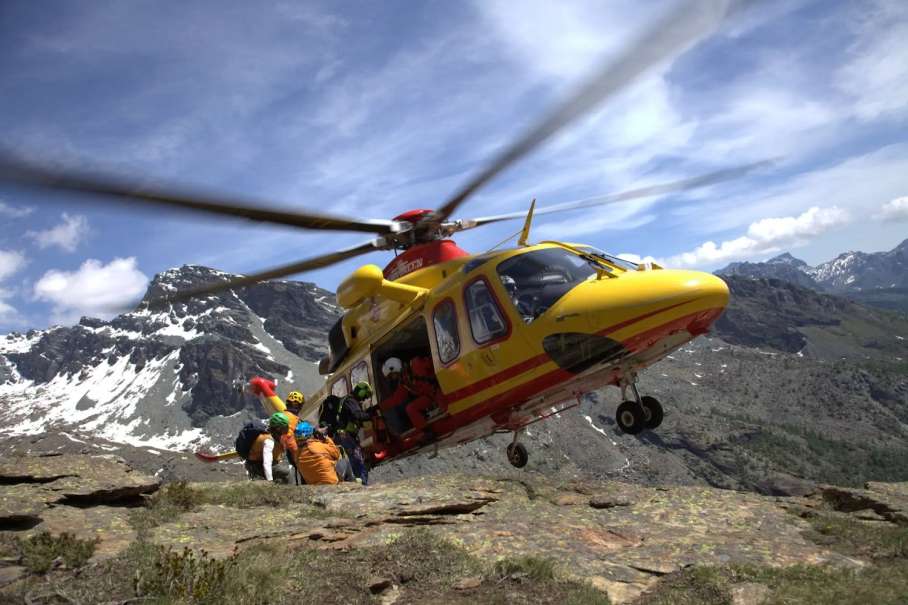
Cartography
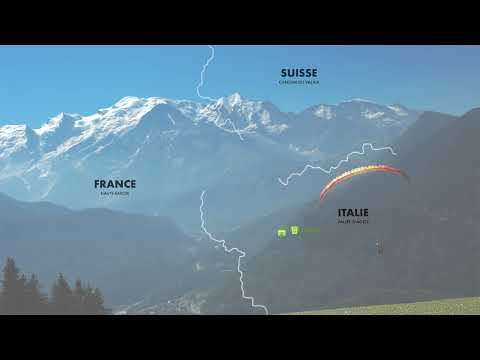
8 wonders around Mont Blanc
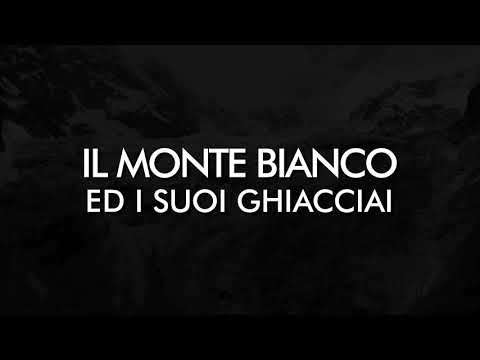
Il Monte Bianco ed i suoi Ghiacciai
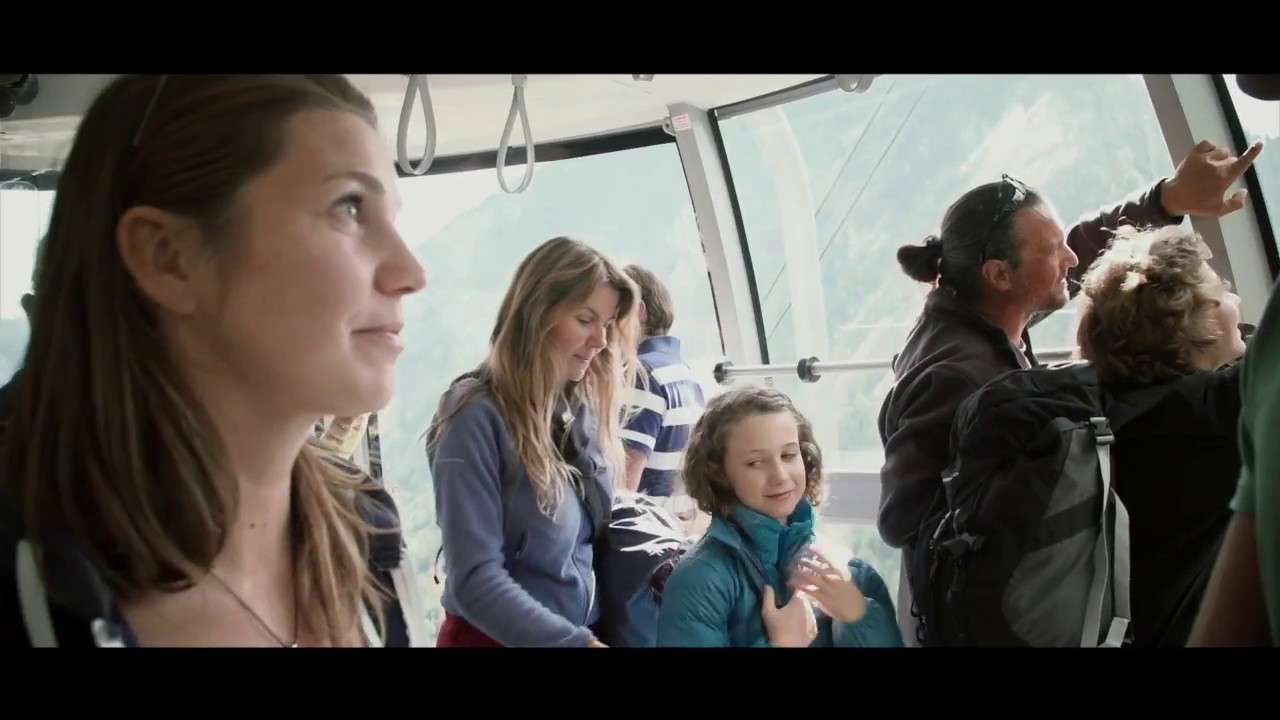
Video Tutorial Summer
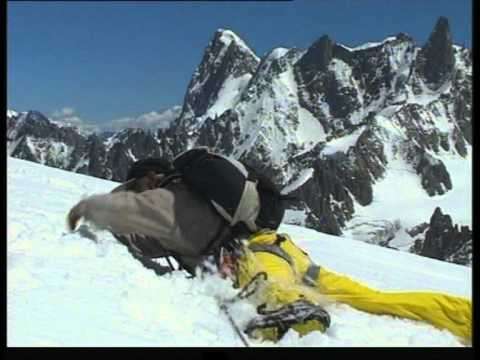
Prudence - Sécurité en montagne par la Chamoniarde
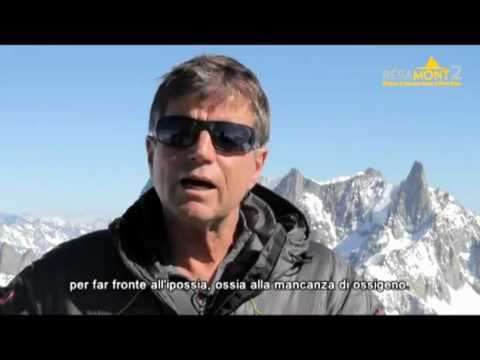
Age and altitude
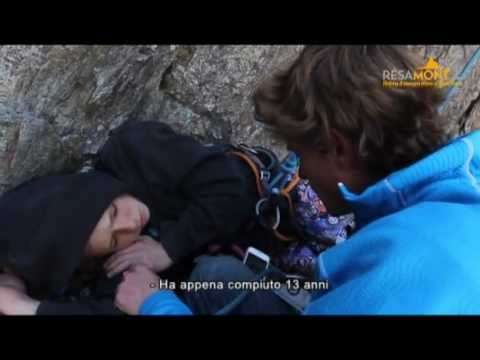
Telemedicine
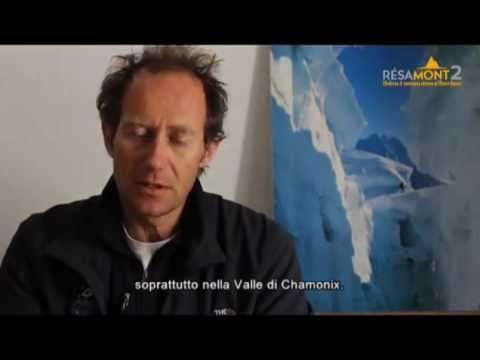
Séjours Transfrontaliers Espace Mont Blanc 2013
A collection of videos on the theme of the mountains
Come and discover the paths around Mont Blanc
Tour du Mont Blanc
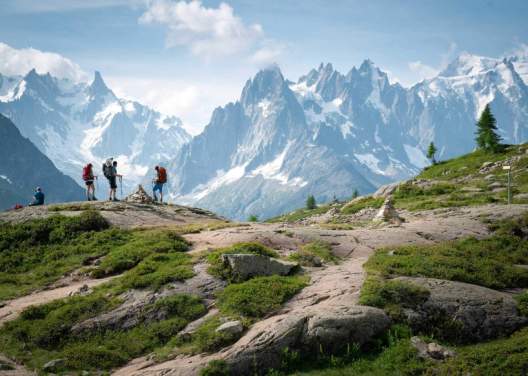
Alpage de Porcherey
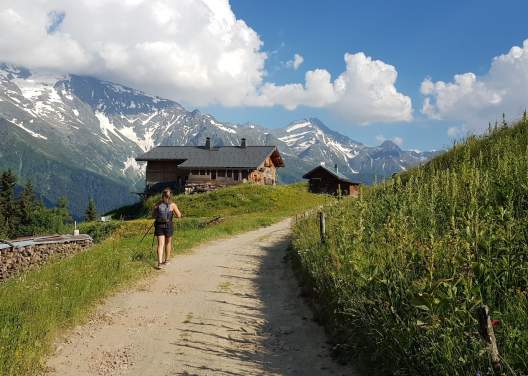
Alpage de la Peule
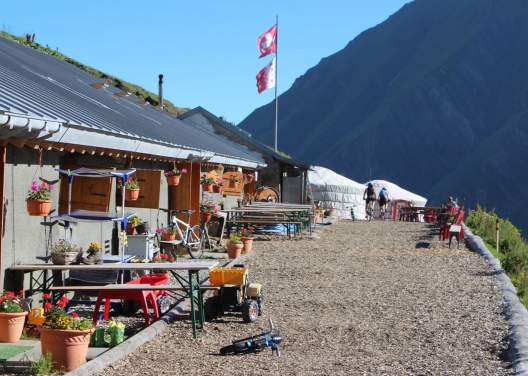
Rifugio Bertone
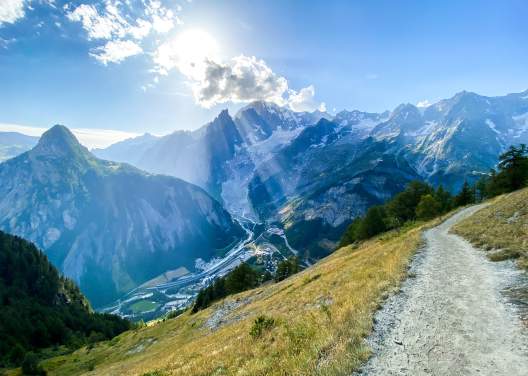
Update on the condition of the trails around Mont Blanc
Summer 2024
Mild weather and pleasant temperatures in this period of mid-june. the snowfields are rapidly …, starting from july 14th and until 30/10/21 it is forbidden to circulate by bicycle (including mtm ….
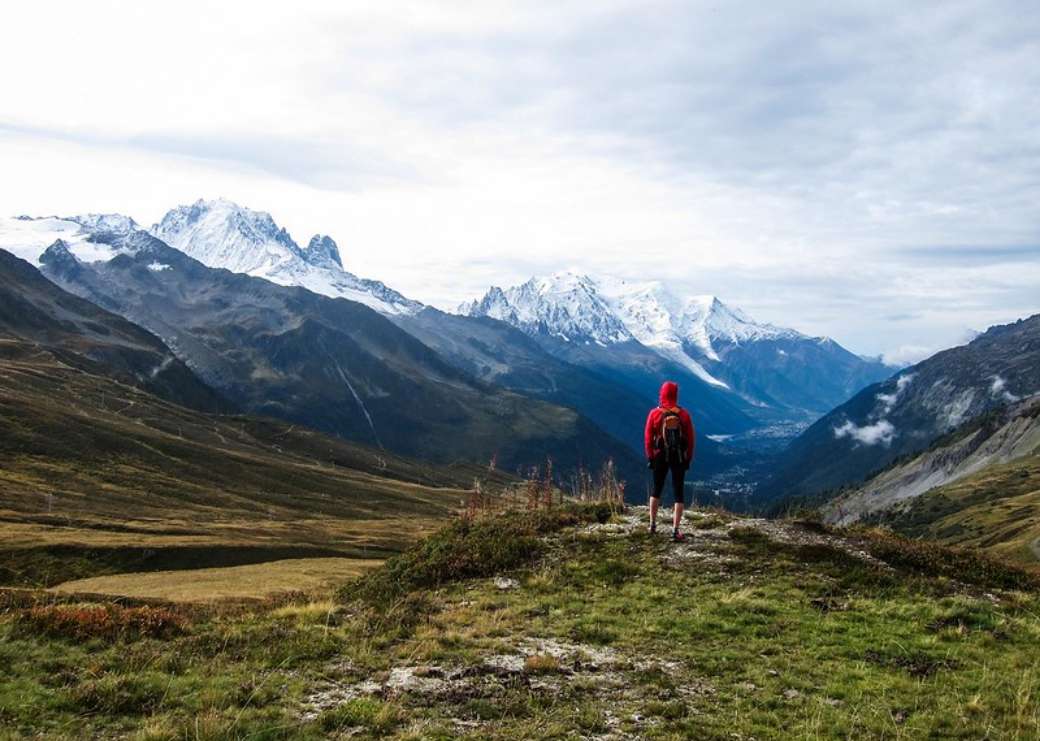
Una bella esperienza ad ovest
Gran bel trekking, non troppo impegnativo (dipende dai tempi e dal passo). Una bella occasione per godere di un panorama incredibile che ad ogni versante regala emozioni nuove. Noi l'abbiamo fatto tranquillamente in 8 giorni in …
Bonjour On vient de terminer le tour du mont blanc en famille avec 3 enfants de 10/11 et 13ans. Les conditions étaient excellentes. Juste un névé au Brevent où on a mis les crampons pour assurer la sécurité des enfants. …
Bonjour Je viens de terminer le TMB . Excellentes conditions météorologiques. 1 jour de pluie et col de balme brouillard et vent Des névés par endroits donc attention : col du bonhomme et brevent.et par ci par la Pour ma…
- Where to stay – Chamonix
- Geneva Airport to Chamonix
- Tour du Mont Blanc public transport
- Itineraries
- Tour du Mont Blanc Refuges
- Refuges ebook

Planning – the first steps

If you’re planning to trek the Tour du Mont Blanc by yourself, with no guide, then this is where to start to plan your TMB adventure. If you’re unsure whether to trek independently self guided, with a tour group or pay for a self guided package, read my Self Guided v Guided post .
Planning your route isn’t as easy as it first looks, unless of course you aim to follow the standard 11 day full circuit itinerary which is laid out for you in all the guide books. Simple.
The 11 day circuit is pretty full on – trekking between 7-9, perhaps even 10 hours a day over terrain that cumulatively equates to the height of Everest! If you’re match fit and have the time then this is the perfect option, perhaps just adding a day in Courmayeur as a rest day and a couple in Chamonix for start/finish days.
If you’re planning to alter the standard 11 day itinerary because of various factors, the planning gets a little more tricky. Perhaps you don’t have two weeks to dedicate to the trail. You might only have a week and want to walk the most scenic stages. Perhaps you don’t want to be on the trail for so long every day, you want to take it slower and absorb the mountains instead of having to slog it out each day. Perhaps you’re worried about your fitness or are hiking with kids, or you’re hiking in your golden years? All these scenarios require you to alter the standard 11 day itinerary and that my friend means a bit more work.
You can, of course, just book your refuges online at the official TMB site . It’s easy to do. You can choose your starting point, the direction you want to hike in and then choose each refuge to build your itinerary. It gives you the approximate length of time for each refuge from your start point, you select your first refuge and then you can choose your next stage, which will take you onto the next set of accommodations/refuges you can book for that step (with the approximate times from where you stayed the previous night).
However, the pitfall of the online system is that some of the refuges aren’t on it so you can’t book your entire circuit in one fell swoop (unless you’re planning on travelling the lower Val Ferret route on the Italian side which we would only suggest in bad weather).
Rifugio Bonatti – the infamous high mountain refuge on the Italian side is private and so is not on the online system. Others such as the most incredibly placed Refuge Lac Blanc are on the system but you can’t book via the online system – you need to contact the refuge directly. There are a number of excellent refuges that are not on the online system so this needs to be considered when trying to make your bookings – know which are private and know that you’ll need to contact them direct – this takes more time to email and get a response back. Some of these private refuges are beginning to build online reservation systems on their websites which is going to make reserving beds a lot easier. Refuge Col de Balme has already done this however it’s not taking reservations bizarrely until March and the word on the street is that Refuge Lac Blanc is currently building theirs to launch January 2024 – watch this space …..
Regardless if you’re hiking the tour self guided independently, and even if you use the online booking system, you’ll still need to piece together your accommodation like a giant puzzle.

Here are our top suggestions to help you plan your own self guided TMB adventure:
1. Get your head around the trail
Read as much as you can, early on, before you even want to think about booking the refuges.
Buy a couple of the guidebooks. Kev Reynold’s Trekking the Tour du Mont Blanc is the most longstanding and popular guidebook, although we love the detailed maps in Trailblazer’s Tour du Mont Blanc by Jim Mathorpe.
There’s also a new guidebook Tour du Mont Blanc by Kingsley Jones released recently which we’re reviewing right now.
If budget isn’t an issue, consider buying a 3D relief map of the Massif du Mont Blanc area to put up in your home while you plan the trail. They cost around €40 online and are invaluable for understanding the elevation aspects of the trail and are, of course, fantastic souvenirs once you’ve completed this epic trail.
2. Decide how long you want to hike each day
You need to think about how long you want to be hiking on the trail each day. Is your aim to complete it in the fastest possible time, or do you want to relax, take in the incredible scenery and enjoy your walking holiday?
How fit are you? What might take some hikers 7 hours to complete, may take 9 hours for others. Expect to be on the trail between 7-9 hours a day if you’re hiking one stage per day which means you’ll be setting off 7.30-8.00h and arriving between 16-17h.
Don’t just look at the kilometres involved in each stage. More seriously you need to take into account the elevation gain (and loss) each day. Always expect it to take longer than you anticipate – sometimes by two hours!
The most common feedback from trekkers after they’ve completed the trail, after raving about the sheer beauty and how incredible it was (!) was that they underestimated the elevation !
I now recommend that you buy a copy of the map by Kingsley Jones in your planning stages – it has a very useful elevation map of the entire 170km trail with very accurate timings for a walker, a trekker, a fast packer and a trail runner. Not only does this map gives you a reality check on the elevations of each day, it also enables you to calculate to a good degree how long each stage will take you.
One way to try to calculate how far you are able to hike each day is to measure your pace. Try timing yourself on a sample hike similar to one of the stages on the Tour du Mont Blanc. Easy if you’ve got some mountains near you. Not so easy if not.
Once you have the Kingsley Jones map you can however time yourself on the first day or two between particular timing points and you’ll get a good idea of whether you’re on his walker or hiker pace. From there you can easily calculate what time you should arrive at the refuge each night for the rest of the trail.
If you want to shorten some of the days on the trail, or skip some sections by taking public transport, there are some great options on my itineraries page .

3. Research the refuges
Decide what kind of TMB experience you want to have when it comes to your accommodation. Are you happy to stay in high altitude huts in rough and ready conditions or do you want a few more home comforts? And know that not all huts were created equal.
The standard of hut when it comes to quality, comfort & welcome varies wildly on the tour. You can still have a high altitude hut experience without it being, well, disappointing. You just need to know which refuges to book!
With this in mind a little research goes a long way and it will affect your daily schedule because you know you want to stay in refuge X,Y and Z but definitely not B.
Our post, Tour du Mont Blanc Refuges – the good, the bad and the ugly will help you identify which refuges to avoid and which to snap up. For much more information on the refuges I’ve now written an 87 page TMB Refuges Ebook which details 24 of the refuges and accommodation on the trail with interior refuge photos, what the rooms look like, what food you can expect as well a full guide on how to book the refuges.

Tour du Mont Blanc Huts – the good, the bad & the ugly
Do yourself a favour and book your Tour du Mont Blanc huts early –…

5 unmissable refuges on the Tour du Mont Blanc
All refuges were not created equal. Make sure not to miss out on one…

Dorm or private room? Your guide to which refuges offer what accommodation
This post will help you decide which TMB refuge accommodation to book, particularly if…
4. Consider public transport options
Unless you’re a TMB purist who would never dream of skipping a stage, know that there are some good reliable transport options on the Tour du Mont Blanc for those of you who might want to drop a section here and there to make the hike shorter, or who just want a back up in case of tiredness.
Perhaps you only want to hike the raw, rugged jagged sections where the landscape is wild and the cols high. In this case if you’re looking to shorten the hike, you might miss some of the Swiss sections with their more serene countryside. Think rolling hills and charming hamlets.
Perhaps you just want back up in case of bad weather – and this is a real possibility so take heed. It is always good to know what plan B is.
5. Acclimatising – days before the hike
Think about your arrival day. Most will arrive into Geneva airport, many from long haul flights. You’ll be tired and your body weary.
Many of you may be coming from sea level so to hit Chamonix which lies at 1035m elevation in itself and then hitting the trail, even the next day might be a lot for your body to take.
If you’re following the traditional anti-clockwise tour then Stage 1 isn’t too much of a of a slog elevation wise, especially if you take the Bellevue cable car up! The highest point on the first day is Col de Voza at 1653m or if you’re thinking of taking the alternative route (only in good weather) the Col de Tricot’s lofty heights top at 1478m).
However, if you’re not too fussed about following the traditional route then consider basing yourself in Chamonix for a couple of days to acclimatise and do a couple of ‘training hikes’ which could actually be on the Tour du Mont Blanc route anyway. For example Stage 10 (Tré-le-Champ – La Flégère) and Stage 11 (La Flégère – Les Houches) can be accessed directly from the Chamonix Valley and you could hike these stages as day hikes with just a light day pack and stay in a Chamonix hotel with all it’s comforts before hitting the main trail.

Further Reading...

The Tour du Mont Blanc’s 11 stages

Trekking the Tour du Mont Blanc in June – early season

Tour du Mont Blanc self guided v guided
Hi Mags, Do you have any information on booking for Cabane du Combal? Ingrid had emailed me nack in early October telling me the website would open on 1/11 however there is some problem with the synchronising of the website so it is still closed for bookings. I have been checking coninually since 1/11 Thanks for any info you may have Vivienne
tourdumontblanchike
Hi Vivienne Cabane Combal is now open online for reservations. They’ve solved the issue.
Leave a Reply Cancel Reply
Save my name, email, and website in this browser for the next time I comment.
This site uses Akismet to reduce spam. Learn how your comment data is processed .
Tour du Mont Blanc Stage 7
Responsible hiking, tour du mont blanc hike, privacy overview.
Tour du Mont Blanc: How to Effortlessly Plan Your Epic Trek For 2024
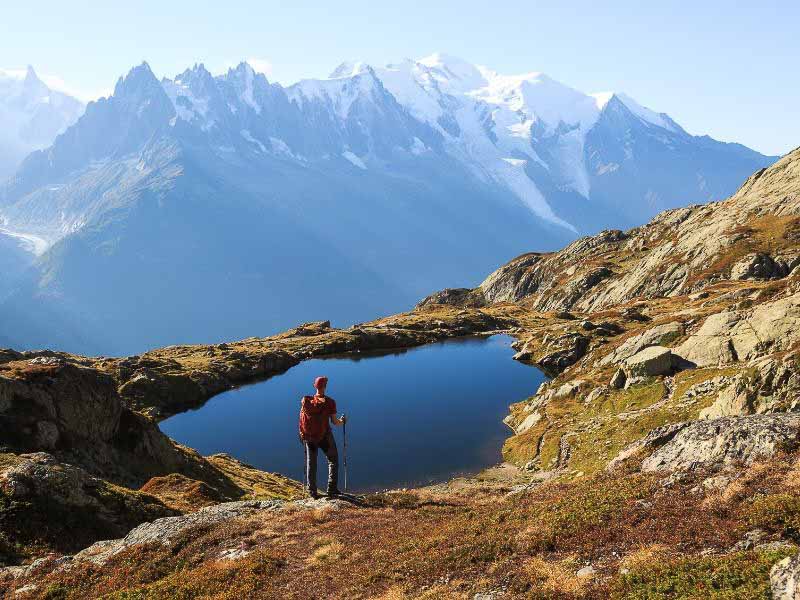
The iconic Tour du Mont Blanc Trek (TMB) is not only one of the most popular hikes in Europe but one of the best treks in the world!
Table of Contents
The 170km (119 miles), 8000m+ (256,247 ft) elevation gain around the Mount Blanc Massif, the highest peak (4810 m) (15,781 ft) in Western Europe, is epic.
You’ll hike the classic route that takes you through the alps in France, Italy and Switzerland.
The TMB is one of the best long-distance hikes in the world and is at the top of many hikers’ bucket list and for good reason. It’s a beautiful hut-to-hut hike where you’ll have a warm bed and a hearty meal waiting for you every night.
Although you don’t go to the actual Mont Blanc Massif itself (that involves mountaineering), it’s still tough and not for beginner hikers .
It will challenge you both physically and mentally, but with a little bit of planning, you can choose how much of a challenge you want.
3 Ways You Can Hike Around the Mont Blanc Massif
1. guided trek.
This is a good option if you want to leave the route-finding to a skilled guide and also want local knowledge. Our French guides will identify wild flowers, point out things you’d never spot on your own.
A guided tour is also a good option if you enjoy the camaraderie of meeting fellow hikers. We arrange guided tours on request if you already have a small group.
Find out more about the difference between guided and self-guided tours .
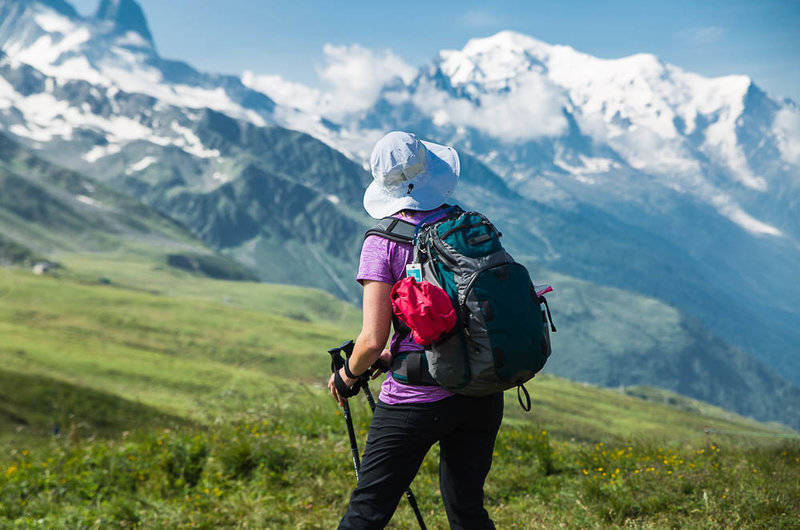
2. Self-Guided Trek
There are also self-guided trek of the Tour du Mont Blanc , in which a tour operator consults with you and makes all the arrangements best suited to your needs and wants. This is one of my favourite ways of doing treks.
You can avoid the mistakes that we did by planning it all ourselves – see below. After booking this tour on my own, I now almost always choose self-guided hikes when hiking in an area that I’m unfamilar with.
Get Your FREE Guide to Hiking the
Tour du Mont Blanc
Get your Tour du Mont Blanc (TMB) Email Guide:
By subscribing your agree to our Privacy Policy . Your email will never be shared and you can unsubscribe at any time.
Because I’m such a big fan, we offer self-guided 6, 7 or 10-day tours. You choose whether you want to stay in huts or private rooms. And we offer luggage transfers if you want to hike with only your day pack.
Self-guided hiking tours are a good option if you want the flexibility of hiking at your own pace and starting when you want to. They’re also a good option if you want to spend quality time with the person(s) you’re hiking with.
Well-marked trails, and a busy route make it unlikely that you’ll get lost. But still, we recommend having GPS tracks so that you’re aware of the optional routes.
We provide an in-person briefing in Chamonix , so that you get your last-minute questions answered and the most up-to-date trail conditions.
Plus, we share our favourite locations, GPS and instructions with shortcuts and alternative routes when available. Butt you still get to figure out a few things on your own.
For example, you choose whether to hike the easier path or more difficult like the ladder sections, which are optional.
I personally love this stuff. But I don’t love researching and booking accommodations in advance and trying to figure out everything on my own from scratch. It’s very time-consuming. I’d rather rely on experts but then have the flexibility of hiking by myself.
Related Reading: The Haute Route: Hiking Tour
3. Hiking It On Your Own
Another alternative is to plan it on your own. It’s the most time-consuming but also the cheapest option, especially if you’re camping. Below you’ll find how to plan your own trek if you’re staying in mountain huts.
Check out our Mont Blanc Hiking Art:
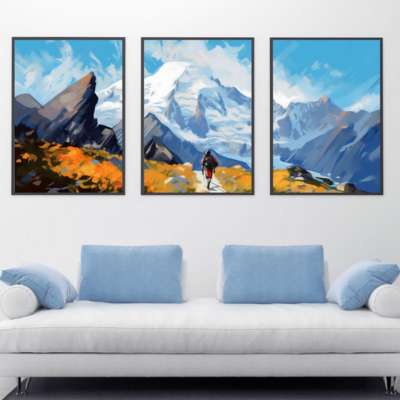
Resources for Planning Your Own Hike
If you choose the do-it-yourself option, I recommend that you plan it using a combination of this site: http://www.autourdumontblanc.com/en/, and the TMB: Complete Two-Way Trekking Guide Book by Cicerone Guides. And of course a good map and GPS tracks.
Check out this video of the Tour du Mont Blanc:
You’re also able to book the huts directly through their site via email. This is, however very time-consuming, and the accommodations often take several days to respond – if they respond at all. Some of them are so busy that it can take them a while to get back to you. On the flip side, it’s the second cheapest option.
The cheapest option for doing the TMB is camping. However, as I didn’t camp, I, unfortunately, can’t offer any advice on that.
Where Does the Tour du Mont Blanc Start and End?
We start our 6 and 7-day tours in the charming village of Les Houches and our 10-day tours start in Chamonix.
All tours end in the Chamonix valley regardless of the length.
TMB Insider Tip: If you start in Les Houches ensure you buy everything you need in Chamonix first. It’s a very small village where only very basic supplies are available. I forgot my iPhone cable and had to go back to Chamonix to get a new one
Choose the Direction you will Trek
The classic Tour du Mont Blanc route is done counter-clockwise. The advantage of doing it this way is that you’ll keep running into the same people. If you want to hike with others, it’s easy enough to meet up.
If you prefer to hike more on your own, then choose to hike it in a clockwise direction, the opposite of how most hikers do it.
You can see a map of the tour here from Wikipedia.
How Long Does it Take to Hike the Tour du Mont Blanc?

Don’t start by saying that you will do the trek in so and so many days. Take a look at the itineraries, distances and m in elevation gain for the self-guided tours , and see whether the 6, 7 or 10-day tour is the best choice for you.
Our 6 and 7-day tours are the easiest (although still not easy). You’ll take public transportation – buses and lifts, skipping the less scenic parts. Our 10-day tour is the most challenging with more hiking and fewer transfers.
We also offer the option of taking a rest day in Courmayeur, which is approximately halfway through the tour.
For a truly epic experience, do our half-day guided glacier tour from Courmayeur, which will take you above the clouds and much closer to Mont Blanc than you get on the trail.
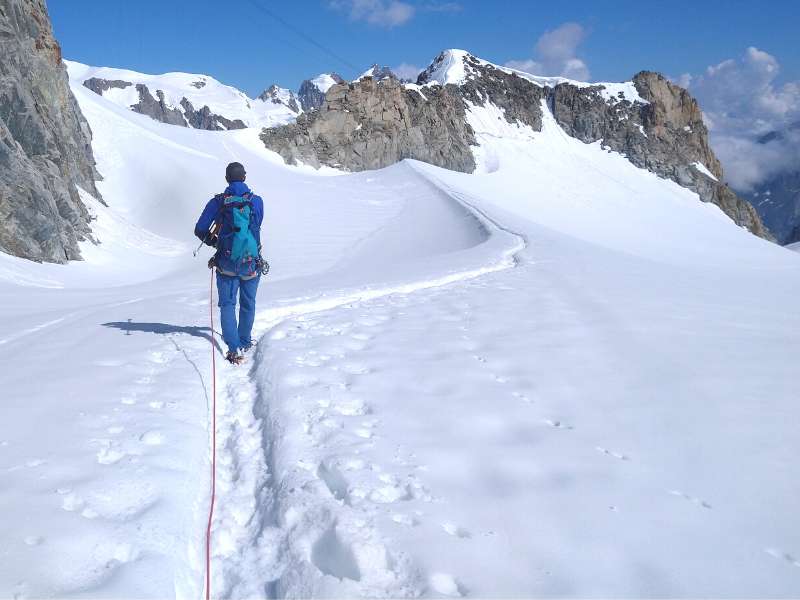
How Difficult is the Tour du Mont Blanc?
That really depends on your fitness and experience level.
If You’re Relatively New to Hiking
If you’re new to hiking and the TMB is your first long-distance hike, it’s a good idea to start with a 6 or 7-day tour because you hike less each day.
The 6 and 7-day tours are a good way to ease into long-distance hiking if you don’t hike regularly but are still in OK shape. Note you need to be active. If you’re not already active, then you’ll find the TMB too difficult.
If You’re a More Experienced Hiker
If you’re in good shape, hike regularly and love a challenge, then the 10-day tour is an excellent choice for you.
Of course, you may be limited by vacation time. In that case, you could still choose a shorter tour, then opt to hike some sections instead of taking the transfer. Or ask us for additional route options at the in-person briefing that we offer. That way, you’ll make it harder.
Many hikers choose to take a rest day (the perfect day to do an epic guided glacier tour ) in the charming Italian village of Courmayeur , which is approximately halfway through the tour.
You can use these guidelines, even if you’re planning on doing it on your own.
Check out this Video of the TMB Tour:
What i didn’t like about booking through the tmb site:, missing info about the tmb.
The disadvantage to the aforementioned TMB site though is that it doesn’t provide the elevation gain, nor the distance. It’s also only possible to book some refuges by phone. And the ones you book by email can be slow (if they bother) responding to you. Some also don’t take reservations until spring. Plus, not all the huts are listed on the site.
TMB Booking Process
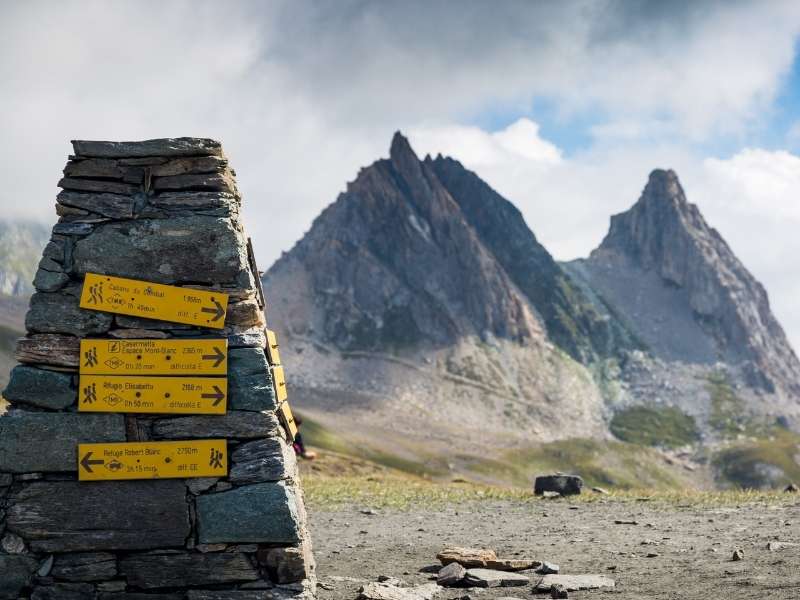
Also, each booking is dependent on the other. I.e. you want to have your reservation secured for Days 1,2, 3 before you book for Day 4. That way you ensure that you don’t have too short a day or too long.
Furthermore, after we confirmed our booking, we were contacted a few days later by two refuges to tell us they were full. As a result, we had to start our bookings from scratch. This happened twice.
It took me hours and hours to plan our TMB adventure, then replan, then re-plan our route again. It’s doable but very time-consuming. It took us approximately 12 hours to book and plan everything. And it was incredibly frustrating.
An Alternative Solution to Organizing Your Epic Trek
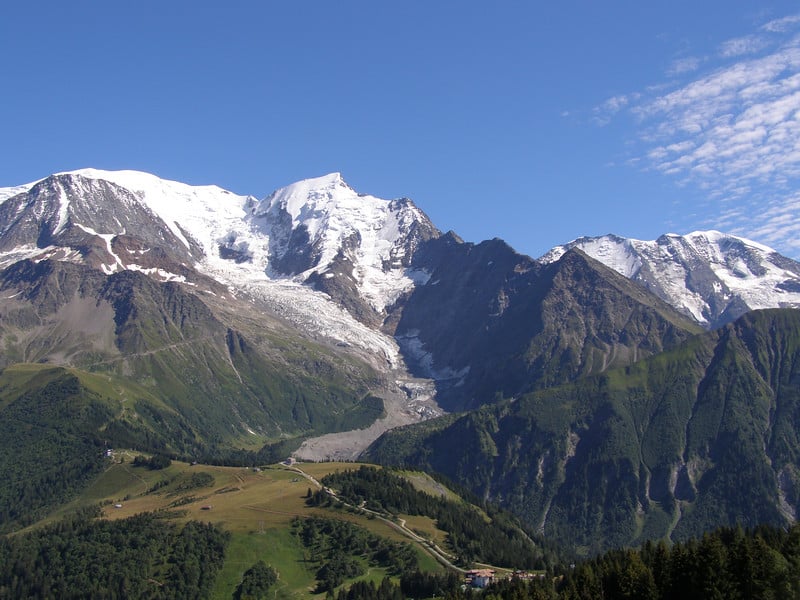
That’s why if you’re short on time, I highly recommend doing a self-guided or guided tour of the Tour du Mont Blanc . You let someone else make all the time-consuming bookings for you. Note: even for us, the bookings are time-consuming.
After planning the TMB on my own the first time doing this once, I wouldn’t do it again. That’s why I started offering tours – to help make it easier for fellow TMB hikers who want to hike without all the hassle. You can see the other hiking tours we offer here.
The Disadvantage of Not Knowing Which Mountain Huts to Book
Lastly, some of the mountain huts/refuges are nice, some less so. We stayed in a four-bedroom at one, which was nice, but the dorm room was awful! The beds were both inches off the floor and from each other. Keeping in mind that you may be sleeping next to a stranger!
There are other refuges not known for their cleanliness or friendliness.
Why I Can’t Tell You Which Huts Not to Stay In
I know you’re curious, and you want the names of the refugios to avoid. However, I’m not able to share this information for two reasons.
1) I’m eager to avoid a lawsuit, which has happened to other publishers who’ve said less than complimentary things about hotels (not specifically for this tour).
That’s another advantage of doing a self-guided or guided tour. We have insider knowledge of which accommodations offer something special – and which ones to avoid!
2) It’s a courtesy to our clients who book their TMB Self-Guided Tour through us and are paying for our expertise.
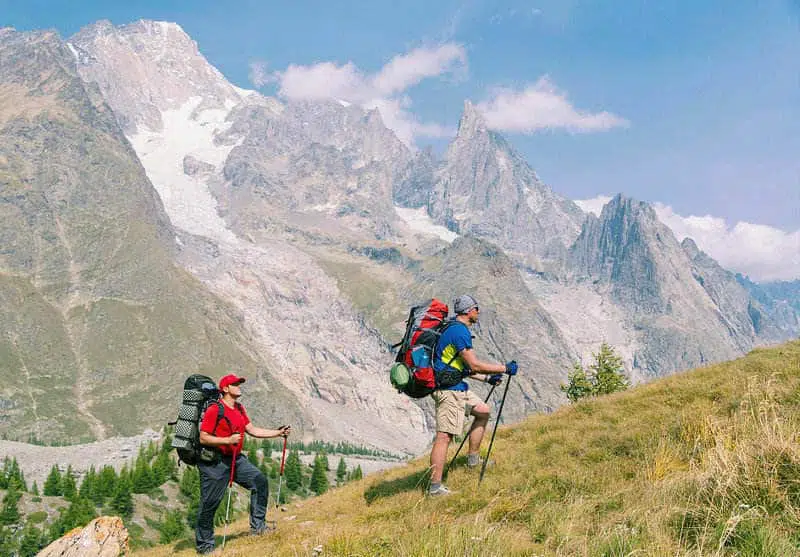
Related Reading: Summer in Chamonix: The 16 Best Things to Do
Highlights of the TMB
Col de Voza : Panoramic views of the Chamonix valley.
- Col de Tricot : Mountain pass offering stunning vistas, known for its challenging zigzag path.
Les Contamines : A charming French village that is a popular stopping point.
Col du Bonhomme : One of the first high mountain passes.
Croix du Bonhomme : Another mountain pass offering panoramic views.
- Col de la Seigne : A high mountain pass at 2,516 meters, marking the border between France and Italy, with panoramic views of the Mont Blanc Massif.
Rifugio Elisabetta : Mountain refuge in Italy, known for its stunning vistas.
Courmayeur : Italian alpine town perfect for a rest day, known for its cuisine and mountain culture.
Grand Col Ferret : The pass that crosses from the Italian Alps to the Swiss Alps offering some of the best views of the Grandes Jorasses.
Champex-Lac : Known as the “Swiss Lake,” a tranquil stopping point in Switzerland.
Bovine Route or Fenêtre d’Arpette : Two alternative routes between Champex and Col de la Forclaz; the former is easier, and the latter offers stunning views but is more challenging.
Col de la Forclaz : Another mountain pass and common place for rest.
Col de Balme : The pass back into France from Switzerland, with amazing views of Mont Blanc.
La Flégère and Lac Blanc : Offers one of the closest views of the Mont Blanc massif, which is sometimes reflected in Lac Blanc
Alternative Routes
On some days of the TMB, you will have the choice of an easier or more challenging route. On these days you choose based on how you’re feeling.
If you’re exhausted or your legs are burning, the best option is to choose the easier route. It’s important to challenge yourself on multi-day hikes without overdoing it. That can easily wreck the rest of your hike .

Weather Conditions
It’s also critical to consider the weather. We had one day that I wanted to do the difficult but incredible Fenêtre d’Arpette (2665m), a splendid pass that’s one of the highlights of the trip.
Unfortunately, the heavy rain made it inadvisable, so we did the easier Bovines Route instead. It’s important to consider safety. Besides, if it’s raining heavily, you won’t be able to see anything.
When you’re hiking in the mountains, it can quickly go from good weather to stormy.
I recommend getting an earlier start and taking a shorter lunch break on days when the forecast is calling for a thunderstorm in the afternoon.
When you hike in June, even late June and in September you’ll be hiking in snow in some places, so you should be comfortable with that.
This past summer was very hot, but then there was also snow at the end of August. You really need to be prepared to hike in all types of weather conditions.
The TMB is well-marked. You’ll mainly be hiking through mountain passes and alpine meadows of wildflowers and lush green valleys. It’s an absolutely beautiful hike.
If you choose the 10-day trek, that often means going up two separate cols/mountain passes in a day. You’ll likely be much slower later on in the day. So don’t count on your usual hiking speed .
There are also two sections that involve ladders. Fortunately, both of these can be avoided with an alternative route.
Should I Get Travel Insurance?

YES! I hope you won’t need it, but mountain rescues are expensive – a minimum of €5000. And they can easily be much more expensive depending on your location and the complexity of the rescue.
I also recommend purchasing Travel and Trip Cancellation Insurance. You usually book your trip and accommodations months in advance, and while each accommodation has its own refund policy most of them aren’t very flexible.
I recommend HeyMondo (get a 5% discount for being a Monkeys and Mountains reader.) because it includes mountain rescue and repatriation insurance which isn’t covered by many other insurance policies. Check out our article on adventure travel insurance for further information.
Also, unlike many insurance policies, it also covers pandemics so if you become ill or unable to travel due to COVID, they’ll cover you. Check out their site for the specific details to see what’s included and what’s not.
Sometimes injuries aren’t life-threatening but if you tear a ligament, fall and break your ankle, you won’t be able to hike down on your own. It’s better to purchase travel insurance (being sure that it includes mountain rescue, and hope that you don’t need it.
How to Pack for the Tour du Mont Blanc
I’ve written a comprehensive post on this indicating every essential item while eliminating those that you don’t need. Check out our TMB Packing List !
Our 8-Day Trekking Schedule
This is NOT a recommendation but is what we did. I’m providing it as many of you have asked for our route. We had some long days, including a 13 1/2 hour one. Again, I wouldn’t recommend what we did.
If you’re looking for recommendations check out our self-guided and guided Tour du Mont Blanc treks . You’ll get an idea for a much better itinerary.
Our start to finish time includes a short lunch stop and breaks. We walked every kilometre and didn’t take any public transportation. Unless you’re trail running, take ten days if you want to do the full circuit.

- Day 1: Chamonix to Refuge Fioux. Start to finish time: 3.5 hours, 14 km
- Day 2: Refuge Fioux to Refuge Nant Borrant: Start to finish time: 9.5 hours, 25 km
- Day 3: Refuge Nant Borrant to Refuge Mottets: Start to finish time: 9.9 hours, 22 km, 1300 m elevation
- Day 4: Refuge Mottets to Refuge Mont Blanco: Start to finish time: 9.8 hours, 17 km, 740 m elevation
- Day 5: Refuge Mont Blanc to Rifugio Bonatti: Start to finish time: 7.1 hours, 21 km, 800 m elevation
- Day 6: Rifugio Bonatti to La Fouly: Start to finish time: 6.5 hours, 18 km, 600 m elevation
- Day 7: La Fouly to Trent: Start to finish time: 13.5 hours, 35 km, 800 m elevation
- Day 8: Trient to Chamonix: Start to finish time: 10 hours, 25 km, 900 m elevation

Eating with Dietary Issues at the TMB Mountain Huts
Most mountain huts will offer a choice of two meals, a regular one and a vegetarian one.
If you have have other dietary requirements, such as being vegan or celiac as I am, there are creative ways to get around this, by suggesting alternatives that are easy for the accommodations to accommodate. You’ll also want to bring plenty of hiking snacks to supplement the food being offered. We have a lot of clients with food allergies who are still able to do the TMB hike.
Breakfast on the TMB
A typical breakfast is toast with some butter or jam. None of the refuges had gluten-free bread. Instead, I requested a piece of fruit.
The breakfasts in the rifugios are very light so if you like to eat a big breakfast I recommend bringing some energy bars with you.
Lunch on the TMB
We ordered lunches to go the night before from each hut. Despite being informed ahead of time, lunch was usually sandwiches which I couldn’t eat. Three or four apples were substituted for the sandwiches. Again, bring your own hiking snacks if you have dietary issues. Otherwise, you’ll be fine.
To Reserve or Not to Reserve Refuges in Advance?
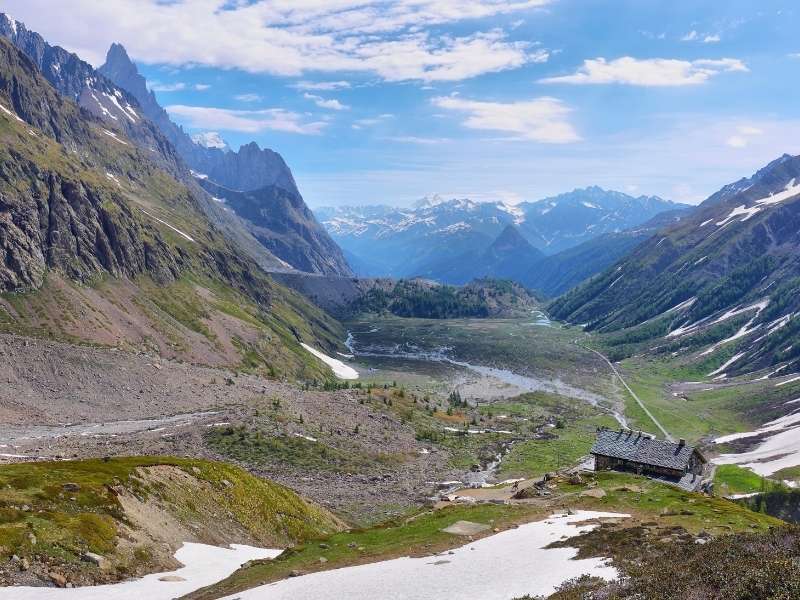
I highly recommend booking your tour or accommodations in advance because the TMB has become so busy.
In 2023, many mountain huts were already full in January. And by mid-February, we had to stop selling some tours because key accommodations were full.
TMB Insider tip: If you don’t have reservations for a mountain hut, then try to get an early start and arrive early. That way, you may get a spot before it does come full. But given how full the accommodations are, you should be prepared to camp if you don’t have a reservation.
What Are the Accommodations Like?
The mountain huts/refugios are a luxury in the mountain but VERY simple by normal accommodation standards.
Dormitory accommodations vary anywhere from 4 to 40+ beds. I’d recommend avoiding anything with more than 20 beds wherever possible. (We don’t book these for our clients as we don’t think it provides a good experience).
Some refugios offer double private rooms. These will also be very simple, and you’ll still share a bathroom as the refugios usually have two bathrooms, one for women and one for men.
When you stay in a refugio, you’ll need to bring a sleeping bag liner. They’ll provide blankets and a pillow, so don’t worry about being warm enough.
A mid-option is booking private double accommodation. With this option, you’ll get a mix of sleeping in refugios and simple guest houses where you’ll have your own bathroom some nights.
If you’re looking for luxury, then you’ll want to book the 6-day luxury tour , which includes nice accommodations than staying in mountain huts. On this tour, you’ll have your own private bathroom every night except for one.
While the refugios aren’t luxurious, they’re often in a gorgeous setting. It’s also a great way to experience local culture and mix with other hikers from around the world. It’s truly an authentic experience.
Pamper Yourself at the Beginning and End of Your Trek

We stayed at Boutique Hôtel Le Morgane on the last day of our trek. It’s a four-star eco-hotel in Chamonix, complete with a spa!
After staying in refuges, it was pure bliss. We sat on our huge patio, enjoying the amazing views of Mont Blanc, as we rested our blistered, aching feet. Trust me, on the final day; you’ll likely be tired, so it’s worth a bit of a splurge!
Pre and post-tour accommodation isn’t included, so check out our guide to the best accommodations in Chamonix to find out where to stay.
End Your TMB With a Once-in-a-Lifetime Mont Blanc Glacier Walk or Chamonix Via Ferrata
For a truly memorable end, embark on an extraordinary high-mountain adventure that takes you high above the Tour du Mont Blanc to explore the mesmerizing Mont Blanc glaciers , which takes you above the clouds on our private guided glacier tour.
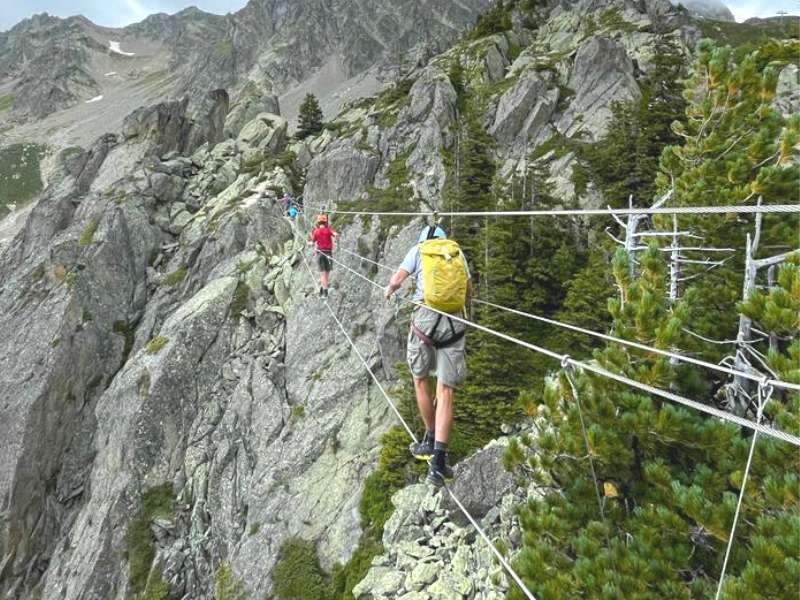
Or, do our guided Chamonix Via Ferrata tour , which combines hiking and rock climbing for an adrenaline-packed adventure. It’s totally safe, and your guide will help you along the route.
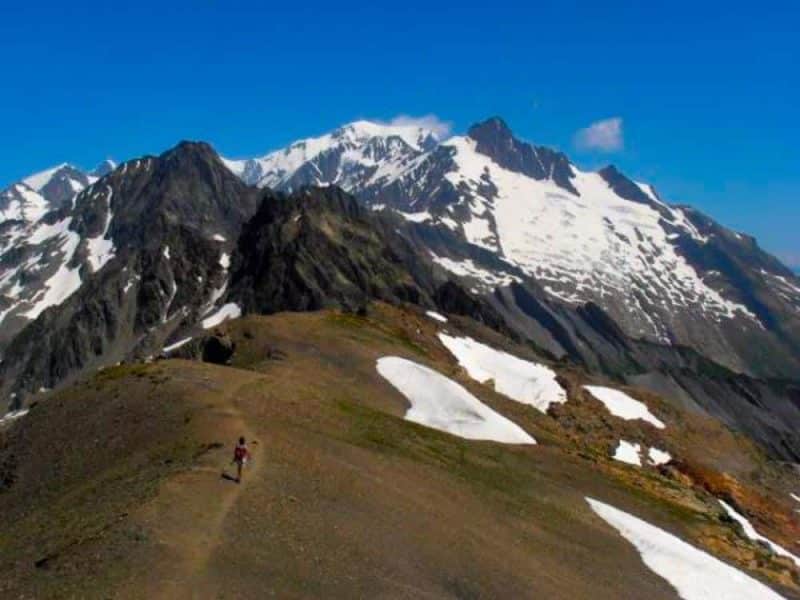
The Closest Airport to Chamonix
The closest airport is Genevan Airport. You’ll find great deals on Skyscanner.
Getting from Geneva to Chamonix

The easiest way to get to Chamonix, the start of the TMB is with a shared shuttle which takes ~90 minutes and needs to be booked in advance. Do a Google search for “transfer from Geneva to Chamonix,” and you’ll see lots of different options.
Or take this private transfer from Geneva Airport which starts from €29.97.
Read our guide: Getting from Geneva to Chamonix for more information.
I also recommend spending a day in Geneva if your schedule permits.

Related Reading: 10 Best Things to Do in Geneva, Switzerland, When You Only Have a Day
Tour du Mont Blanc FAQs
Is the tour du mont blanc worth it.
Absolutely! I enjoyed most of it. I don’t believe anyone who says they enjoyed every second of the TMB. There are some tough parts! Even better, it left me a lasting gift that is still giving. The gift of personal strength, both on and off the mountain. Little did I know that it would start an obsession with long-distance hiking. I now do at least one long-distance hike each year. Check out How a Hiking Trip Can Change Your Life .
Is the Tour du Mont Blanc crowded?
It’s getting busier every year. The busiest times tend to be the first week in July and the last week in August when the TMB ultra are held. Having said that, while it’s a bit crowded at the start of each day with hikers leaving at around the same time, it starts to thin out pretty quickly as everyone hikes at a different pace. I recommend booking as early as possible so that you can start on your preferred date. Avoid doing it the last week in August as it’s very crowded then.
How technical is the Tour du Mont Blanc?
It’s not a technical hike, but it is physically demanding. You’ll be hiking on a mixture of paths and rugged terrain, but no technical skills are required. Having said that, avoid doing it in June if you’re not comfortable hiking in snow.
How many miles/km is the Tour du Mont Blanc?
It’s 106 miles or 170km.
Is it possible to hike the Tour du Mont Blanc in June?
Yes, it’s possible from mid-June, but I think late June is a safer bet since the amount of snow varies each year. Having said that, some years the high passes aren’t possible at the end of June either due to too much snow. If you don’t want to hike in snow, then book mid-July-mid-August.
When’s the best time to hike the Tour du Mont Blanc?
It’s possible to do it from mid-June to mid-September but I think the best time is July and August because you’ll likely be able to do all the high passes – which isn’t always possible due to too much snow earlier in the season. Plus, all the transfers are running, which makes it cheaper than having to book private transfers if you’re doing the 6 or 7-day tour .
When is the TMB Ultramarathon?
There are a series of 7 races usually held from ~ Aug 22nd to 28th (depending on the year). Hikers should avoid going during this time as it’s very busy.
What are the best tips for doing the Tour du Mont Blanc?
I think the two big factors to consider are 1) What type of accommodations do you want? Luxury, private double or dormitory? and 2) How challenging do you want to make it? Then, design your trip around these factors as outlined in this article.
What should I bring on the Tour du Mont Blanc?
See our packing list , which also includes my favourite small luxury item that I bring on every trek.
Will I get altitude sickness?
The highest point on the TMB is the Fenêtre d’Arpette (2,665 meters (8,743 feet). Anything below 3,000 meters is usually too low to cause altitude sickness for most hikers.
The TMB is not a high altitude trail so doesn’t pose the challenges that some other famous treks do.
The Tour du Mont Blanc is one of the best treks in the world and is one of the most memorable trips you can do. Will this be the year that you check it off your bucket list?
Related Reading: Alta Via 1 Hiking Tour (Self-Guided)

Tour du Mont Blanc
By subscribing you agree to our Privacy Policy. Your email will never be shared and you can unsubscribe at any time.
Sending email...
Email sent!
You are using an out of date browser and this website will not function properly.
Please upgrade to Edge or Chrome browsers.

+33 (0)781586903
montblanctreks
- Dates & Prices
To win an 8-day guided trek in the Atlas Mountains, ENTER HERE!
The Tour du Mont Blanc
Guided & self guided trekking holidays.

Experience one of the world’s most spectacular classic treks and join Mont Blanc Treks this summer, with our great range of professionally guided and self-guided trekking holidays.
The Tour du Mont Blanc features in the World’s top ten 'must do' treks and it's not hard to understand why, as this trek is outstanding with amazing views day after day. The full circuit takes you on a 170 km journey around the Mont Blanc mountain range accumulating 10,000m of height gain and descent. You will trek through three alpine regions within France, Italy and Switzerland, circumnavigating the mighty Mont Blanc which stands at 4810m.
The route is generally done in an anticlockwise direction starting and finishing in Chamonix. Having trekked the route many times, we have put together a selection of guided and self guided treks that we feel work well. The full circuit will take you 10 days and journeys through the most stunning environment day after day. For those who don't quite have the time to devote to the full circuit we have the 'Best of', a six day trek which focuses on the highlights. We also offer the Westerly section from Chamonix to Courmayeur or Easterly section from Courmayeur to Chamonix. If you prefer to be self guided, all our treks can be tailor-made to suit your needs with changes to the route and additional rest days.
See our Video and Photo Gallery for day by day visual information of the terrain and the views you will encounter. Get in touch for further information, we would love to share our passion and wealth of knowledge with you.
Our Trek Packages
Full Guided Trek
- 12 nights, 10 days trekking
- UIMLA guided trek
- 165k classic trek through France Italy & Switzerland
- Full circuit touring the ‘Mont Blanc Massif’
- Good quality accommodation
- Bag transfer included
- Rest day in Courmayeur
- Trekking in the shadow of Europe's highest mountain
Westerly Guided Trek
- 6 nights, 4 days trekking
- 65k westerly section
- Chamonix to Courmayeur
- 1 day to explore Courmayeur & Chamonix
- Breathtaking mountains views and pretty alpine villages
- Add in additional days
Easterly Guided Trek
- 7 nights, 6 days trekking
- 100k trek the easterly through Italy, Switzerland and France
- Courmayeur to Chamonix
- Spectacular alpine flora and fauna
- Stunning alpine scenery
- Add in additional days in Courmayeur or Chamonix if required
Full Self-Guided Trek
- 11 nights, 10 days trekking
- 165k full circuit starting & finishing in Chamonix
- Self-Guided Trek trek
- Hassle free independent trekking
- Flexible start date to suit you
- Maps, route cards, guide book & expert advice
- Option to select daily route using traditional Tour du Mont Blanc or variants
- Add additional days or tailor made to suit you
Best Of Self-Guided Trek
- 110k shortened 'Best of' Tour starting and finishing in Chamonix
- Maps, route cards, guide book and expert advice
Westerly Self-Guided Trek
- 65k from Classic trek from Chamonix to Courmayeur
- 1 free day to explore Courmayeur & Chamonix
- Add additional days or tailor made
Easterly Self-Guided Trek
- 100k classic trek from Courmayeur to Chamonix
Full Refuges Self-Guided
- 12 nights, 11 days trekking
- 165k full circuit from Chamonix to Chamonix
- Dormitory accommodation in refuges & hotels
Best Of Refuges Self-Guided
- 7 nights, 6 day trekking
- 110k shortened 'Best of' Tour starting & finishing in Chamonix
Photo Galleries
Tour du mont blanc, tour du mont blanc accommodation, alpine flora and fauna, looking back on summer 2023, trekking footwear, 2022 competition winner suzanne's diary, sign up to our newsletter, marketing permissions.
Mont Blanc Treks will use the information you provide on this form to be in touch with you and to provide updates and marketing. Please let us know if you are happy to receive emails from us by checking the box below.
You can change your mind at any time by clicking the unsubscribe link in the footer of any email you receive from us, or by contacting us at [email protected]. We will treat your information with respect. For more information about our privacy practices please visit our website. By clicking below, you agree that we may process your information in accordance with these terms.
We use Mailchimp as our marketing platform. By clicking below to subscribe, you acknowledge that your information will be transferred to Mailchimp for processing. Learn more about Mailchimp's privacy practices here.

Everything You Need To Know About Hiking The Tour du Mont Blanc
A s an avid hiker, you’ve probably heard of the Tour du Mont Blanc or TMB hiking trail. You might even have plans to conquer this popular hiking destination one day. If so, here’s everything you need to know before you go.
In 1760, a Swiss Geologist and physicist, Horace-Bénédict de Saussure, then living in Geneva, discovered the TMB hiking trail. Saussure wanted to explore the Mont du Blanc Mountains to examine and document plant specimens. Also called the Mont Blanc massif, the mountain range is 60 miles by 20 miles long, with 11 summits over 4,000 meters high. Though he discovered it in 1760, Saussure first walked around the entire TMB hiking path in 1767.
Unfortunately, the Swiss scientist failed to climb one of its peaks on that initial journey around the path. The first to achieve this feat were Michel Paccard and Jacques Balmat. The two found a path to the apex in 1786 through the Grands Mulets route. Sausurre became the third person to reach the summit shortly thereafter.
Trail Overview
Though Pacard and Balmat first reached the peak of the Mont Blanc massif via the Grands Mulets route, the Gouter route is today’s standard path. This trail is 105 miles long and passes through 3 countries: France, Italy, and Switzerland . The Gouter Route (also known as the Voie Des Cristalliers and Voie Royale) is one of the two most commonly utilized routes to reach the summit of Mont Blanc in the Alps. Though the Gouter route reaches an elevation of 15,774 ft, it is considered the most straightforward ascent. The route lies on the north side of the mountain, in France, seeing thousands of mountaineers annually.
The Tour du Mont Blanc difficulty level is somewhat subjective to the hiker. The Gouter route is relatively easy because it takes about two days to reach the ascent and does not require extensive technical skills. Nonetheless, it is physically demanding and mentally challenging if you lack athletic ability. The most difficult aspect of this route includes a narrow passageway of unstable rocks on the mountain’s edge. Seventy-four have died, and 180 were injured in accidents along this dangerous segment between 1990 and 2011.
Once passing this tricky part, the Gouter route is smooth sailing. It steadily increases in steepness while crossing exposed terrain. Hazardous weather conditions are the most dangerous aspects that remain. Cold and wet conditions can cause hypothermia and frostbite. Therefore, visiting the Tour du Mont Blanc for Summer hiking, Mid-June to mid-September, is safest. During the summer, temperatures will range from 40 degrees at night to 80 degrees during the day. Some days require shorts beneath a warm, sunny sky ; others might entail brisk, wet conditions.
Permits And Regulations
No permits are required for the TMB and there are no regulatory restrictions. However, some believe a technical skills test could reduce deaths and injuries along the path. Additionally, residents are disturbed by the amount of trash that hikers inevitably abandon to lighten their loads on the ascent. What’s interesting about the Tour du Mont Blanc is that there are many comforts along the path in the form of hotels and huts. Several companies offer self-guided packages that include accommodations, detailed hiking guides, and set itineraries.
Trail Highlights And Points Of Interest
The Tour du Mont Blanc hike is considered one of the world’s top ten “bucket list” hiking trails. In addition to the soothing sounds of waterfalls , there are glaciers, streams, high alpine meadows, and the natural beauty of the Mont Blanc landscape. Among the most beautiful and visible flora are the rare Slipper Orchid, the Martagon Lily, Aquilegia Alpha, the famous Edelweiss, and rare Campanula thyrsoides. Though heavily impacted by human presence, the animals that remain in the wilderness of the Mont Blanc massif include Marmots, Ravens, Goats, Mountain Hares, Vultures, and Eagles, among others.
Safety Considerations
On the Tour du Mont Blanc hiking trail, the most important considerations will be comfortable shoes and a good quality backpack with appropriate dimensions and weight. What qualifies as an appropriately sized bag will depend on whether you stick to hiking the trail or detour slightly to local huts and hotels. The former will require a 60L bag, and the latter will require a 30L bag. Remember to break in your footwear a few months in advance and buy shoes larger than usual to accommodate swollen, achy feet. Trekking poles will help lessen aches and pains experienced in the knee and leg muscles. Hiking crampons are a “better safe than sorry” item to add to your Tour du Mont Blanc packing list. They will help maintain balance and avoid slipping across waterways and snow patches, which might even save a life!
In case of an emergency, administer first aid, note location and grid reference on a map, call for help (cell phone service is generally available along the TMB). If no phone is available, blow a whistle or flash a flashlight six times. If there is an injured person, carefully consider whether to go for help or stay with the injured. If the injured party stays behind, leave them with food, water, and warm clothes.
Planning and Preparation
Being physically prepared for the TMB hike is a necessary safety precaution. Training should start at least three months in advance and should be in layered clothing, hiking boots, and a fully packed backpack to best simulate trail conditions. Other things that require planning include booking accommodations along the trail and deciding how many days to stay. An itinerary will vary depending on whether two days, two weeks, or even two months are set aside to experience the beauty of TMB.
Most hikers can ascend the Tour du Mont Blanc self-guided if interested. The trail is easy to follow, with well-maintained paths, directional markings, and clearly understood signs. However, map reading skills are essential, and hikers should also carry a guidebook.
People Ask: Hiking the Tour du Mont Blanc
Q: What is the Tour du Mont Blanc hiking trail?
A: The Tour du Mont Blanc is a 170-kilometer hiking trail that circles the Mont Blanc massif in the Alps, passing through France, Italy, and Switzerland.
Q: How long does it take to complete the Tour du Mont Blanc?
A: The entire trail takes about 10 to 12 days to complete.
Q: What is the best time of year to hike the Tour du Mont Blanc?
A: The best time to hike the Tour du Mont Blanc is from mid June to mid September, when the weather is typically mild and the trails are clear of snow.
Q: Are there any accommodations along the trail?
A: Yes, there are many accommodations available along the Tour du Mont Blanc, including hotels, hostels, and mountain huts.
Q: Is it necessary to hire a guide for the hike?
A: No, it is not necessary to hire a guide for the hike. The trail is well-marked and there are many resources available for hikers.
Q: How difficult is the hike?
A: The hike is considered to be moderately difficult, with some steep ascents and descents.
Q: What should I pack for the hike?
A:You should pack appropriate hiking gear, including sturdy boots, warm clothing, and rain gear. You should also bring a map, a compass, and plenty of water and snacks.
Q: Are there any safety concerns I should be aware of?
A: Yes, there are some safety concerns to be aware of, including potential hazards such as steep drops, loose rocks, and unpredictable weather. It is important to stay on the marked trail and to be prepared for changing conditions.
Q: Can I hike the trail in sections?
A: Yes, it is possible to hike the Tour du Mont Blanc in sections, with many hikers choosing to focus on one or two sections at a time.
Q: What are some of the highlights of the hike?
A: Some highlights of the Tour du Mont Blanc include stunning views of the Alps, charming mountain villages, and the opportunity to experience the unique cultures of France, Italy, and Switzerland.
The Tour du Mont Blanc is a renowned hiking trail accommodating hikers from across the globe. It is mentally and physically challenging, but efforts will be rewarded with breathtaking views along the route. The TMB is accessible with or without a guided tour, as there is food, water, emergency services, accommodations, and other modern amenities along the path. With a reasonable amount of advanced preparation, physical training, thoughtful packing, and a conscientious “Leave no trace” mindset, this unforgettable journey is worth experiencing for yourself.

Compagnie du Mont-Blanc
Top ways to experience montenvers - mer de glace train and nearby attractions.

Most Recent: Reviews ordered by most recent publish date in descending order.
Detailed Reviews: Reviews ordered by recency and descriptiveness of user-identified themes such as wait time, length of visit, general tips, and location information.

Also popular with travelers

Compagnie du Mont-Blanc - All You Need to Know BEFORE You Go (2024)

IMAGES
VIDEO
COMMENTS
The Tour du Mont Blanc (TMB) is a captivating multi-day hike that circuits the Mont Blanc massif in usually 10-11 days, passing through France, Italy and Switzerland. The main Tour du Mont Blanc route is 170 km (105 miles) long and involves 10,080 meters (33,071 feet) of elevation gain and loss. The Mont Blanc mountain range takes its name from ...
It's worth noting that each 'stage' is LONG averaging between 13-20km per day over challenging terrain, expect between 700m up to 1000m elevation gain each day! Covering the entire Tour du Mont Blanc in 11 days is no walk in the park - expect to be on the trail between 7-9 hours per day.
Ascent: 730m up/ 1300m down. You'll start in Les Houches, a small town at the entrance to the Chamonix Valley. Take the Bellevue cable car up to 1800m and enjoy the panoramic views. You should be able to see Mont Blanc, the Chamonix Aiguilles, the Aiguilles Rouges and the Chaine des Aravis.
Where to Start the Tour du Mont Blanc. It is a loop trek so technically you can start anywhere along the circuit. However, the traditional starting point is Chamonix, France. Other popular starting points are Courmayeur, Italy or Champex-Lac, Switzerland. If you are starting in Chamonix or any of the Swiss towns, the best place to fly to is ...
13) Important Resources for the Tour Du Mont Blanc Helpful Sites for DIY Planners Autour Mont Blanc is a one-stop online planning site, with links to key huts and other services along the way.
The Tour du Mont Blanc covers a distance of roughly 170 kilometres and gains more than 10,000 meters of altitude over 11 stages. Most people start their hike in Les Houches, France going in an anti-clockwise direction. During this trek you will hike in the French, Italian and Swiss Alps and spend the night in mountain huts.
The Tour du Mont Blanc trail, starting in Chamonix in the French Alps, is broken up into 11 stages that folks can tackle any which way they want. Whilst the entire circuit takes 10-11 days, the flexibility of having numerous start points on the trail enables hikers to enjoy the trail for any number of days from just a one day hike, a long ...
The Tour du Mont Blanc (TMB) is a 170 km trek that encompasses the whole of the Mont Blanc Massif; with nearly 10 000m of cumulative descent and ascent it is usually completed in a number of days. ... Hiking the Tour of Mont Blanc - hiker. Start with the previously mentioned itinerary and break up the days a bit depending on where you would ...
The Tour Mont Blanc easterly trek starts in Courmayeur and takes in half of the classic route anti-clockwise to Chamonix. It is a 6 day trek that covers approximately 100 kilometers through the Italian, Swiss and French alps. This walking holiday in the alps is ideal for those wanting to experience the Tour du Mont Blanc in a shorter period of ...
The Tour du Mont Blanc (TMB) is a 170-km trek that circles the Mont Blanc massif. The route is traditionally walked in the anti-clockwise direction over 11-stages. The TMB starts and finishes in the French village of Les Houches, which sits adjacent to the popular mountain town of Chamonix.
The Tour du Mont Blanc is a 168 km (104 mile) trail that goes around the Mont Blanc Massif and has a total height gain and loss of 32,000 feet (10,000m) depending on the variants you choose…that's the equivalent of climbing Mount Everest (without the high altitude of course). Mont Blanc isn't solitary. It's surrounded by a breathtaking ...
The Tour du Mont Blanc, or the TMB, is a 105-mile (170 km) trail that circumnavigates Mont Blanc, the highest peak in Europe. The TMB is often considered one of the most beautiful through-hikes in the world, introducing hikers from around the globe to the exquisite and dramatic scenery of the Alps.
Bare facts. The Tour du Mont Blanc is a walking trail in the French, Italian and Swiss Alps making a 180km (112 miles) circuit of Mont Blanc, starting and finishing in Les Houches near Chamonix. The highest point reached by the standard route is 2,584m (8,478ft) and the height gain (and therefore loss) around the whole Tour is around 10,600m ...
Based in Chamonix in the French Alps, I'm lucky to live at the foot of Mont Blanc -the start/finish of the famous multi day trekking route - the Tour du Mont Blanc. Five years ago I hiked the TMB with my 10 year old girl and 65 year Mother & fell in love with this incredible hut to hut trek through France, Italy & Switzerland.
The Tour du Mont Blanc or TMB is one of the most popular long-distance walks in Europe. It circles the Mont Blanc massif, covering a distance of roughly 165 kilometres (103 mi) with 10 kilometres (6.2 mi) of ascent/descent and passing through parts of Switzerland, Italy and France. It is considered one of the classic long-distance hiking trails ...
Tour du Mont Blanc from Les Houches in 12 days. This is the traditional 12 day, anti-clockwise route starting at the village of Les Houches, in the Chamonix Valley, just 6km from the town of Chamonix. The alpine arcadia that lies ahead hits you as soon as you arrive, and your walking holiday gets off to a gentle start, taking a cable car up to ...
Vistas around the Tour du Mont Blanc are superlative and, with a lung-busting 10,251m (33,631ft) meters of ascent, they will, quite literally, take your breath away. ... You can start and end ...
The Tour du Mont Blanc is a popular hiking trail in Europe that stretches 170 kilometers (106 miles), through France, Italy, and Switzerland. ... trail is 2,665 meters (8,700 feet). Since altitude sickness can kick in at about 8,000 feet (2,400 meters), you may start to feel sick at some of the higher points. Altitude changes can make things a ...
Welcome to the Tour du Mont Blanc (TMB) 3 countries, one identity, 10,000 m in altitude and about 60 hours of walking, 170 km of discovery for a total of 10 days of satisfaction!
Hey I'm Mags. Based in Chamonix in the French Alps, I'm lucky to live at the foot of Mont Blanc -the start/finish of the famous multi day trekking route - the Tour du Mont Blanc. Five years ago I hiked the TMB with my 10 year old girl and 65 year Mother & fell in love with this incredible hut to hut trek through France, Italy & Switzerland.
Day 3: Refuge Nant Borrant to Refuge Mottets: Start to finish time: 9.9 hours, 22 km, 1300 m elevation. Day 4: Refuge Mottets to Refuge Mont Blanco: Start to finish time: 9.8 hours, 17 km, 740 m elevation. Day 5: Refuge Mont Blanc to Rifugio Bonatti: Start to finish time: 7.1 hours, 21 km, 800 ...
The full circuit takes you on a 170 km journey around the Mont Blanc mountain range accumulating 10,000m of height gain and descent. You will trek through three alpine regions within France, Italy and Switzerland, circumnavigating the mighty Mont Blanc which stands at 4810m. The route is generally done in an anticlockwise direction starting and ...
Also called the Mont Blanc massif, the mountain range is 60 miles by 20 miles long, with 11 summits over 4,000 meters high. Though he discovered it in 1760, Saussure first walked around the entire ...
Compagnie du Mont-Blanc. Enjoy history and glaciology It takes about twenty minutes to climb the 1,000 metres up to the Montenvers-Mer de Glace attraction. Simply hop on board the famous little red railway train. Time will stand still, and you'll enjoy this vintage method of transport. The track climbs the mountainside, running through the ...
Assessing what to do when bridges aren't yet installed during early season hiking on the Tour du Mont Blanc : Torrente d'Arminaz between Rifugio Bertone and Rifugio Bonatti on June 3, 2024 Turn on...